Kalaallit Nunaat
- Home
- Letters from Kalaallit Nunaat
- Prólogo y Créditos / Prologue & Acknowledgements
- Bienvenidos a Groenlandia / Welcome to Greenland
- Qassiarsuq, Valle de las Mil Flores. Narsaq / Qassiarsuk, One Thousand Flowers Valley & Narsaq
- Uunartoq , Tasiusaq y Tasermiut / Uunartoq Hot Springs, Tasiusaq & Tasermiut
- Nanortalik y Qaqortoq / Nanortalik & Qaqortoq
- Qalerallit Campamento de Hielo / Qalerallit Ice Camp
- Igaliku Garðar y Brattahlið-Glaciar Qooqqup / Igaliku Garðar & Brattahlið-Qooqqup Glacier
El calentamiento global es un hecho innegable. Durante los últimos años somos testigos de los cambios en la temperatura del planeta
y pese a que la comunidad científica ha dado la voz de alarma los gobiernos siguen sin reconocer sus responsabilidades.
Se espera que el calentamiento sea mayor en la tierra que en los océanos y el más acentuado ocurra en el Ártico, con el continuo retroceso de los glaciares,
el permafrost y la banquisa. Otros efectos probables incluyen fenómenos meteorológicos extremos más frecuentes, tales como olas de calor, sequías,
lluvias torrenciales y fuertes nevadas, acidificación del océano y extinción de especies debido a regímenes de temperatura cambiantes.
Entre sus impactos humanos significativos se incluye la amenaza a la seguridad alimentaria por la disminución del rendimiento de las cosechas
y la pérdida de hábitat por inundación. Debido a que el sistema climático tiene una gran inercia y los gases de efecto invernadero continuarán
en la atmósfera por largo tiempo, muchos de estos efectos persistirán no solo durante décadas o siglos, sino por decenas de miles de años.
Para los físicos es de vital importancia vigilar el comportamiento del hielo ártico. Esta es la narración de un viaje de descubrimiento,
desarrollado en septiembre de 2017 y de la constatación de las pruebas definitivas del calentamiento.
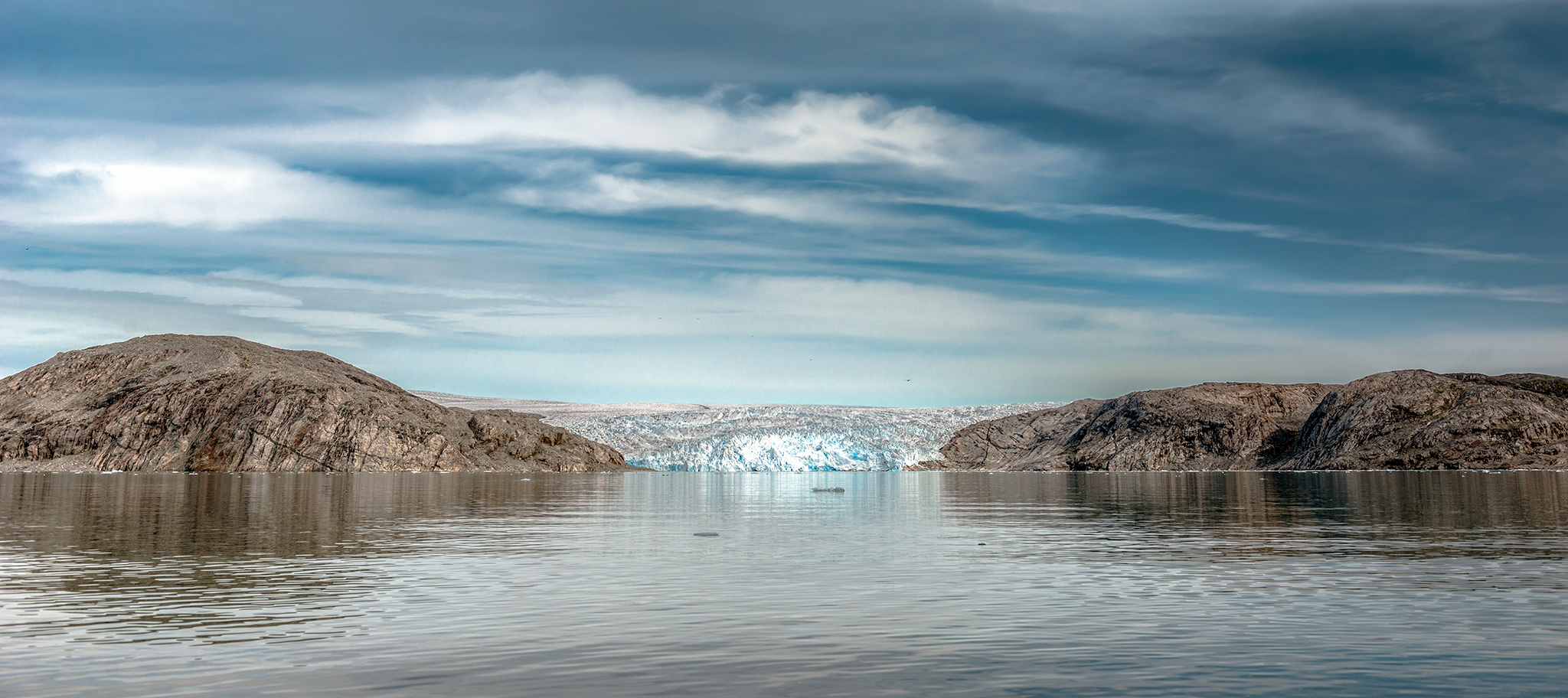
Agradecezco a Tuperna Poulsen el trabajo de documentación local así como a José Trejo, autor del blog Un Extremeño en el Ártico, por prestarse a resolver todas mis dudas acerca de las costumbres. Además, a los 12 de Nora por formar una expedición inigualable.
§
Global warming is an undeniable fact. During the last few years we have witnessed changes in the planet's temperature and, despite the fact that the scientific community has given the
alarm, governments still do not recognize their responsibilities. Warming is expected to be higher in the earth than in the oceans and the most marked in the Arctic, with the continuous
retreat of glaciers, permafrost and ice. Other likely effects include more frequent extreme weather events, such as heat waves, droughts, torrential rains and heavy snowfalls, acidification
of the ocean and extinction of species due to changing temperature regimes. Significant human impacts include the threat to food security from declining crop yields and loss of habitat due
to flooding. Because the climate system has great inertia and greenhouse gases will remain in the atmosphere for a long time, many of these effects will persist not only for decades or centuries
but for tens of thousands of years. It is vitally important for physicists to monitor the behavior of Arctic ice. This is the narrative of a discovery, developed in September 2017
and the finding of definitive proofs of warming.
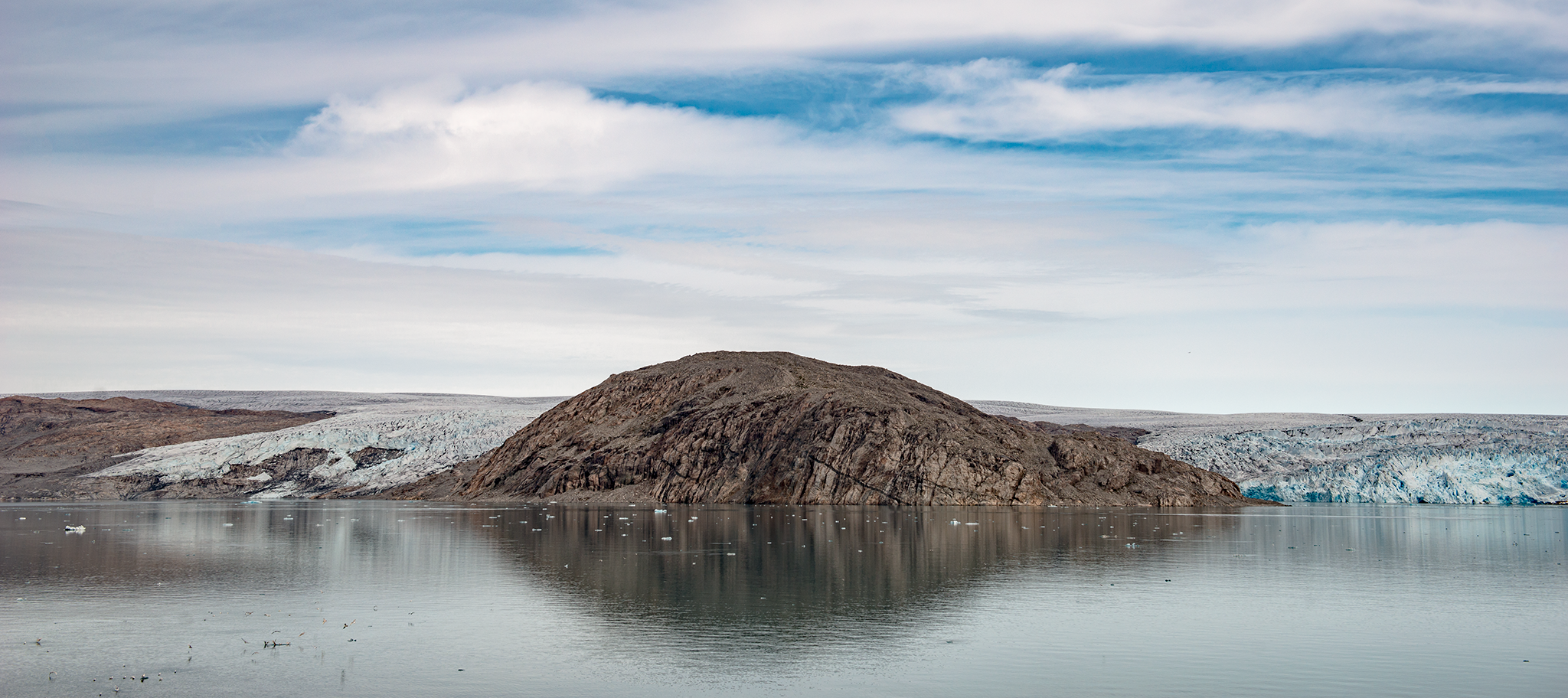
I thank Tuperna Poulsen for the local documentation work as well as José Trejo (Un extremeño en el Ártico) for lending to answer all my questions about customs. In addition, thanks to Nora's twelve to form an unparalleled expedition.
Viernes, 1 de septiembre de 2017
Tras dos viajes y una espera prolongada en Berlín de casi 8 horas pasan a recogerme desde el transfer de Alex Guesthouse al aeropuerto de Keflavik.
La chica es educada y se ofrece a llevarme al día siguiente de vuelta al aeropuerto. Habitación triple para mi solo con baño y ducha compartida con agua procedente de la Blue Lagoon.
Habitación sosa, el resto bien. Desayuno un tanto pobre. Me levanto temprano para visitar Keflavik y darme cuenta que están en fiestas, Big Band incluida.
El humor de los islandeses en un tanto especial, tienen un photocall en la Giganta’s Cave! Tal cual. El tiempo es complicado, aire y las nubes amenazan lluvia.
Sábado, 2 de septiembre de 2017
Están en fiestas en Keflavik. En un hindú me hincho a beefburguer y patatas. Imposible terminar las patatas picantes. La policía en Islandia es bastante gruesa, llevan quad. Lo de los nórdicos y los gigantes es de Traca: Skessuhelli!!
Varios niños de la kindergarden Tjanarsul piden un mirador al mar con gigantes Steinn & Eleggja (Boeder & Sledgehammer), Tröll.
El vuelo a Narsarsuaq con Air Iceland está programado a las 17:45 h. A la hora del transfer al aeropuerto me encuentro en la guesthoouse con un grupo de españoles.
Una vasca, un catalán y una pareja. Uno de ellos es un antiguo conocido de Groenlandia. También hay un sevillano y una almeriense. Hago buenas migas y charlo horas con ellos.
No son de mi grupo y aún no lo saben, pero sin duda serían buenos compañeros de viaje. Otro grupo de españoles, de edad avanzada, están en Keflavik. Ellos no serían tan buena compañía.
Antes de embarcar me fumo un cigarro con el catalán. Comienza la aventura. Dejamos atrás el aeropuerto de diseño islandés. En el bus que nos acercará al bihélice una pareja
me quita un mosquito que a punto está de acabar con mi vida. No lo vi, pero me dicen que era enorme. Las dos son muy agradables.
Una se encargará de secarme amablemente la parka días después sin saber que era la mía, poco importa la propiedad privada en los viajes. Embarcamos.
Si no me equivoco soy el único español en las primeras plazas. Las horas pasan en un continuo goteo de españoles en la cola del baño.
La azafata es gigantesca y a duras penas cabe por el pasillo. Al piloto se le hace un mundo entrar al baño de lo enorme que es.
Todo lo que he leído del alcoholismo groenlandés parece correcto. El prototipo es un inuit de edad imposible de determinar,
sentado en primera fila. Se merienda dos cervezas y la tercera la tira al piso. Cruza todo el avión dando tumbos para pedir un trapo.
Difícilmente limpia el desastre, sin darse cuenta que la moqueta ha absorbido toda la cerveza. Dejo de mirar un minuto y ya tiene otra cerveza en la mano.
Charla animadamente y ríe con su compañero de asiento. Tiene facciones muy marcadas, el pelo muy grueso y la mirada hundida. Aún así, es cortés y no da problemas.
Mi compañero de asiento no habla mucho. Se llama Konrad y es alemán. Dice que me ha visto antes en el Guesthouse de Keflavik.
Converso con él y me enseña su cámara Nikon. Le digo que vamos a llevarnos muy bien. Sin darnos cuenta han pasado las dos horas y media del vuelo y ya sobrevolamos Groenlandia.
Hace sol y entre los fiordos se distinguen claramente cientos de icebergs. Nos pegamos a la ventanilla embobados: el espectáculo es hipnótico. Al fondo un gran desierto blanco: el Inlandis.
Aterrizamos en Narsarsuaq. Al bajar del avión hace bastante fresco. Austero y funcional. Todo el pasaje nos juntamos en una sala pequeña con una cinta de transporte de la que salen grandes
piezas embaladas. Son propiedad de unos cazadores. Ellos nos comentan que son las piezas de un motor…Llega el momento de separarnos. Me despido del catalán y del sevillano con la almeriense.
Recojo mi maleta, mi petate y salgo por la puerta. Delante de mi esperan tres chicas sosteniendo tres hojas. Durante unos segundos dudo donde mirar y entre los nombres extranjeros veo el mío.
Quedé con Mery en que viajaría con la expedición internacional. Respiro aliviado. Sonrío y suelto “¡Ese soy yo!”. La chica sonríe y me dice algo parecido a “Bienvenido a Narsarsuaq,
allí puedes recoger tu zamarra”. La miro y mientras inicio la marcha hacia el resto del grupo le digo, “me ha encantado lo de la zamarra”.
Ella es Nora y será nuestra guía. La zamarra es la parka, compañera infatigable. Creo que las otras dos son Andrea y Eva. Un gran grupo de exploradores se entremezclan para recoger las parkas.
Antonio, del personal del apoyo, me da la talla M. Mientras recibimos una mínima instrucción, me doy cuenta que mi compañero de asiento del vuelo está en mi grupo.
Cargamos el equipaje en dos coches. Uno es una furgoneta y el otro un Toyota. Recorremos con Antonio “la carretera asfaltada fuera de núcleo urbano más larga de Groenlandia” hasta un embarcadero.
No más de 500 metros. Allí nos ponemos la parka y otro compañero de fatigas, el chaleco salvavidas, obligatorio siempre que estés en zodiac en el agua o cargando pertrechos en los embarcaderos.
Hacemos el primer change2change para abordar la zodiac del Capitán Ajo. No da tiempo a reconocer los rostros de mis compañeros,
todo va muy rápido y yo me noto demasiado lento para prestar atención, fuera de los icebergs que campan por el fiordo.
Ajo es un groenlandés bonachón que dice tener 45 años. 14 almas cruzamos el fiordo de Erick el Rojo camino a Qassiarsuq. Durante la travesía, Ajo nos vacila con ballenas.
Carcajadas generalizadas. Le miro, me mira, nos descojonamos y me invita a ver cómo la aplicación que tiene en su móvil arroja la misma derrota hasta Qassiarsuq que el propio GPS de la lancha.
Primeros icebergs con el sol empezando a caer en el horizonte. He perdido la noción del tiempo. La expedición está emocionada ante el recibimiento de los icebergs, que no son pequeños.
En la primera travesía soy prudente y dejo la cámara en el petate. Todas las singladuras en lancha se resuelven siempre de la misma manera: Nora, agil, salta de la embarcación y asegura la zodiac.
Aún hace sol y con las parkas no notamos frío. Descargamos la embarcación y metemos nuestro equipaje en un 4x4. A unos 200 m está nuestro primer destino y no será el hostel Leif Ericksson.
Será algo mejor: la casa de Ramón.
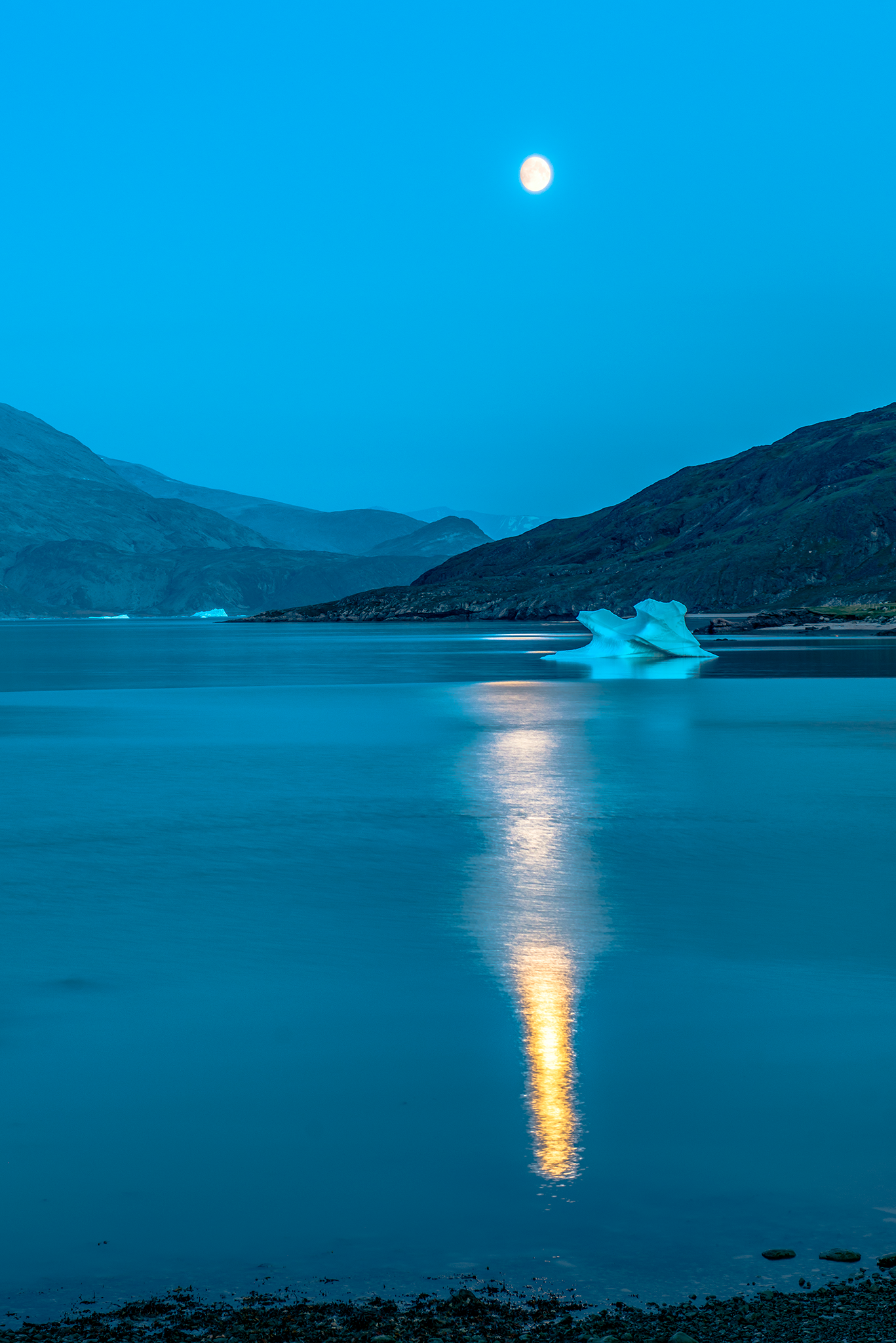
Una casa pegada al fiordo, con un pequeño porche a la entrada para descalzarse. Trece viajeros entrando. El reparto de camas ha comenzado.
A la izquierda, una habitación con cama grande, será para Pedro y Pera que vienen juntos. Justo en la entrada, un baño con ducha y una pequeña ventana
(veréis que útil es la ventana en estas latitudes). Un pasillo en forma de L divide la casa en un salón-cocina grande y muy funcional. Otra habitación y un solárium de cara al fiordo.
Al otro lado del pasillo, una habitación con seis literas y una pequeña estancia que haces las veces de cuarto de lavadora con dos literas y que es la más caldeada de la casa.
Será la mía y la compartiré con Lolo y será el lugar más particular. Mi ventana da a una terraza de madera con unas vistas tremendas del fiordo. Dentro de la casa estaremos a 30°C.
No tiraremos el papel al retrete, irá directamente al cubo de la basura. Un dibujito nos los recuerda. En caso contrario todo derivaría al fiordo.
Poco importa, esa primera noche mis deposiciones son de conejo, habrá que acostumbrar el intestino. En la cena las presentaciones y una breve charla de a qué nos dedicamos.
Merie, Lolo (la bióloga que es capaz de imitar perfectamente a Jane Goodall), Stephane y Chris son franceses aunque Chris vive en Montreal. Francine inglesa.
Nicola es italiano. Konrad, como sabéis es alemán. Pera y Pedro catalanes, Jonathan vasco y Jürgen holandés. Nora es alemana y maneja un castellano con marcado acento mejicano.
Tras cenar nos customizamos las parkas con cinta aislante con nuestros nombres (poco durará ni falta que hará). Cambiaremos también las maletas por unos petates verdes “hidrófobos”
que customizaremos, todos excepto Nicola que ya viene preparado con su petate amarillo (al mío le pondré una goma del pelo rosa con dos florecitas que me encontré por ahí).
Por si las moscas, distribuimos bolsas de basura para resguardar el saco de dormir. Noche. Luna. No hay nubes. Un resplandor fulgurante recorre todo el cielo. Auroras.
No me cansaré de verlas. Esa noche, casi en solitario y con una breve visita de Pedro, monto la cámara, el trípode y me llevo el recuerdo de la primera noche iluminada por auroras en Groenlandia.
Mis compañeros están descansando y fuera empieza a refrescar. Tengo que revisar la hora de las fotos. He salido con la ropa justa. Último cigarro en el porche y a la litera.
Mañana toque de diana a las 7.
Friday, 1 September 2017
After two trips and a prolonged wait in Berlin of almost 8 hours I arrived to Keflavik airport and a driver collect me to Alex Guesthouse. The young girl is educated and offers to carry me next
day back to the airport. Double room with a sink and shower shared and water from the Blue Lagoon. Breakfast seems me a little poor. Early in the morning to visit Keflavik. They’re having fun
celebrating a party in the town, Big Band included. Icelandic' humour is really special. The weather is complicated, windy and cloudy, brings rain.
Saturday, 2 September 2017
Keflavik. Lunch beefburguer and potatoes in restaurant with hindi workers. Too spicy potatoes for me. The police in Iceland is quite thick, usually rides quad. The Nordic’s humor about the Trolls
is really funny: Skessuhelli!! Several boys of Tjanarsul kindergarden ask an oriel to the sea with giant Steinn & Eleggja (Boeder & Sledgehammer). Spaniards everywhere in Keflavik. The Air Iceland
flight to Narsarsuaq is scheduled at 05:45 PM. At the time of transfer to the airport I find myself in the guest house with a group of Spanish travelers. A young Basque girl, a Catalan couple.
One of them was in Greenland a long time ago and showed me old photos. There is also a nice Spanish couple from Seville and Almeria. We spent hours chatting. They are not working on my group
and they still do not know it, but they would definitely be good traveling companions. Another group of older people is in Keflavik. They would not be such good company. Before boarding I smoke
one last cigar in Icelandic lands accompanied by my new Catalan partner. The adventure begins. On the bus that will bring us to the Fokker plane, a couple of girls pulls me out a mosquito
that was prepared to end my life. I did not see it, but they tell me it was huge. Both are very nice. They’ll dry my parka days later without knowing it was mine and I will be forever grateful
for it (my parka and the others: private property on this trip will not make any sense). Time to board. If I’m not mistaken there’s no more Spanish travelers in the first seats. The hours pass
under a continuous walk of people to the bathroom. The stewardess is huge. The commandant struggles to enter through the bathroom door. It seems that everything I’ve read about Greenland
alcoholism is correct. The inuit prototype of indefinite age is sitting in front of me. He enjoys snacking two beers and throws a third to the ground while chatting cheerfully with his seat
colleague. He walks down the aircraft looking for a washcloth and a minute later, come back smiling. He cleans the mess without realizing the carpet has already done all the work for him.
I wasted a moment and man already has another beer in his hand. Laughs with his mate of seat. His features are very marked, disheveled black hair and very marked wrinkles crossing his face.
However he still very polite. My mate of seat does not speak a lot. His name is Konrad, a 54 years old german. He has seen me before in the Guesthouse of Keflavik. Talking with him I realize
he carries a Nikon camera and I tell him that we’re going to get along very well. After two hours and half we’re flying over Greenland. It’s sunny and flying over the fjords we can observe
hundreds of icebergs. We both stuck to the window. The show is hypnotic. An inmense white desert glimpses under my feet: the Inlandis. We landed on the unique track on Narsarsuaq
gently. The airport is austere and functional. All the passage joint us in a small room with a single strip of transport of which go out big pieces and our luggages. They are property of
hunters and they comment us that these are some kind of the pieces for engines. Time to break up. Bye to the Spanish group. I collect my case, my backpack and left outside. Behind the door
three smiling girls sustaining three leaves. They’re waiting for travelers. I doubt where to look for a few seconds until I find my name with foreign names (thanks Mery for joining me the
international group!). I breathe in relief and smiling look the owner of the print and I tell her “Ey! Ése soy yo!” (That’s me!) . She smiles and says me something resembled “Welcome to
Narsarsuaq, there you can collect your zamarra”. I look her and while I initiate the walk to the rest of the group, I turned and said her, “Me ha encantado lo de la
zamarra” (I loved when you said zamarra). She is Nora and she’ll be our tireless guide. The zamarra is the parka, our best friend for cold times. I think that the others two guides are Andrea
and Eva. A big group of explorers collect the parkas. Antonio, supporting staff member, gives me one size M. Meanwhile we receive a minimal instruction I realize that Konrad will travel with us.
We load the luggages in two cars. One is a van and the other one a Toyota pickup. Antonio introduces us “the longer asphalted road, out of a town, in all Greenland” which begins in
Narsarsuaq and ends at wharf. Time to learn the routine to board the boat, whenever you’re on a jetty or loading the ships. Life jackets and parkas on. First change2change to
tackle Captain Ajo's boat. No time to recognize the faces of my mates, everything goes very fast and I notice me too slow to pay attention, out of the icebergs that float across the fjord. Ajo
is a middle age greenlander. Fourteen souls crossing the fjord of Eric the Red way to Qassiarsuk. During the journey through the fjord, Ajo jokes about whale watching.
I look at him, he looks back at me and we laugh together. Closer the other shore Ajo invites me to see how the app in his smartphone launches the same way until Qassiarsuk that
the own GPS of the ship. First icebergs with the sun beginning to fall in the horizon. I have lost the notion of the time. The expeditioners are thrilled looking stunned the reception of the
icebergs. I’ll take too much care in this first boat experience leaving the camera inside backpack. All trips in boat will end at the same way: Nora jumps out the semi-rigid boat and secures
the ship. Sunset and we keep warm with parkas. After that, we download the craft and put our luggage in a 4x4. Two hundred meters separate us from our first destination and it will not be the
Leif Ericson hostel. It will be something better: Ramón’ House. A house on the banks of the fjord with a small roof at the entrance to remove the boots. Thirteen travelers going in.
The distribution of beds has begun. The first room to the left room with double bed, it will be for Pedro and Pera. They come together. Next to the door, a bathroom with shower and a little
window (You’ll see soon that useful is the window in these latitudes). A corridor in shape of L divides the house in a living room and kitchen. Another room and a solarium in front of the fjord.
Just across the corridor, a bedroom with six bunks and a small chamber for laundry and heating room with two bunks. It will be mine and I’ll share it with Lolo (Of course, the most particular
place). Across the window we can see wooden terrace with the most amazing panorama of the fjord. Inside the house we will be upper to 30°C. We will not throw the paper to the toilet, we use
a dust bin for cellulose waste as a lovelly children’s drawing on the wall reminds us.
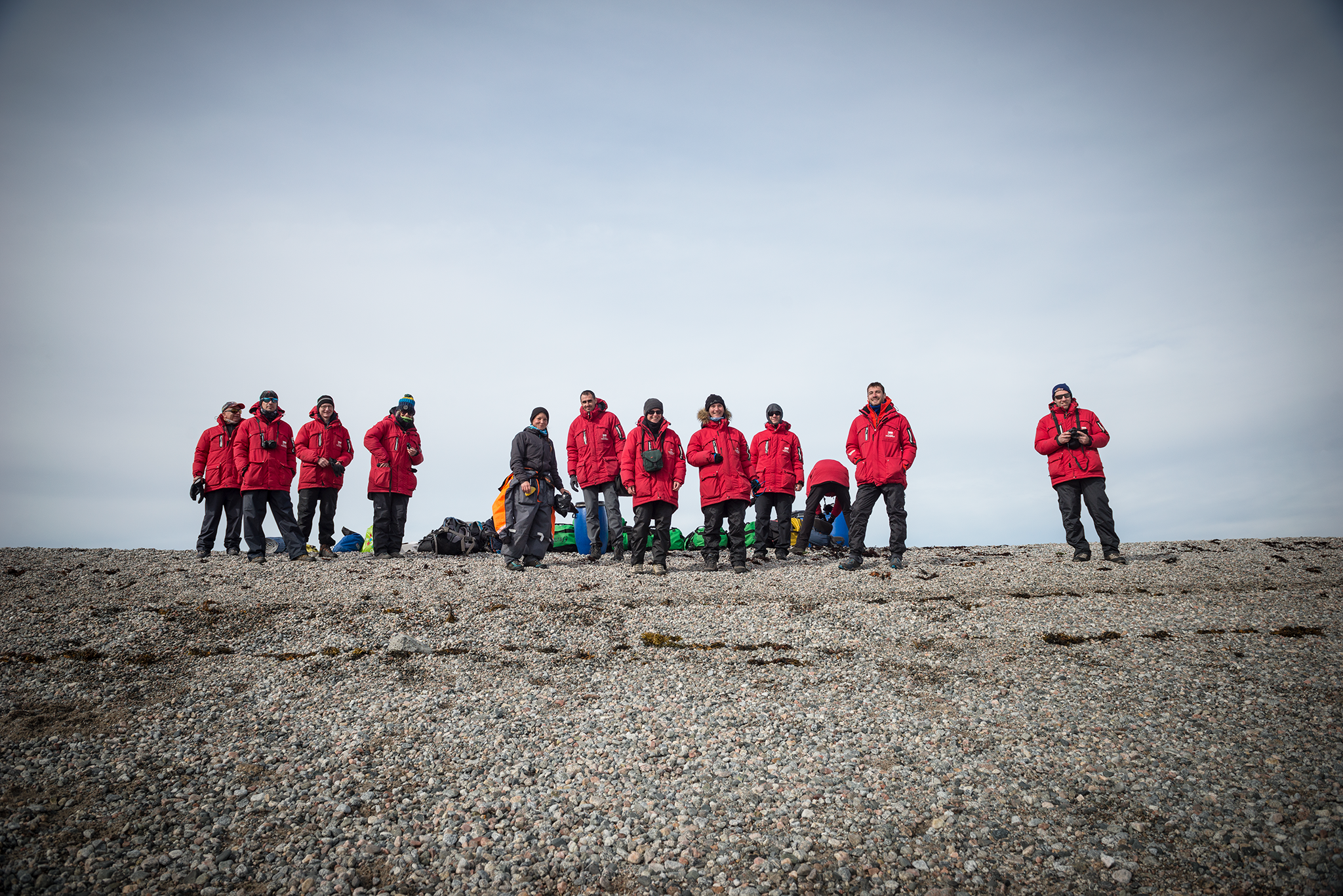
During the dinner the travelers’ presentations and a brief talk about what we do. Marie, Lolo (the biologist able to imitate perfectly to Jane Goodall), Stephane and Chris are french (Chris lives in Montreal). Francine is a middle age british woman. Nicola is Italian midshipman. Konrad, as you already know is german. Pera and Pedro both catalans, Jonathan is basque and Jürgen dutch. Nora is german and handles a Spanish with marked mexican accent. After dining we all customize the parkas with insulating strip writting our nicknames on it (little will last and nicknames won’t be necessary either at the end). We will change also the cases by some green waterproof travel bags, all of us except Nicola, he traveled with his own yellow one (I used a pink ribbon with two little flowers to find it at the first glance). Just in case, we distribute rubbish bags to protect the sleeping bag. Night. Moon. No clouds. A blazing glow sweeps across the Qassiuarsuk night sky. Auroras. North lights will begin that day and they will be there for us night after night. Almost in solitary and with a brief visit of Pedro, mount the camera, the tripod and carry me the memory of the first night in Greenland. My mates are resting now and temperature lows quickly. I have gone out with ligh clothes. Last cigar enjoying the best panorama terrace and back to the bunk. Tomorrow waking up at 7 AM.
Domingo, 3 de septiembre de 2017
Desayunamos y entre todos arreglamos la cocina y los platos. Ramón tiene lavaplatos por lo que la tarea es más rápida. Hay una mezcla de silencio y emoción.
Todos andamos por la casa como pollo sin cabeza. Los exploradores se van agrupando. Los españoles hacen un núcleo duro y piden a Nora instrucciones en español desde la llegada al aeropuerto.
Stephane y Chris serán inseparables. Merie y Lolo se entienden muy bien. Al holandés y al alemán les costará más entrar en la dinámica, pero Konrad está cada día más dicharachero y se interesa
por usar su cámara en modo manual. En el avión le prometí que no volvería a usar su nikon en modo automático (al menos conmigo delante). Fran es la senior.
Nicola irá bien siempre desde el principio. Es el carácter mediterráneo. En ése primer desayuno comienza la camaradería que nos acompañaría el resto del viaje.
La batalla por la nutella no ha hecho más que comenzar. Hoy no habrá zodiac. Nora nos informa que el plan es cruzar montañas hasta la granja de Tasiusaq, en el fiordo de Sermilik.
Hoy haré kayak por primera vez y como todas las primeras veces será inolvidable y además, será en un entorno único. Desde la base de Leif hacemos acopio de comida y cargamos con los termos
llenos de agua caliente. Una breve marcha y nos presentamos ante el mismísimo Leif Erikson, hijo de Erik el Rojo y hacemos camino. Charlas breves mientras cruzamos lagos pequeños y riachuelos.
Nora nos cuenta que un compañero sacó a una oveja-cordero del río otra temporada. En la parada para picar y beber algo Pedro nos saca foto de grupo.
Seguiremos el sendero hasta alcanzar un mirador desde donde se ve una inmensa bahía repleta de icebergs. Allí dirigimos nuestros pasos con los ojos abiertos de par en par.
Un par de águilas en danza son testigos de nuestra presencia. En otra serendipia encuentro un maxilar inferior de un óvido con sus dientes intactos. Fácilmente salen 3 que volverán conmigo a España.
Pasé las horas en el aeropuerto de Berlín esperando el vuelo a Islandia leyendo una edición de bolsillo de Las Montañas de la Locura, de Lovecraft. La portada es un óvido congelado en el hielo,
con su ojo clavado en el lector y los dientes visibles sobre el hielo manchado de rojo sangre. Tras una caminata prolongada al sol llegamos a Tasiusaq. Recibimos instrucciones:
no tocar a los perros, podrían tener rabia y no queremos comenzar con mal pie el viaje. Malamente cumplimos la norma. En la granja niñas de 6 años llevan un quad. El sendero está marcado,
fuera de él, los pocos campos arables de Groenlandia. Keep your ass out the grass. En una casa nos espera Álvaro, un gaditano que ha debido de hacerlo todo en la vida y que será nuestro guía
de qajaq. Tras un almuerzo merecido, un par de #1 y tiempo de tomar el Sol a unos 14° C, bajamos a la bahía. Varios kayaks esperan, y a su lado una gran yurta repleta de todo lo necesario
para la aventura náutica. Veinte minutos después somos 11 superhéroes recibiendo instrucción de Álvaro. Pala asimétrica, centro del lado derecho fijo, mano izquierda flexible, brazos en 90°
nunca por encima del hombro. Bajo ningún concepto girarse y bajo ningún concepto caerse al agua. Reparte bolsas estancas para las cámaras. Llevo la mía en previsión de que fueran pequeñas.
Cargo con el 24-70 mm y es suficientemente grande y pesado para no ser fácil de manejar dentro de una bolsa desconocida. Ajustamos alturas y pedales y embarcamos. El capitán Jonathan será
mi navegante. Más le vale, es capitán de velero y yo aprendí a entrar, pero no a salir. La tarde transcurre plácidamente y poco a poco cogemos ritmo, que obligo a Jonathan a marcar para no perder la marcha.
Poco a poco avanzamos y guiados por Álvaro nos acercamos a los inmensos témpanos de hielo flotantes. Por momentos voy sacando la cámara. Dos horas de paseo marítimo entre inmensas moles de
hielo y obviando el incidente internacional franco-euskaldun-hispano, todo marcha a la perfección. Los brazos pesan. Sin velocidad no hay dirección. Mi navegante disfruta como un enano.
Un inmenso iceberg flota en medio de las embarcaciones. Media hora después de volver hasta la playa ya estamos preparados para la ruta de vuelta, un poco más corta. De charla con Fran,
no nos damos cuenta y nos quedamos atrás. El resto ya ha llegado a Ramon’s House y están duchándose. Nora nos espera paciente cerca de Qassiarsuq y me da las gracias.
Nos coge en un momento en el que la Luna sale por el fondo del fiordo y su luz se refleja justo a la altura de la estatua de Leif.
Prometo mandarle la foto. Nora es Nikon también.
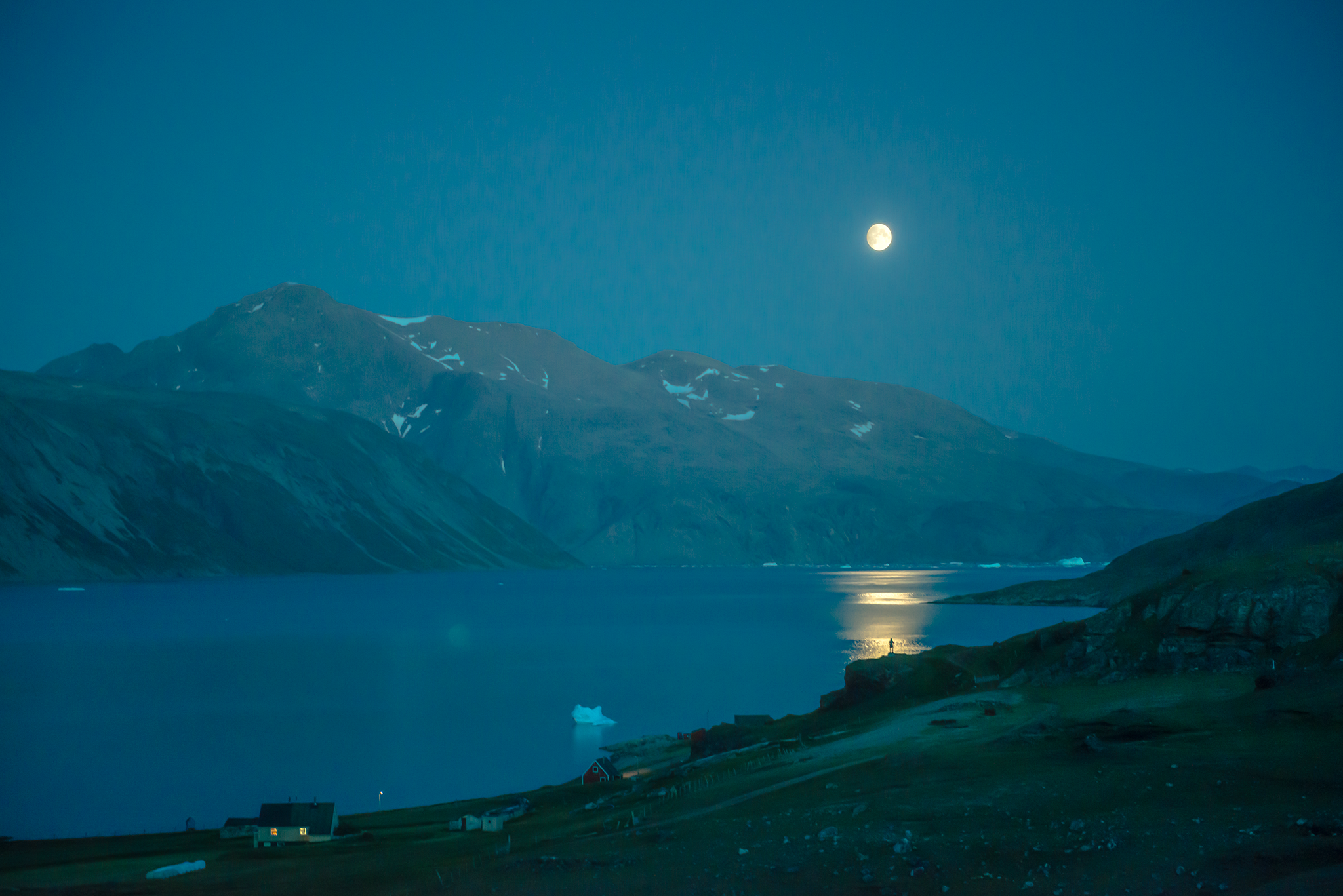
Reanudamos la marcha, charlando animadamente los tres. Tras una ducha relajante, cenamos animados por conversaciones del día y al finalizar, vía Nora, nos dan la voz de alerta.
Tenemos una aurora tremenda encima de nuestras cabezas. Salimos todos como un rayo al porche delantero y observamos como una inmensa aurora baila justo encima de la casa.
Salimos a la puerta de atrás, donde hay más oscuridad. El espectáculo es impresionante. Qassiarsuq se ha revelado como el mejor punto de auroras hasta el momento. Toca sesión nocturna.
Sesión de cámaras express. Lumix de Pedro, Kodak de Lolo, las Nikon de Jonathan y Konrad, y por último la Sony de Fran, que se llevará una foto de la Luna saliendo frente a nuestra casa.
Todos se llevan un recuerdo feliz. Otro día revisar las cámaras mejor a la luz del día. Antes de dormir, les pido una foto de grupo bajo la luz de las auroras.
La excitación y el azúcar impiden que se queden quietos 20 segundos ;-) Se nota el día y mi cuerpo pide cama. En el laundry-bedroom de Ramón la noche es un constante duermevela,
mitad excitación, mitad perturbación por el petardeo del reinicio de la caldera. La expedición lee, duerme o hace fotos en la oscuridad.
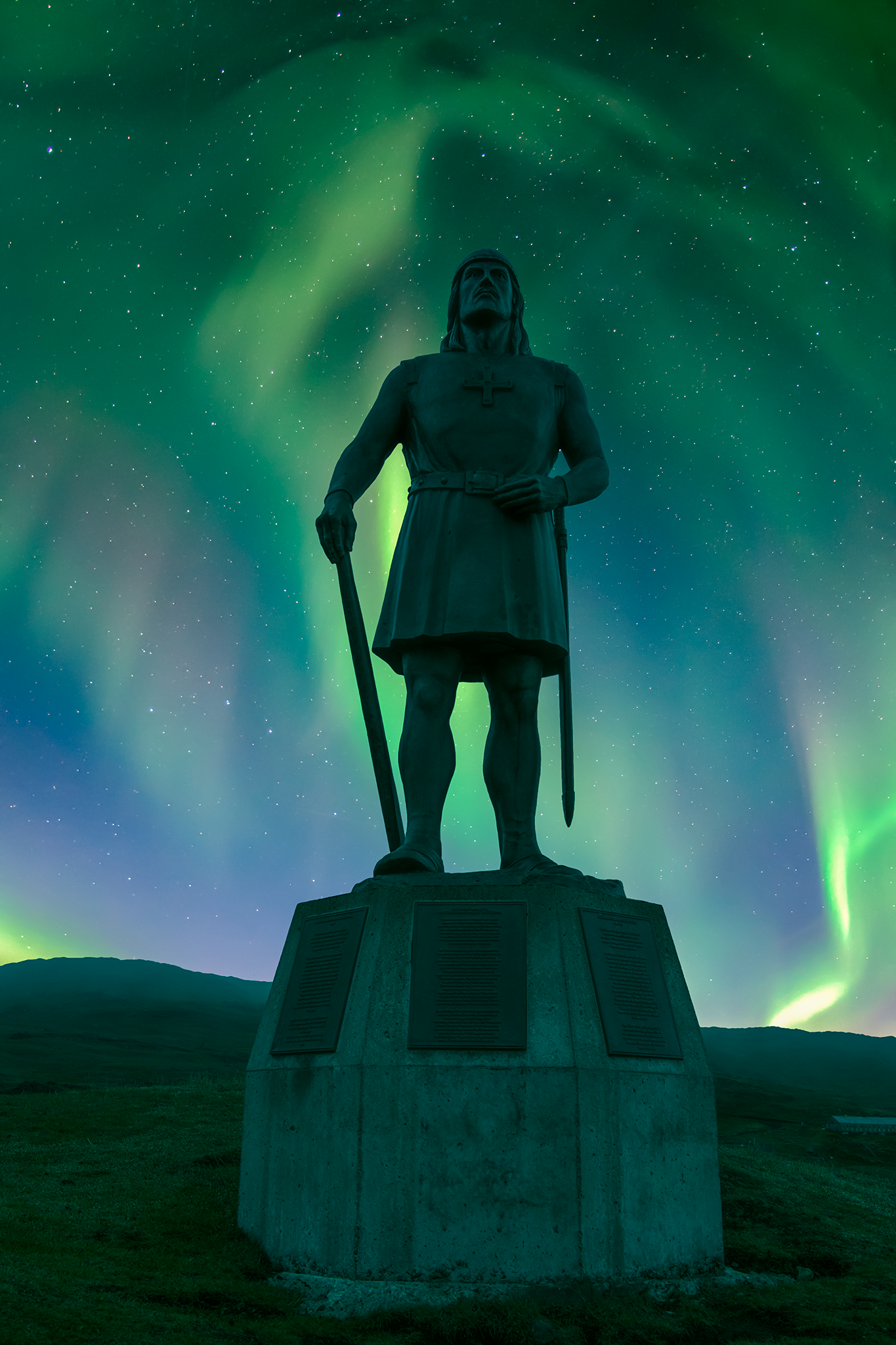
Lunes, 4 de septiembre de 2017
Hoy el destino será el Valle de las Mil Flores y Glaciar de Kiattut. El desayuno es más animado, el tono se va elevando, entre peticiones y cortesías varias. El silencio ha desaparecido.
El navegante vasco empieza a soltarse y está más dicharachero con el inglés, que predomina entre la expedición sobre el español, el francés y por razones obvias el alemán.
Parece que todos están contentos con sus fotos nocturnas. Con el reparto matutino del picnic comienza la andadura. Fuera maletas. Todos los pertrechos estarán a partir de ahora dentro del
petate verde customizado. Comandados por Ajo dejamos atrás Qassiarsuq y cruzamos el Erickfjiord hasta el embarcadero de Narsarsuaq. Al otro lado nos espera Antonio.
Paseo corto en coche para llegar al lugar elegido para iniciar la marcha. Increíble, otro día de sol y de verano en Groenlandia. Dos semanas después el otoño se hará visible en todo su esplendor
en las montañas de Narsarsuaq. Empezamos a andar. A los pocos metros encontramos una estación científica que controla los niveles de CO2 (entre otros gases de efecto
invernadero) liberado por el permafrost. Llegamos al inicio del valle glaciar. El Kiattut está en claro retroceso, se observa en el propio valle desierto cruzado por una suerte
de ríos y riachuelos que bajan fuertes. El camino es ligero hasta el momento y pasan las horas entre conversaciones con los expedicionarios, de flores comestibles y algodón ártico.
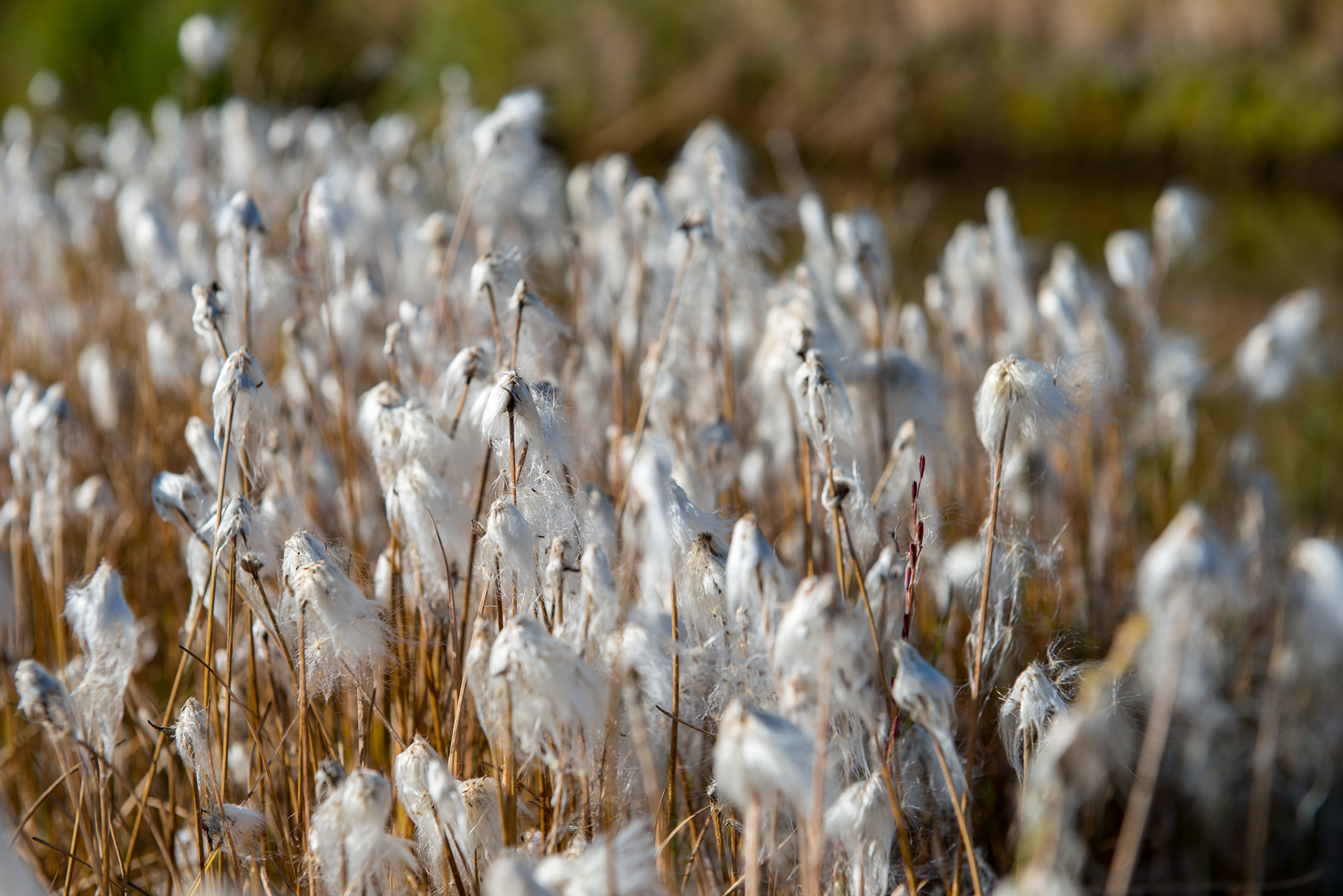
Aquí Antonio me sorprende con un chascarrillo que me jode no haber dado yo con él, Nora la Exploradora. Es genial! Constantemente encontramos endrinas, arándanos, angélica,
campanillas y Niviarsiaq (Chamaenerion latifolium). La angélica se usa para aliviar dolores y me lo apunto. Su tallo se puede comer como el apio y las flores se usan para hacer tisanas.
En Nanortalik compraré semillas de angélica sin saber que Qaqortoq está plagada. Llegamos a las mismas puertas del glaciar. Tres científicas, de moreno sospechoso una de ellas, nos adelantan.
Allí mismo tienen otra estación científica. En este punto hacemos un breve descanso para un pequeño tentempié y afrontar un desnivel que bordea una cascada hasta el mirador del valle,
desde donde alcanzaremos el glaciar, por encima de él. Fran se queda con Antonio. Comenzamos la ascensión en zig-zig. Las cuerdas no son seguras y hacemos el camino despacio.
Voy demasiado abrigado y el calor es sofocante. Cada poco tiempo paramos para atravesar pasajes más delicados. Superamos unos 150 metros de desnivel y desde allí divisamos el valle.
Las piernas me arden. Desde aquí el glaciar aún no es visible. Chris aprovecha el momento para hacer volar el drone y sacar impactantes imágenes.
Continuamos hacia un lago de aguas cristalinas, me está llamando, y mucho. Hablo con Nora y me dice que el baño en el lago será después del picnic. Le digo que no será un baño,
que tardaré menos de 10 minutos. Paro la expedición y mis piernas agradecen el fresco. Oigo las voces de mis compañeros. He detenido el avance. Se encuentran en un camino a unos metros de altura
de desnivel. Me visto corriendo y me uno nuevamente al grupo. Me disculpo con Nora y aunque me da las gracias por el gesto noto en su mirada que he roto la disciplina del grupo.
Luego no habrá baño, tras la comida los cuerpos se enfrían. La comida es en el mirador al glaciar. No solo ha retrocedido. Su espesor ha disminuido de forma notoria.
Altas temperaturas y lluvias aceleran el proceso. Varios ríos descienden desde el glaciar arrastrando sedimentos y se mezclan con otros ríos más claros, formando un espectáculo
de color entre el agua cristalina azul hielo y las aguas que arrastran sedimentos. La frontera entre las dos es claramente visible. En la confluencia de ambos se forman lodos finísimos
que cubren esa parte del valle desde tiempos remotos. Recordando mi conversación un mes atrás con mi amiga Elena, una artista del vidrio, recojo una pastilla de lodo con un papel de
cocina que encuentro allí mismo. La prenso y la meto en mi petate. Cuando lo funda en el horno, sus sedimentos darán color al cristal y revelarán los elementos que componen aquellas lejanas
tierras. Más adelante guardaría la pastilla en un paquete de tabaco vacío y sorprendentemente no se desintegraría con el viaje. Después de descansar tras el
picnic con las mejores vistas
del mundo toca volver a bajar al valle con las fotos de cortesía.
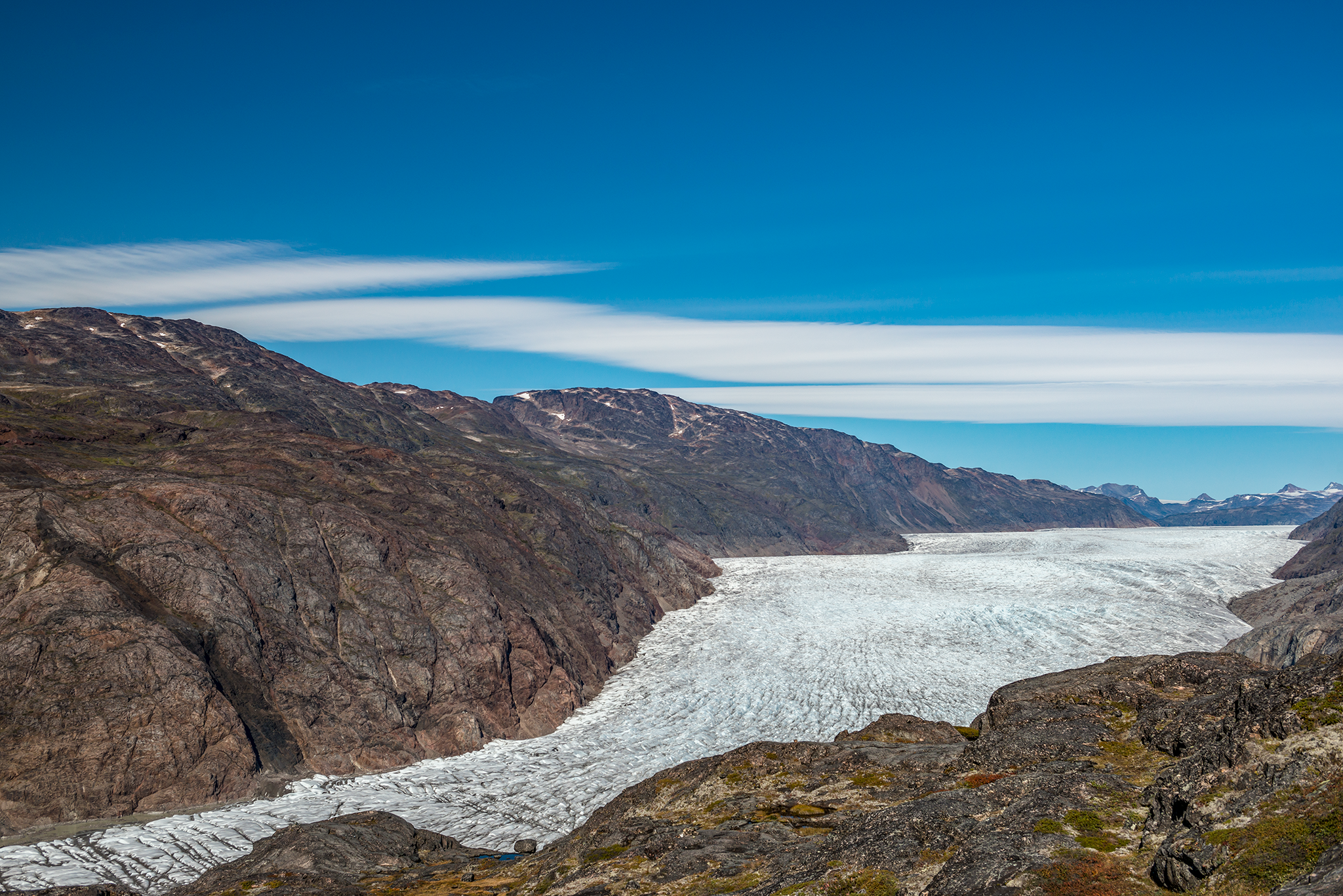
Rodeamos el lago, y acometemos la bajada, que es evidentemente más rápida. Una vez en el valle las conversaciones
con el resto del grupo son más numerosas. Recogemos agua: aún cayendo la tarde sigue haciendo calor. Antonio todavía no ha llegado al punto de reunión por lo que avanzamos a pie para acotar
la distancia. La luz ha cambiado. Solo se ven cables de un tendido eléctrico y algunas casetas del ejército de USA. Antonio llega, montamos los petates y en Narsarsuaq nos dirigimos a
nuestro próximo destino. Si no me equivoco será el Capitán JJ quien nos lleve a Narsaq con todos los pertrechos. Llegamos al caer el día, con los icebergs flotando en el hielo con
tonos dorados y tanto Stephane como Chris no perderán la oportunidad de retratarlos. Después del change2change obligado nos dirigimos al Hotel Narsaq para cenar.
Tras días de sopa de verduras, thai, tomate y espárragos el menú se presenta irresistible en una pizarra: de primero sopa de ballena con arroz, panceta y patata. De segundo chuletas de cordero.
Cerveza rubia fina. La decoración de madera es acogedora y las bombillas con filamento al aire dan un toque retro muy interesante. Nora nos ayuda con las traducciones y las recomendaciones
de la camarera. Algo le ronda por la cabeza. Le suelto un abrazo y me largo a fumar a la terraza. En la cena chistes y traducciones simultáneas de la hostia y comentarios acerca del sabor
y la textura de la ballena. La carne se muestra estriada y recuerda a la carne estofada, pero con un regusto final a hígado, muy ligero. Su poder calórico se nota enseguida.
El salón está caldeado y seguimos demasiado abrigados para la opípara cena. De segundo las chuletas de cordero acaban por rematarme. Los niveles de azúcar se han elevado con las patatas
y ya vuelvo a tener conciencia de dónde y con quiénes estoy. En el intermedio salgo a fumar con Marie y tiene la feliz idea de que invitemos a Nora a cenar. Entre Lolo y ella se hacen
cargo y más tarde saldo mi deuda con ellas en el Artic Café. En general el sabor fuerte de la ballena no es bien recibido y en la expedición ya hay objetores de conciencia en cuanto a
la asimilación de proteínas de mamíferos del mar. Al finalizar Nora ya tiene todo arreglado para hacer noche en el Hostel Narsaq Kayak. Enganchamos el remolque con los petates al
Toyota y Nora sale disparada hacia el alojamiento. El resto nos vamos perdiendo poco a poco por las calles. Al llegar al hostel nuevamente botas fuera. Una gran estancia preparada para recibir
multitud de expedicionarios sirve de gran armario abierto tanto para parkas como para el calzado. Compartiré habitación con Nicola y Jürgen, una litera y una cama. Me quedo con la litera
de arriba (no era consciente aún de las noches de Narsaq…no se tenga en cuenta el detalle). Y sí, estamos en Narsaq y sí, el cuerpo pide marcha. Mientras ayudo
a Konrad con su nikon a capturar auroras, Miguel, un bombero español que sirve de apoyo a otro grupo , me dice que hay concierto en Artic Café. La ciudad es demasiado luminosa para
mi gusto y antes de montar mi cámara y trípode prefiero despendolarme. Marie y Lolo salen y les comento el plan. Fran, Nicola, Jurgen, Konrad, Pedro y Pera descansarán. ¡¡Con Jonathan seremos cuatro para quemar la
noche de Narsaq!! Comienza la primera toma de contacto real con la gente, en su ambiente. Los cuatro seguimos las luces rojas mientras las auroras danzan incansables sobre nuestras cabezas.
Apenas se ve gente por la calle. Algún rezagado busca llegar al bar. Por fin vemos el cartel: tiene pinta de ser un tugurio abierto hasta el amanecer. El mejor tugurio de todo Groenlandia.
No acertamos con la puerta y eso que aún no hemos empezado a pimplar. Damos la vuelta entera y allí, en mitad de la oscuridad una puerta, con un frontman que nos saluda, y una habitación
interior donde gente de edad indefinida fuma. El bar está hasta arriba. Tres zonas definidas: la barra que debe ser un lugar de conquista donde clavar la bandera cerca del datáfono
y no moverse en toda la noche, unas mesas encantadoras donde la gente está sentada plácidamente viendo el concierto en actitud francamente británica y al fondo el escenario con la pista de baile.
Diferentes niveles de alcoholemia. Diferentes edades. Un totum revolutum que me recuerda a mi bar. Allí saldo mi deuda con Marie y Lolo. Junto con Jonathan nos lanzamos a la cerveza.
Durante el gesto de pagar, casi tiro al suelo a una señora acodada a la barra, pero me quedo más tranquilo cuando el señor que parece ser su pareja, la agarra y la sienta firmemente en una silla
demasiado alta para la medida de los dos. Brindis acompañados de la música en directo. La banda se llama Siissisoq (Rinocerontes) y suenan muy bien. El sonido es tan reconocible que estarán de hilo musical
en el resto de los locales nocturnos que frecuentaremos durante el viaje. No entendemos una mierda de lo que dicen porque cantan en groenlandés pero creo entender Narsu-suaq.
Allí mismo me imagino el aeropuerto como única vía de escape de la juventud que quiere huir a occidente. En realidad dicen Nersussuaq (vaca). Los guitarristas viven en San Francisco. Lolo y Marie se lanzan a la pista y yo voy detrás.
Con mi descoordinación habitual le tiro el móvil a una chica que ríe divertida mientras Jonathan asusta a una señora con su altura. ¡Qué fiestón! La gente es encantadoramente amable.
Mientras exploramos el local, vemos que hay una sala inferior con un billar. Si te soltaran aquí no serías capaz de distinguir que estás en el ártico si no fuera por las caras y el idioma.
Ante mi se presenta un chaval que ríe al vernos. No, no pasamos desapercibidos. El solo gesto de salir a pegar botes a la pista ha revolucionado medio bar y la gente se ha lanzado a bailar.
Me pregunta acerca de dónde venimos. Al decirle mi nombre la cara se le tuerce aún más y me cuenta que se llama Carlo y que está encantado de conocerme.
Nos fundimos en un abrazo en el que mis costillas salen perdiendo y se muestra interesado en nuestro viaje. Lo único que acierto a decirle es que mañana partiremos pero que me da pena sabiendo
que existe un sitio aquí así para salir por la noche. Le llama mucho la atención nuestra edad…y nuestros dientes. De fondo rock suave, un par de cervezas más y despedida del bar con fotos
de grupo y vídeos para recordar el momentazo. No había nadie en la calle, estaban todos allí dentro. Hora de volver al hostel bajo la perenne aurora. Hora de despedirse de Carlo que,
visiblemente emocionado, nos sigue, pensando que vamos a continuar la noche sin él. Jonathan obtiene pruebas de la aurora infatigable sobre Narsaq, con el rótulo luminoso de Artic Café.
La expedición duerme plácidamente. Trepar a la litera de arriba tras los primeros días de aventuras groenlandesas junto con la sorpresa nocturna de Narsaq provoca una sensación difícil
de describir con palabras.
Sunday, 3 September 2017
We had breakfast and we get the dishes cleaned. Ramon’s dishwasher helps. There is a mix of silence and emotion. The expeditioners’re now walking around the house like chicken without head.
The explorers begin to cluster. The Spaniards do a hard core and ask to Nora spanish instructions from the arrival to the airport. Stephane and Chris will be a pack. Marie and Lolo understand
themselves very well. Jürgen and Konrad will be slow to enter in the dynamics of the group and Konrad is increasing the interest to run his camera in manual mode. Fran is the senior. Nicola will go
well in all situations from the beginning. Mediterranean character, I suppose. That first breakfast would show the camaraderie that would accompany us the rest of the trip. The battle for nutella ha
s begun. Today there will not be boats. Nora informs us that the plan is to cross hills to arrive Tasiusaq’s farm, in the fjord of Sermilik. My first time kayaking,
as all the first times, it will be unforgettable and besides it will be in some unique surroundings. From the base camp of Leif Hostel we collect food and load the thermos. A brief hike to meet
Leif Erikson, son of Erik the Red. The crew talk while we cross small lakes and brooks. Nora explains us that a partner pulled out a sheep of the river another season. Meanwhile we stop to have
a breathe and drink something, Pedro takes us out photo of group. We will follow the footpath until reaching an oriel from where we would see an immense bay full of icebergs. A couple of eagles in dance are witnesses of
our presence. In another serendipia I find a lower sheep jawbone with intact teeth and three of them will flight come back to Spain with me. I wasted hours in Berlin-Tegel airport waiting for
the flight to Iceland and reading Lovecraft’s The Mountains of the Madness pocket edition. The cover is a frozen sheep in ice, with his eye nailed in the reader and the visible
teeth on the ice blood stained. After a prolonged trek under the sunlight we arrived to Tasiausaq. We received instructions: do not touch the dogs cause they could be have rabie
and we don’t want to begin with bad foot the trip. We try to comply with the rule badly… Six years old girls ride on a quad. The footpath is marked and out of it, the few arable fields of Greenland.
Please, keep your ass out the grass. Álvaro is waiting for us, a man coming from Cádiz, that has owed to do it everything in the life and he will be our kayak instructor. After a lunch deserved,
a pair of #1 and time to sunbathe to 14°C, we go down to the bay. Several kayaks on the beach and close them a big yurta full of all the necessary equipment for the nautical adventure.
After twenty minutes putting on the disguises eleven superheroes receiving instructions. Asymmetrical paddle, check mass centre of the right side, flexible left hand, arms in 90° and never above
the shoulders. Under no circumstances turn the body and ok… never fall into the water. Alvaro delivers watertight bags for the cameras. I carry mine in forecast that these were small. Charge with
the 24-70 mm is sufficiently weighed not to be easy to handle inside an unknown bag. We adjust heights and pedals inside the kayak. Captain Jonathan will be my basque navigator. The afternoon
passes placidly and gradually we pick up pace.In order not to lose synchrony I force Jonathan to sing the rhythm. Step by step we move forward and guided by Álvaro we approach to the immense
floating icebergs. I dare to take the camera out the bag. Two hours of seafaring between moles of ice and forgetting the international franc-euskaldun-hispanic incident, everything brushes
to perfection. My arms being to feel heavy. Without speed there's no direction. My navigator enjoys like a dwarf. A colossal iceberg floats on the middle of the bay. Thirty minutes later we go
back to the beach.
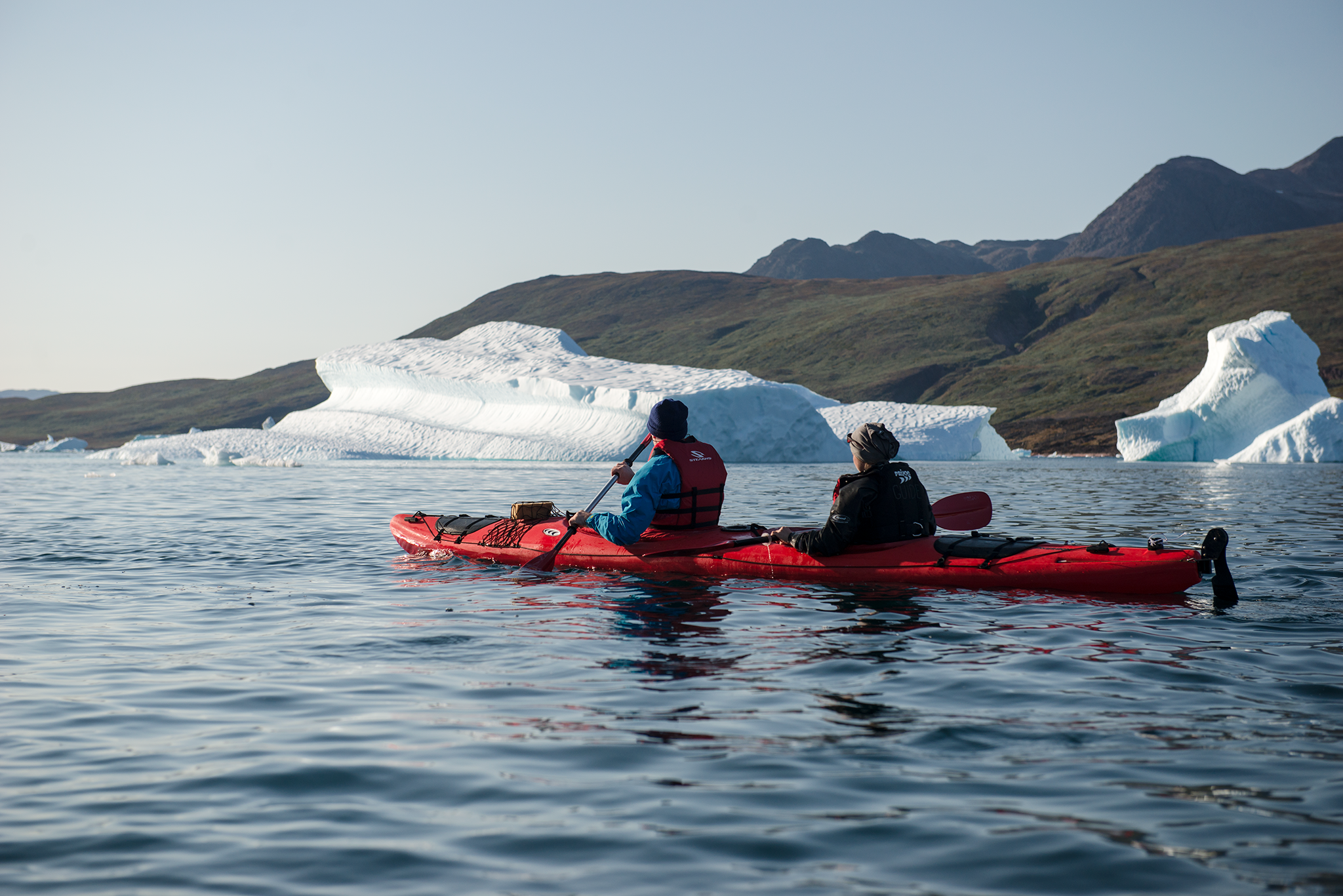
Fran and me return home talking about personal issues and we see that we are behind of the expedition. The rest of the crew have already arrived to Ramon's House. Nora is
waiting for us patiently close to Qassiarsuk and thanking me just the moment Moon begins to dawn and its light is reflecting in the fjord, trimming the Leif’s silhouette.
I promise her that picture. Nora is Nikon user too. We restart the hike. Once in the house, we’ll have a shower and we’ll dinner encouraged by conversations of the day. Once dinner is over Nora
give us the alert. Northern lights are dancing right now above our heads. We go out all like a ray to the terrace and observe one of the most amazing aurora welcoming us. We go out to the rear
door to a darker place. The show is impressive. Qassiarsuk has revealed itself as the best observation point of auroras until the moment. Time for night photography sessions.
Time for express multi-brand camera workshop. Lumix Of Pedro, Kodak of Lolo, Nikon of Jonathan and Konrad, and finally the Sony of Fran, (She toke a lovely picture of the Moon raising in front
of our house). Unforgettable memories. Advice: you should review the camera modes to the daylight for exposure, sensibility and number f before night falls. I ask them a photo of group under
the light of the auroras. The excitation (and the sugar) prevent that they remain still quiet 20 seconds ;-). Time to sleep. Night in laundry-bedroom traps me, mixed excitation, half perturbation
by the restarting sound of the boiler. The international expedition read, sleep or take furtive photos in the dark.

Monday, 4 September 2017
Next destination: One Thousand Flowers Valley and Kiattut glacier. The breakfast works up happily, the tone goes increasing, between requests and several courtesies.
The silence has finally disappeared. The Basque navigator begins to improve his english, that predominates in the expedition over the Spanish, the French and by obvious reasons the German languages.
The crew look happy with the nocturnal photos. With the routine distribution of the picnic we begin the race. All the equipment will be from now inside the green waterproof bags. Captain Ajo
on board, we leave backwards Qassiarsuk and cross the Erickfjord to arrive the dock of Narsarsuaq. Antonio is waiting for us now with the van. Short driving to
start the hike. Incredible, another sunny day in the Greenland summer. Two weeks after, autumn will shine all over the mountains of Narsarsuaq. We begin to walk.
To our right a scientific station
equipment controls the levels of CO2 (among others gases directly related to global warming) freed by the permafrost. We arrived to the start on the glacier valley. The Kiattut is
receding and we can observe the prooves in the own empty valley crusader by several rivers and brooks that go down strong. The way is easy for the moment and crew have conversations about edible
flowers and arctic cotton. Antonio surprises me with a joke so original as great, Nora the Explorer. Constantly we find sloes, cranberries, angelicas, bells and Niviarsiaq
(Chamaenerion latifolium). The angelica is used to relieve pains. The flowers are used to prepare herbal teas . I’ll buy angelica seeds in Nanortalik without knowing that
Qaqortoq is full of angelica. We arrived to the same doors of the glacier.
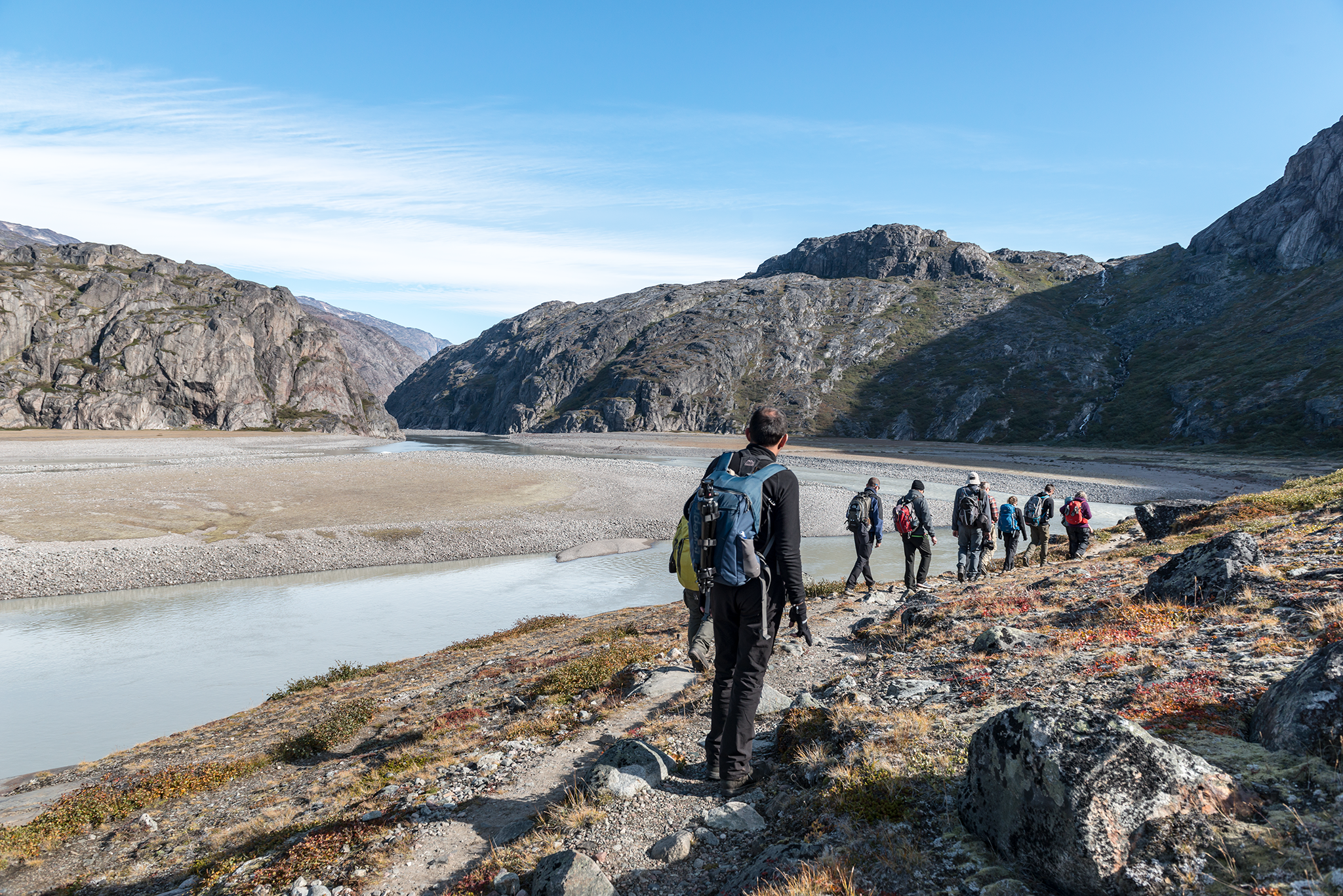
Three young ladies scientists, suspicious tan one of them, advance us. Right there they have another scientific station. In this point we do a brief rest and check the gap close the waterfall we’ll have to climb to reach the glacier. Fran remains with Antonio. We begin the zigzag trekking. The ropes are not safe and we do the way slowly but surely. I go too warmed up wearing winter tights. Each few step we have to stop to afford complicated passages. We surpass some 150 metres of gap and from there the valley shows all around. The legs burn me. Kiattut is not still visible from there. Chris takes advantage of the moment to fly the drone and take out amazing images. We continue to a crystalline waters lake…and the lake is calling me. I talk to Nora and she says me that we can bathe in the lake after picnic. I say her that i will not bathe and it takes less than 10 minutes to refresh me. I stop the expedition and my legs appreciate the icy water for a moment. I hear the voices of my mates. I have stopped the advance. Finished it I join again to the group. I apologized to Nora and although she thanks for me the gesture, I notice in her look that discipline of the crew has broken for a while. Afterwards we can swim but after lunch bodies are not so warm. Picnic on the lookout to the glacier. Its thickness has diminished of notorious way. High temperatures and rains accelerate the process. Several rivers descend from the glacier dragging sediments and mixing with other clearer brooks, forming a show of tones between the blue crystalline water ice and muddy waters that drag sediments. The line border is clearly visible. In the confluence of both river channels you can find very fine slimes that cover this part of the valley from remote times. Remembering my conversation a month ago with my friend Elena, an artist of the glass, take up a tablet of slime with a food film that I find right there. I press the mud and put it in the backpack. Once Elena puts it in the oven, the sediments will give color to the glass and will reveal the chemical elements that compose those far earths. I would save the tablet in a package of empty tobacco and surprisingly the trip would not disintegrate it. Time to go down to the valley with the photos of courtesy. We surround the lake, and tackle the descent, that is obviously faster. Once again on the ground the conversations with the rest of the group are more numerous. We collect water: falling the afternoon and it’s still hot. Antonio has not arrived to the meeting point so we advance on foot to short the distance. The light has changed. We can see wires of electrical line and some huts belonging to the US Army. Antonio drives the van and pick up us point to Narsarsuaq dock ready to head to our next destination. If I do not make a mistake Captain JJ will ride us to Narsaq, SW course, with all the accoutrements. Sunset in Narsaq with golden tones, icebergs shining and floating across the bay. Stephane and Chris will not lose the opportunity to portray the show. After change2change we directed us stright to Narsaq Hotel for dinner. After days of soup of vegetables, Thai, tomato and asparaguses the menu presents irresistible on the blackboard: soup of whale with pork, rice and potatoes. Lamb chops to finish. Fine beer. Nice wooden decoration and the light bulbs with filament to the air give a vintage touch very interesting. Nora helps us with the translations and the recommendations of the waitress. Something worries her. I hug her and go out on the terrace to smoke. Meanwhile jokes and simultaneous translations of the hostia and comments about the taste and texture of the whale. The meat shows grooved and remembers to the braised meat, but with a final aftertaste to liver. The caloric intake is immediately noticeable. Sugar levels have elevated with the potatoes and I already go back to have consciousness of where am I. Marie has the happy idea that we can invite Nora to dinner. Lolo and Marie take over and later I balanced my debt with them in Artic Café. The strong taste of the whale is not well received and in the crew already there are consciousness objectors regarding the assimilation of proteins of sea mammals. Nora already has all fixed to do night in the Hostel Narsaq Kayak. We stick the trailer with the green bags to the Toyota and Nora goes out shot to the accommodation. The rest of us will go later. Plenty of room for parkas and footwear. I will share room with Nicola and Jürgen, a bunk and a bed. I 'll sleep on the upper bunk (I was not still conscious of Narsaq’s nights…please, do not take into account the detail). We are in Narsaq and yes, the body wants party! Outside I'm helping Konrad with the nikon to capture auroras when, Miguel, a Spanish fireman that serves of support member to another group , says me that there is live music concert in Artic Café. The city is too bright for me and before mounting my camera and tripod I choose to burn the night. Marie, Lolo and Jonathan go out and I comment them the plan. Fran, Nicola, Jurgen, Konrad, Pedro and Pera will rest. Four nightclubs explorers to burn the night of Narsaq!! It begins the first taking of real contact with the people, in real environment. We follow the red lights while the auroras dance tireless over the heads. No one on the streets. Some stragglers run to the club. At last we see the neon sign: the dump looks like From Dusk till Dawn. The best dump of all Greenland. We are not able to find the door and we have not started drinking yet. We turn all around the bar and there, in the middle of the darkness a door, with a security guard that greets us, and an inner room where people of indefinite age smoke. The club is full. Three clear-cut zones: the place of conquest where nail the flag close the payment terminal and you don't move in all night, some charming tables where people is seated seeing the concert in british attitude and at the end, the stage with the dance floor. Different levels of drunken countrymen. Different ages. A totum revolutum that remembers me to my dear nightclub. There I balance my debt with Marie and Lolo. The audience chants the songs. Siissisoq (Rhinoceroses) is the band name and they are really good. The sound is so recognizable that it will be our musical thread of the rest of the nocturnal venues during the trip. We do not understand a shit of what they're saying because the frontman sings in greenlandic language but I think to understand Narsu-suaq. Right there I imagine the airport like the only way of leakage for the youth that wants to escape to warm countries (I’ve been looking for the name of the song a few weeks later and it is Nersussuaq) (cow). The guitarists live in San Francisco. Lolo and Marie launch to the dancing floor and I go behind them while Jonathan scares to a lady with his height. OMG! They love the foreigners. While we explore the venue, we see that there is an inferior room with a billiard. If you enter with blind eyes here you would not distinguish this bar from another european one. Just faces and language are changed. In front of us a youngster laughs when seeing us. No, we do not happen unobserved. Our gesture to go out to dance has revolutionized the place and the people has launched to dance. They ask me where we come from. One of them hug me and ask me for my name. Well, he said his name is Carlo and he can’t stop to say “nice to meet you”. We melt us in an embrace in which my ribs come off badly and he shows interested in how old are we…and our teeth. Background soft rock music, a pair of beers and farewell of the bar with photos of group and videos to remember the first incredible night in Arctic Café. No one in the stree. Time to go back to the hostel under the aurora. My new greenland best friend Carlo, visibly thrilled, is still thinking that we go on the night without him. Jonathan obtains proofs of the aurora over the town, with the neon sign of Artic Café. The crew sleep. Climbing up to the upper bunk after a night in Narsaq causes a hard feeling to describe with words.
Martes, 5 de septiembre de 2017
Me levanto temprano y veo pasar escolares en bicicletas. Son las 07:30 AM y Narsaq comienza a tener el ritmo de martes. Desayuno en el hostel con hule inuit incluido.
Tenemos tiempo para pasear por Narsaq antes de partir de nuevo. Hoy nuestro patrón será el Capitán Jürgen “Clooney” (no, el apodo tampoco es mío) y comandará la Inuk 1
(singular de Inuit, “El Pueblo”) y en la singladura sonará Iron Maiden, David Bowie y Queen, entre otros. Visitamos los exteriores de la casa de Henrik Lund,
un pastor y poeta que compuso el himno de Groenlandia en 1916, el Nunarput utoggarsuanngoravit, (Tú, nuestra vieja casa/tierra/hogar). Nora lleva al cuello un colgante con el
perfil de la isla y nos indica que podemos comprar artesanías al contado en el workshop de la ciudad. Está cerrado. Pasamos por delante del cementerio. Por razones obvias las flores son de plástico.
Entramos en el supermercado, el edificio que la noche anterior confundimos con el hostel, con la escuela y con cualquier cosa menos una tienda. Lo primero que veo es una guitarra española.
Me recorre un escalofrío…¿Estará afinada? Sí, lo está. Tras dos acordes agradezco al reponedor que trabaja en el estante contiguo que no me denuncie. Productos españoles por todas partes.
Curioso: tras el mostrador, medicinas, tabaco y …balas. Por ese orden. Hora de volver al hostel y recoger para llevar los petates al embarcadero. Al lado, una típica cabaña-refugio.
Narsaq es suficientemente grande para echar de menos su vida, sus gentes y la gran chimenea de la escuela de gastronomía. También es suficientemente luminoso por la noche para
querer salir corriendo, abandonar la civilización y perdernos en nuestro próximo destino: Uunartoq, la isla con las aguas termales. Hacemos una breve parada para visitar
Saarloq, un islote de cara al océano, con 32 habitantes censados en 2015. El acceso es complicado desde el embarcadero mediante una escalerilla incrustada en la pared de roca.
Parece un pueblo fantasma. Sobre una cama elástica dos niñas pasan la mañana riendo. Cerca, una perrete nos observa y se acerca cariñoso. Ha vivido tiempos mejores y Nora me comenta que siempre
está aquí. En la parte más alta una antena comparte espacio con un cementerio.
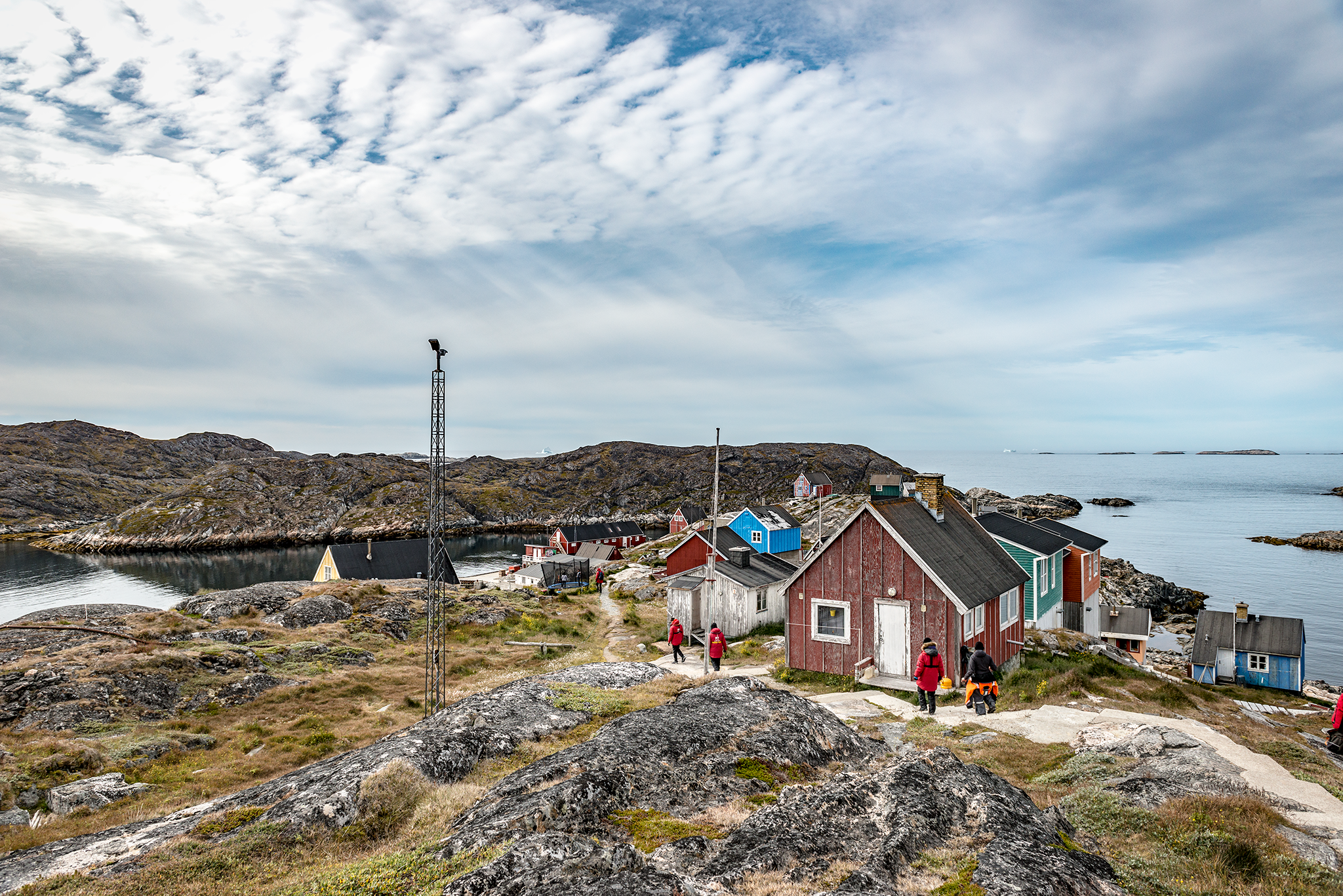
Ceras de colores repartidas por el suelo dan la nota de color. Al otro lado, el puerto deportivo. Pera y Pedro
encuentran una osamenta de caribú especialmente grande. Todo parece medio abandonado. Hora de regresar a la zodiac. Calculo que serían cerca de las 13:02 h cuando en aguas abiertas,
de ruta a Uunartoq, nuestro navegante vasco da la voz de alarma ¡Ballena, ballena! El espiráculo expulsa agua y la columna se eleva desde la superficie. El lomo da paso a una cola
enorme. Es una pasada verla majestuosa, cerca de nosotros. Sin perturbarla hacemos las fotos y la dejamos seguir su camino. Una hora después fondeamos en Uunartoq. Según leo,
la isla no tiene procedencia volcánica. Sus 3 pozas termales se mantienen entre los 37,7°C y los 60°C. Al llegar recibimos instrucciones acerca del #2, esta vez llevaremos una pala,
pero los residuos de celulosa deben recogerse. Una breve inspección a poca distancia hace que las instrucciones hayan caído en saco roto anteriormente. Mientras busco mi lugar doy cuenta
de la celulosa. El campamento ya está montado, solo tenemos que asignar las tiendas. Quizás por la noche en Narsaq o quizás por la ligereza del idioma, Jonathan me pone ojos
de cordero degollado y me apunta con él en la primera tienda. Antes de la comida, Nicola hace de modelo improvisado como náufrago varado. Fotos de los expedicionarios. La isla no es muy grande,
cerca de 5 km de largo. Comemos con el hambre que da la mala vida nocturna y esperamos el momento deseado de salir hacia los baños termales. Tiento a Lolo a una carrera por la playa y está claro
que está muy en forma. Corre medias maratones. Las termas nos esperan a 1 km del campamento. De camino barremos un sendero invisible de 100 metros de ancho a nuestro paso y recogemos basura
de expediciones anteriores (al gobierno danés debe encantarle recibir grupos como el nuestro). Antes, Konrad duda en ir. Dice que no tiene bañador. Corto de un plumazo el mal rollo y le doy el mío,
rehusando educadamente hasta tres veces. Le digo que es de mala educación en España negar ayuda y se queda contento cuando le reitero que tengo suficiente
con mi ropa interior. Acepta. Una vez allí,
Nora nos pide que dejemos la garita pequeña a las chicas para cambiarse. El tiempo empieza a torcerse. La caseta de los chicos es fría pero no hace falta más. Pintadas por todas las paredes
y bancos recorriendo el perímetro interior. Dejamos todo dentro. Fran decide irse a dar una vuelta y pierde el gorro. Pese a que me ofrecería a buscarlo posteriormente, ya no podríamos rescatarlo
por el brusco cambio de tiempo. La poza es pequeña y poco profunda, 1,30 m a lo sumo. Ya están todos dentro y me quito el calzón lo que hace que se convierta en el momento más relajante del viaje…y
el que más cachondeo levanta. Pedro encuentra una zona especialmente caliente escarbando con el pie y luego decide que es buen momento para volver al colegio. Fotos, vídeos, risas, descojone
generalizado y varios intentos de salir, pero fuera empieza a hacer realmente frío. Nora viene a avisarnos que la cena será en una casa cerca del campamento y que nos espera allí.
Saca foto de grupo y me excuso por razones obvias. Al salir me espera una muda seca y el calorcito de las mallas térmicas.
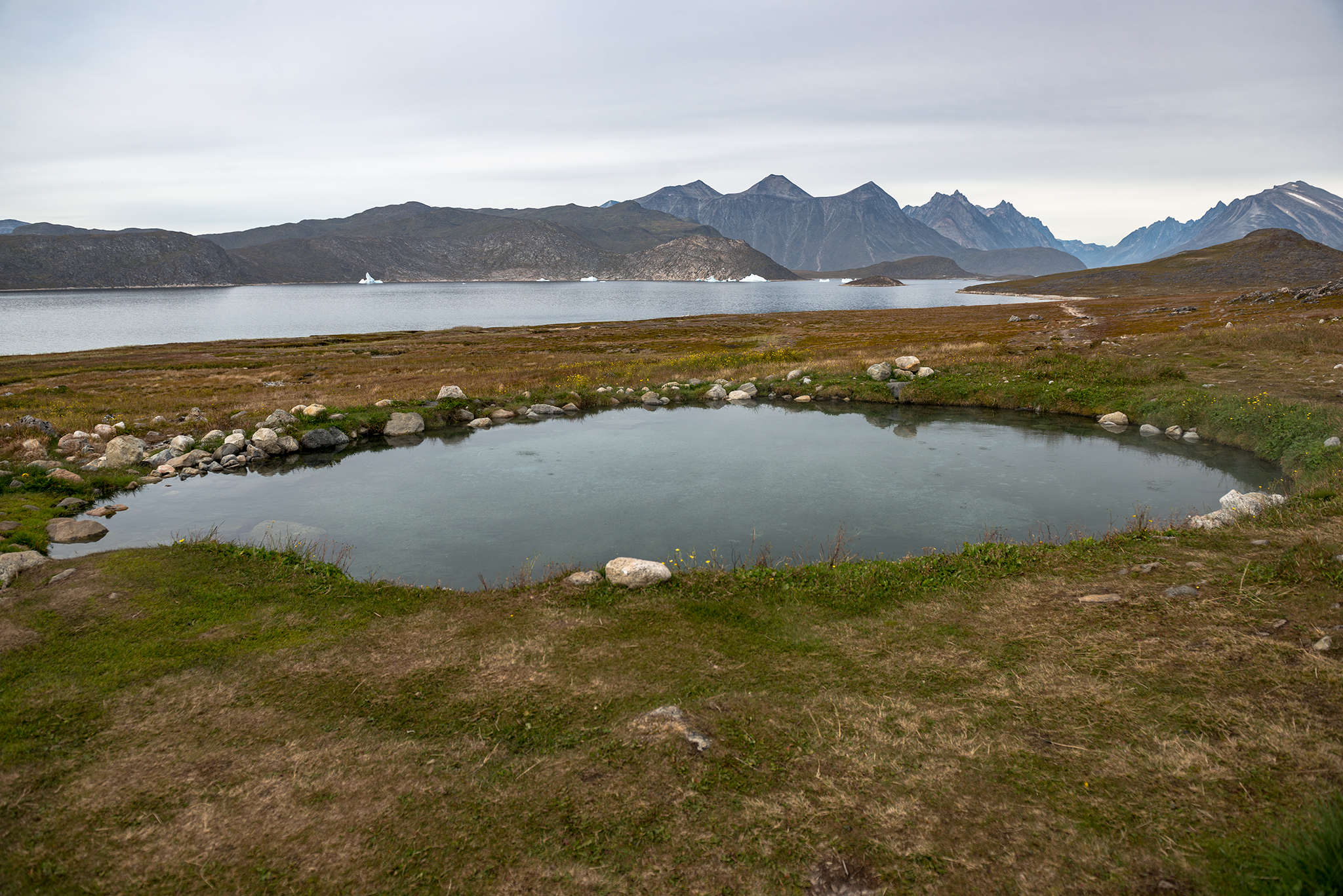
El tiempo sigue torciéndose. Hoy no tendremos auroras.
Pedro aprovecha para correr mientras el resto regresamos al campamento. Las nubes amenazan. De vuelta en el campamento, Marie y yo fumamos y respiramos. Un crucero pasa cerca.
A menos de 2 km subimos hasta una cabaña muy acogedora (y caldeada). Allí nos espera una pareja con dos perretes en la puerta. Saludamos educadamente y me fijo que uno de los canes está herido.
La mujer con un gesto me da a entender que ha tenido un percance. Nos deslizamos en la entrada. Allí, una pequeña estancia para dejar las botas comparte sitio con una cocina.
Nora está liada con la plancha. Otra antesala con pila y un banco sirve de asiento a la mujer que nos mira uno a uno. En el salón hay dispuestas dos mesas preparadas con velitas.
Un sofá y una estufa hacen compañía a unas ventanas decoradas con motivos que recuerdan a la navidad. Aquí casi todo recuerda a la navidad, las velas incluidas. Uno de los perros entra al
salón y se tumba con su amo en el sofá. Nora distribuye la cena desde una mesa pequeña para servicio ¡Sorpresa! Recuerda mi intolerancia a la lactosa y me tiene reservado un plato único de
salmón cortado en medallones que sabe a gloria. Repetiré, por supuesto, y Nicola también. La cena se acompaña con arroz y pan. ¡Taqanaq! Allí charlamos del avistamiento de
focas. Españoles a la derecha, foráneos a la izquierda, excepto Konrad, que ya estamos españolizando. El postre incluye chocolate y en la distensión de la cena no nos damos cuenta de que los
dueños de la cabaña también quieren descansar. Una vez terminados los quehaceres domésticos y con lacónicos qujanaq nos despedimos dando las gracias a los anfitriones y quedamos para desayunar
en la cabaña al día siguiente, tempranito y acarreando las tiendas desmontadas. La marea ha subido y no hay resto de la playa desde que volvimos de las termas. El agua se ha filtrado a través
de las rocas. Bajo la lluvia volvemos al campamento. Esa noche no sentiré la llamada de la naturaleza. Primera sorpresa campera: Jonathan, el navegante vasco y compañero infatigable, perfuma
sus botas, sus pies y la tienda que resiste los embates del viento y la lluvia. Cuando Nora pasa revista a las tiendas antes de dormir se siente embriagada ante el golpe sensitivo.
Lluvia ligera. La tienda Altus resiste. Ruidos de lanchas motoras amenizan la noche. Jonathan se remueve dentro del saco. Sueña.
Miércoles, 6 de septiembre de 2017
Nos levantamos pronto y siguiendo los movimientos de Nicola, el italiano guarda marina, desmontamos y recogemos la tienda. El resto de la expedición va dejando los petates junto con las tiendas
plegadas y guardadas en la playa. Desoyendo la orden de Nora dejamos todos los pertrechos allí y subimos a la cabaña para desayunar. Como era de esperar Nora nos recuerda las instrucciones dadas
anoche y desayunamos entre la duda y las argumentaciones varias. Volveremos tras el desayuno a la playa a recoger las tiendas y subirlas de nuevo a la cabaña. Asunto resuelto.
El ánimo se resiente lo justo y volvemos a cargar la zodiac. Capitán JJ al mando, nuestro destino será Tasiusaq del Sur, con el majestuoso Qasigootnoq oculto a nuestros
ojos a la llegada. De camino a Tasiusaq hacemos una breve parada en la mina de grafito de la isla Amitsoq. José Trejo, uno de los colaboradores de la expedición,
nos contará en Nanortalik que la isla es prácticamente inexpugnable. Con las manos manchadas de carbón recorremos el sendero Saputit no sin antes comer en
el mismo Tasiusaq y dejaremos a JJ navegar hasta nuestro destino final, donde nos dejará los petates tapados con una lona por la previsión de lluvias. Los vecinos ven a un grupo
de exploradores en un incesante goteo a la fuente del lugar mientras los niños están en el colegio. El tiempo no es tan malo para hacer la comida al aire libre y ya no nos acordamos del calor
de los primeros días. El pueblo es pequeño y guarda una terrible historia de hambruna y muerte. El crudo invierno de 1865 hizo que los suministros de comida y combustible no llegaran a tiempo. Muchos
de los que allí esperaron la llegada murieron y otros perecieron en la aventura de tratar de alcanzar las localidades cercanas tratando de buscar ayuda. Un pequeño monolito homenajea a las víctimas.
Tras la comida y el café comenzamos a movernos de nuevo e iniciamos la marcha desde el inverosímil campo de fútbol usado
como helipuerto con un barranco detrás cuyo sendero lleva a la chatarrería. Recorremos cerca de 10 kms charlando alegremente con Jürgen de fútbol y de cómo nos sorprendería Nora acerca del futuro
#2 en nuestro destino. De camino, los riachuelos se tiñen de rojo por las arcillas del lugar mezcla de magnetita y óxidos de hierro. Delante de nosotros aparece el primer caballo. Pese a verlo
en libertad tiene dueño. Sin ser altos, los caballos groenlandeses tampoco son pequeños. Son además muy fuertes y se usan sobre todo para recoger el ganado ovino y caprino del monte.
No le gusta mucho la compañía humana y decide aguantar el mínimo tiempo para que Pedro saque fotos. Dejamos a la derecha Nuugaarsuk y sus verdes praderas para adentrarnos
en una senda donde a lo lejos, y con nubes bajas se divisa una granja. La sorpresa del día es que a la vista del tiempo no dormiremos en campamento y nos alojaremos en una casa pintoresca
de cazadores, no demasiado lejos de la granja. Una perra muy entusiasta nos viene a recibir. Se llama Nuka. Previa carrera exploratoria de Pedro recorremos la granja y desde la playa nos dirigimos al punto
donde JJ nos ha dejado los petates. El camino para trasladar el equipaje desde la playa a la casa es amenizado por las carreras con la perra. La cabaña, que tiene forma de L, tiene una sola planta.
Unos escalones dan acceso a un pasillo estrecho donde nos descalzamos. Es propiedad de la tía de Tuperna. Allí descubrimos que nuestros compañeros españoles del otro grupo han secado nuestras parkas (la mía está colgadita y todo
en la puerta de una habitación. Más tarde descubriría quiénes fueron las responsables a las que les agradezco infinitamente el gesto). Nuka parece que quiere entrar, pero no.
Quiere jugar a atrapar las gotas de agua de lluvia que caen del techo de la cabaña. Llora cuando no hay lluvia que alimente sus ganas de jugar. Es una border collie que guarda un secreto.
Tras las carantoñas de rigor continuamos con la carga de equipajes incumpliendo constantemente la regla de oro antirrábica (y no sabíamos hasta qué punto). Entramos en la casa.
A la izquierda descansan nuestros bidones con las comidas para la expedición, siempre con nosotros salvo que los capitanes nos los trasladen como hoy, hasta destino. Tras una puerta un gran
comedor a diferente altura muy frío y una cocina repleta de víveres. Tenemos que caldear la sala antes de cenar, es tarde y la temperatura sigue bajando. Tenemos una chimenea de hierro y Pera
se ofrece a encenderla. En la cocina no hay agua corriente. Tampoco hay baños. Hemos subido la pala desde la lancha. Ya sabemos cómo resolveremos el #2. A la derecha del pasillo, un distribuidor
donde reposan decenas de pares de zapatillas y pantuflas de invierno de todas las tallas y para todos los gustos. El distribuidor lleva a dos habitaciones pequeñas y al final un gran salón
iluminado por grandes ventanales que dan una visión panorámica de 180° del paraje, ahora tapado por las nubes, con dos enormes sofás acotando una mesita, una mesa grande,
repisas repletas de objetos peculiares y otra chimenea. En la puerta del distribuidor una foto de Thierry Henry. Para encender el fuego de Pera salimos a buscar ramitas y la encontramos
en la misma puerta de la casa. Hay restos de una gran hoguera en el exterior y entre las cenizas colillas de Fortuna. Indudablemente españoles han pasado por aquí (Fran nos defendió a Marie
y a mi al descubrir Antonio una colilla en el suelo del Valle de las Mil Flores y señalarnos, dejando claro que ni una sola huella -no orgánica- de nuestro paso se quedó en Groenlandia).
Preparamos un cubo lleno de ramitas con los que Pera podrá iniciar el fuego. Tiene reservada varias piezas de madera para mantenerlo encendido durante la cena. Dejamos a Pera trabajando en el fuego
y Nora nos comenta que no hay agua potable. Nicola, Jürgen, Pedro y yo nos vamos a la granja con varias garrafas vacías y dos palabras para practicar: Imeq y Qujanaq. Reandamos el
sendero desde la playa que poco a poco va desapareciendo con la marea, con las nubes amenazantes sobre nuestras cabezas y seguidos de cerca por la perra. Al llegar a la casa,
la dueña observa perpleja a los cuatro fantásticos repitiendo Imeqs y Qujanaqs, cada uno de su padre y de su madre. Desde la ventana, nos ve cargar con garrafas
y nos manda a la parte de atrás. Allí la esperamos hasta que aparece de nuevo por unas escaleras y señala una manguera de la que mana agua. Inmediatamente contestamos con un qujanaq con tono algo más elevado
y nos damos a la tarea de rellenar las tinajas de plástico hasta que cinco bestias salvajes salen por la puerta y se colocan en las escaleras mirándonos. Y con aquellos máquinas de besos otro
border collie, Rudo, la pareja de nuestra nueva amiga que no puede hacer nada para que sus cinco cachorros se lancen a nuestro cuello. Nos pasamos la regla de oro antirrábica por el
arco del triunfo y mientras se llenan las garrafas nos dejamos agasajar por nuestros anfitriones. La madre no da abasto tratando de poner orden pero descubrimos que también le encanta jugar
con su juguete: una pelota. Mientras tanto el padre se resigna. Al final aparece el abuelo que únicamente observa tranquilo la escena desde las escaleras. Los cachorros solo quieren quedarse
dormidos entre nuestros brazos, buscando nuestro calor. Los aullidos de placer son cada vez mayores ¿Qué veníamos a hacer aquí? Varios qujanaq nos sacan de la ensoñación. Es hora de regresar
cargando el agua. Nuestros últimos qujanaq de agradecimiento a la señora le arrancan una carcajada. Nos ponemos en marcha y la perra se vuelve más loca aún tratando de detener el avance de sus
cachorros. No muy lejos de allí el granjero trabaja con su tractor en sus tierras. No queda ni rastro de la playa. Resuelto el tema del agua, la expedición descansa, lee o dormita en la cabaña.
Al fondo suena Alejandro Sanz. El fuego está encendido. Con un té y café caliente saco a colación el tema de los cumpleaños por si algún viajero ha decidido celebrarlo con nosotros a lo largo
del viaje y resulta que tenemos dos. Chris y Marie. Un marco incomparable para una celebración de ese nivel. Entre los bancos del comedor me encuentro un tebeo de Ben-hur….en groenlandés.
La perra ha vuelto hasta la casa para jugar con las gotas de lluvia mientras ladra a su pareja para que vuelva con los cachorros a la granja. Mano dura. Agacha la orejas y vuelve sin chistar.
Además, la perra quiere correr. Tiene muchísima energía y no para quieta. Antes de cenar y a raíz de la estupidez que se me ocurre de terminar las frases en francés de nuestras compañeras
francófonas con un “by Jean Paul Gaultier”, Pera nos saca su equipo de supervivencia. Se compone del mínimo material para traer la civilización hasta los lugares más remotos. Incluyen varias
esencias y perfumes. Me unta la muñeca con One Million, de Paco Rabanne y ése simple gesto será uno de los motivos por los que Nuka se volverá aún más desequilibrada. La cena es distendida.
Todos están calientes y dicharacheros. Como de costumbre se repartirán los turnos de limpieza de cocina. Mañana será mi turno en el desayuno con Jonathan. Tras la cena y con noche cerrada cojo
la pala y el frontal. Nuka aún tiene ganas de jugar y tras varias carreras los dos buscamos un lugar apropiado para sepultar mi ego. Las nubes cubren todo el paisaje y pese a la oscuridad algo
empieza comienza a revelarse en dirección el norte.
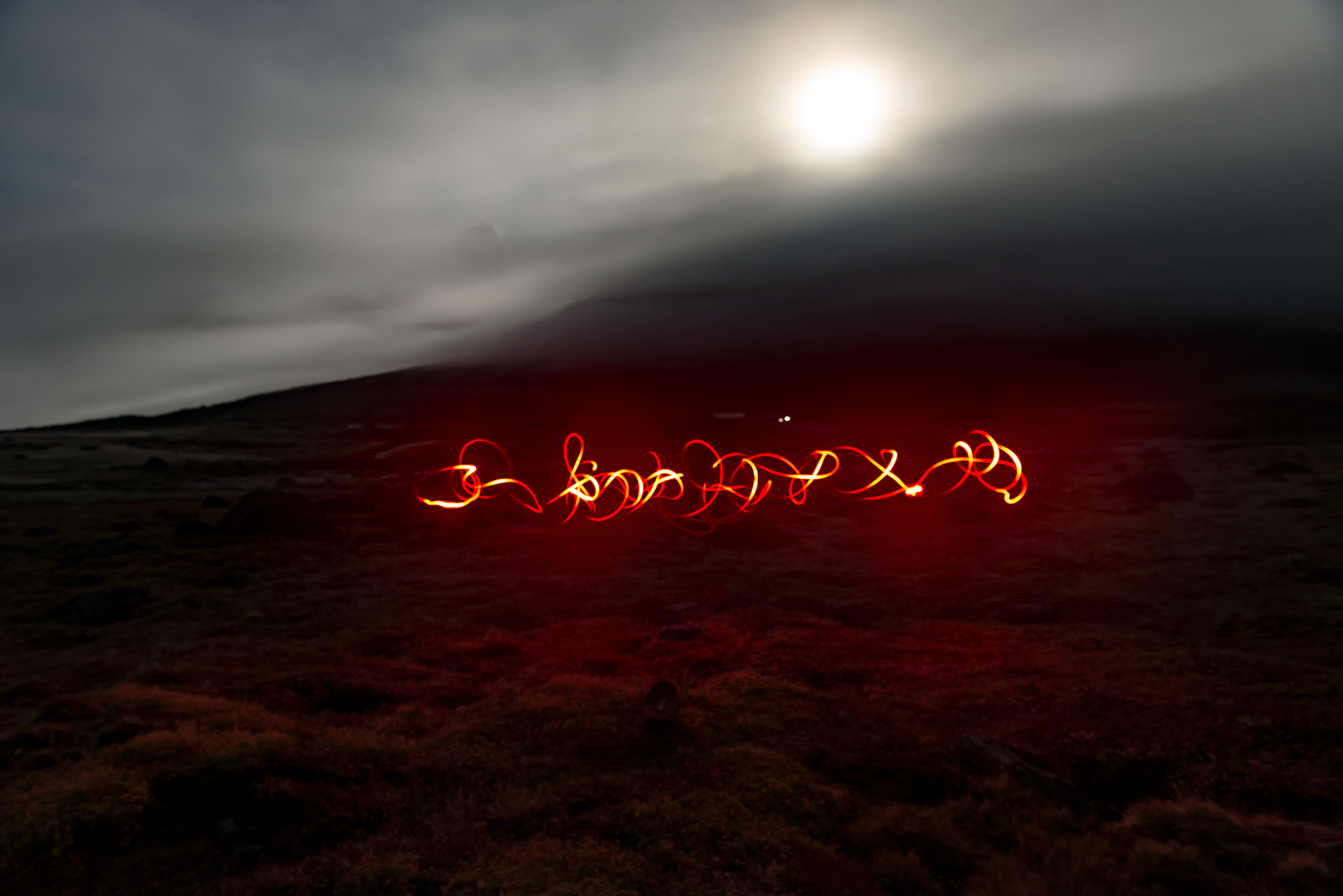
La bruma se disipa y la silueta majestuosa del Qasigeetneq se recorta con la luz de la Luna Llena (Luna de la Cosecha
o Luna del Maíz) que comienza a romper las nubes. Tukik es el dios masculino de la Luna y cuenta la leyenda que es capaz de dejar embarazada a toda mujer que esté sola
trabajando hasta tarde en una noche de luna llena, por lo que en días de plenilunio, las mujeres evitan estar hasta tarde a menos que quieran quedar embarazadas… Saco la cámara y el trípode.
Hay una extraña agitación pese a no ser una noche de auroras. Stephane y Chris se apuntan a la fiesta. Lolo y Marie también y quedan retratadas. Cumplidos mis respetos a la montaña le doy a Lolo
mi frontal con luz roja y entre carcajadas le pido que corra de izquierda a derecha moviendo el frontal con la mano como una loca. El lugar tiene algo especial y nosotros hemos llegado en el
momento adecuado. Es la atmósfera de niebla y luz de Luna recortando las siluetas de las montañas. Veo a Jonathan tras uno de los ventanales del salón preguntándose qué coño estamos haciendo.
Tras las risas llega el momento de la despedida por hoy. Entro de nuevo en la casa, me descalzo, me despido de la perra desquiciada que aún quiere jugar, y alcanzo el salón. Me han reservado
un sofá donde tendré una visión mágica que, junto con la polifonía de mis compañeros, me harán caer en un profundo sueño.
Jueves, 7 de Septiembre de 2017
Pasamos la noche y desayunamos con fuerzas mejoradas. Finalmente y aunque con frío, la casa nos ha respetado el descanso. Hoy nos recogerá JJ para ir al glaciar Tasermiut y al
campamento del mismo nombre. Al despertar Nuka sigue montando guardia a la puerta. Desayunamos sabiendo que tras la puerta podemos encontrarnos con las bestias salvajes de ayer y entre los
nervios hacemos el petate, limpiamos los platos y arreglamos la casa antes de salir. Y allí fuera, llega Rudo con cuatro de los collies dispuestos a devorarnos a besos. Entre juegos le pido
a Chris que coja mi cámara y me saque una de las fotos más bonitas que me han hecho del viaje. Aprovecho para retratar a Lolo con sus nuevos amigos que dejan de temblar en el mismo momento que ella
los coge en sus brazos. El tiempo pasa y no sabría decir si fueron una o dos horas de relax (poco importa el tiempo en aquellas latitudes). Retrato a Nora, que es otra loca de los perros.
Al rato un silbato nos devuelve a la realidad. Los perros deben regresar a la granja y nosotros tenemos que empezar a cargar los fardos hasta el embarcadero. Marie y yo acompañamos a los canes
un centenar de metros y Jonathan me regala otra fotografía fantástica ¡Ya sabe manejar su nikon en manual! Volvemos y hacemos el triste camino hasta el change2change donde un par de cachorros y
la perra nos vigilan. De toda la camada solo se quedarán con Paplo. Iniciamos la marcha en la zodiac y observamos a Nuka despedirnos desde las rocas. No volveremos a verla.
El resto del viaje muchas de las conversaciones se centrarán en los puppies.
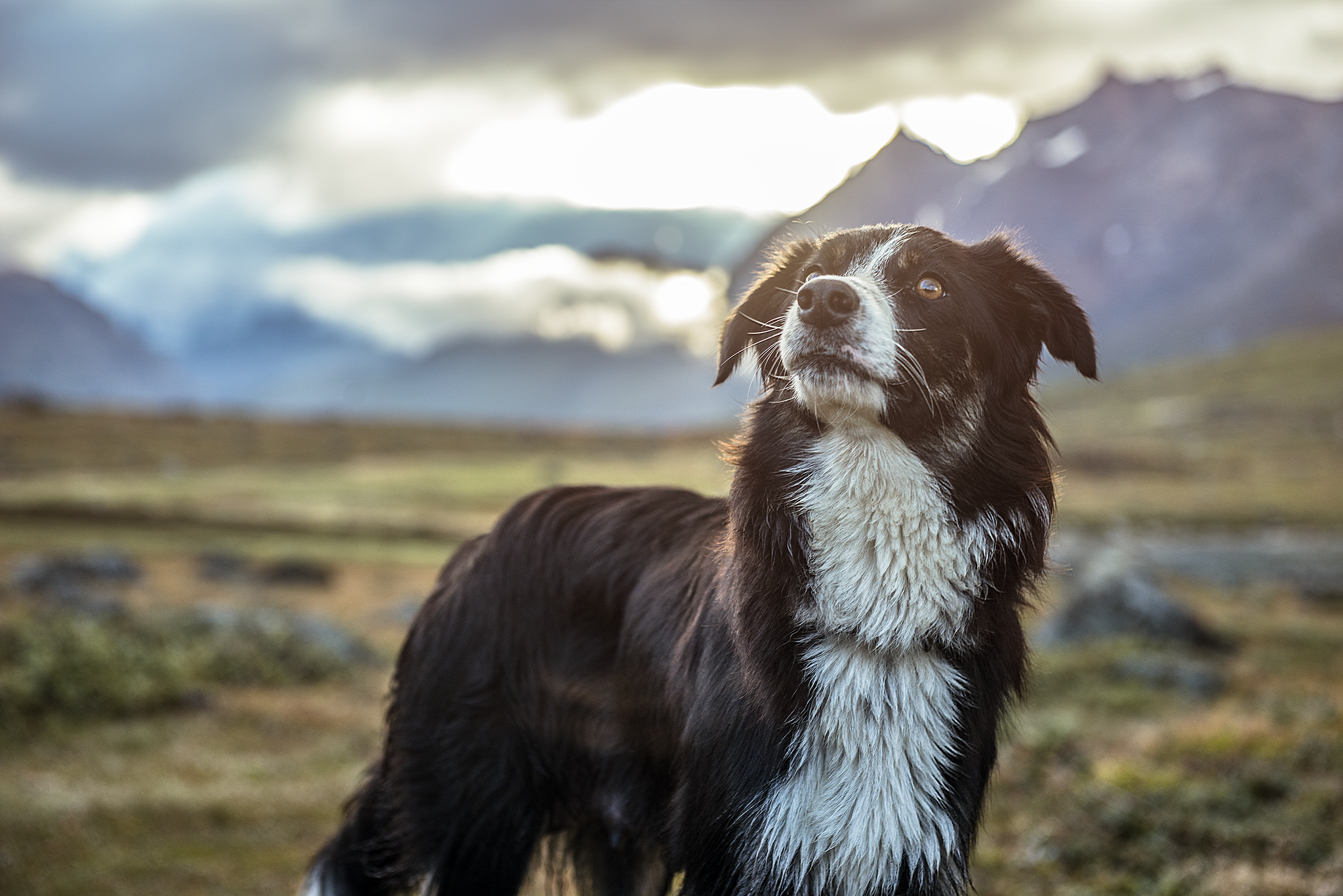
La travesía por el fiordo de Tasermiut está flanqueada por enormes montañas que parecen surgir del fondo del fiordo desafiantes.
Al final comienza a dibujarse el perfil
del glaciar. Todos estamos locos por bajarnos y sacar fotos. Fran decide permanecer en la lancha. Recibimos instrucciones de Nora. Las órdenes de JJ son claras: no más de tres fotos…y cumplimos
como podemos. Tres fotos por minuto, tres fotos por segundo…El grupo se disgrega buscando el mejor ángulo, la mejor visión del glaciar, siempre alejados de los puntos delicados donde no podemos
controlar posibles desprendimientos de grandes rocas. Aprovecho para retratarlos uno por uno. La pared de hielo cae a plomo 1240 metros hasta el fondo del fiordo. Cogemos con nuestras manos bloques
de hielo con miles de años de antigüedad en un entorno claramente dañado por el retroceso del glaciar. En el punto de desembarque la piedra está desnuda y fuertes cascadas son la prueba de la
muerte de la lengua glaciar. El entorno no deja de ser mágico y me pregunto cómo sería verlo en su esplendor. JJ nos pide que regresemos a la lancha. Mientras la expedición toma posiciones termino
de retratar al equipo. El campamento de Tasermiut nos espera.
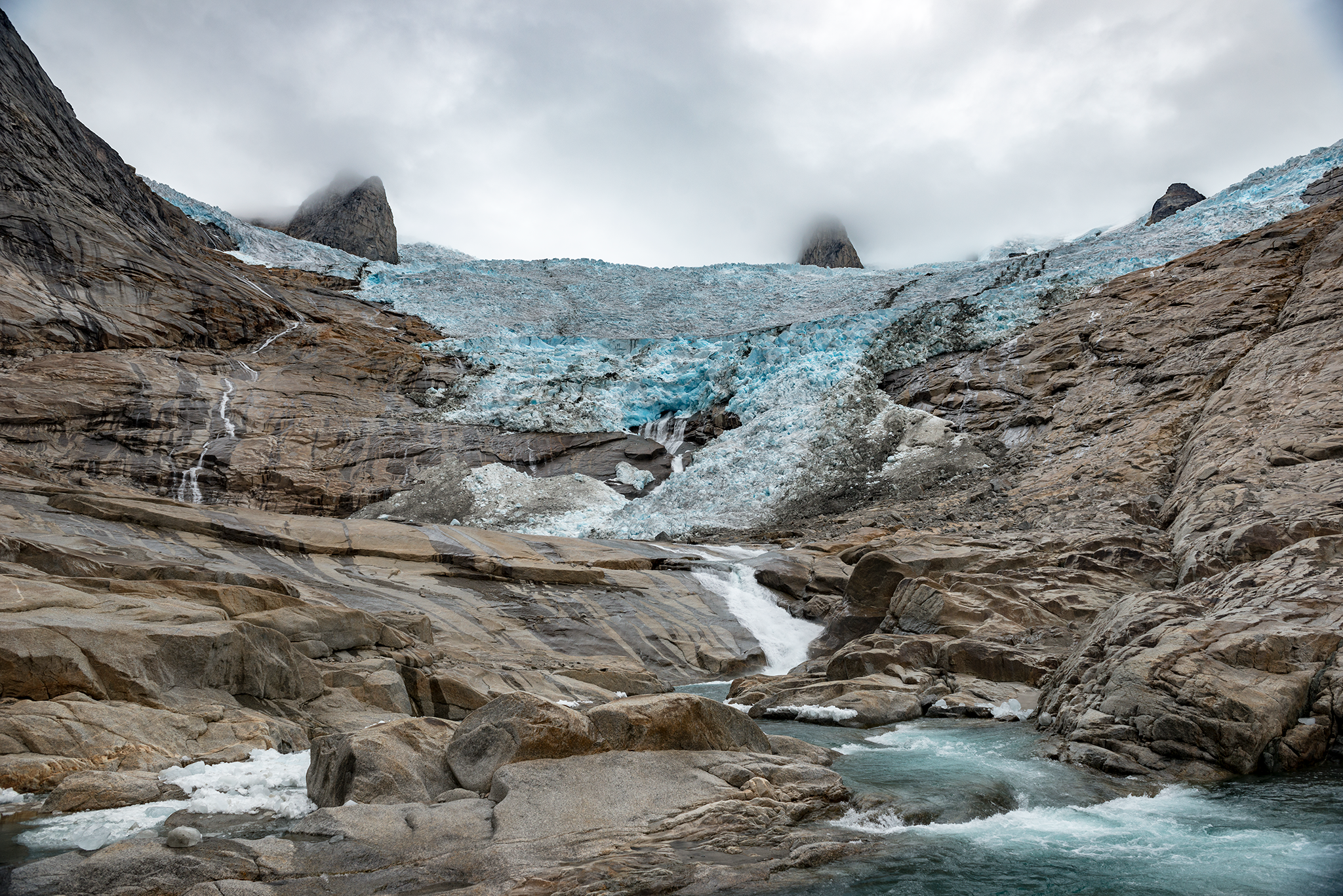
Una travesía rumbo sur para arribar a una localización acotada por grandes montañas. Atracamos en una playa.
Un grupo de españoles nos espera. Son testigos de nuestro brioso (y cómico) change2change. Entre ellas están las chicas que me “salvaron” del ataque del mosquito gigante en Keflavik y que además
se ocuparon de colgar las parkas para que se secaran en la cabaña de cazadores del día anterior. Toca cargar con petates, fardos, comida y resto de enseres hasta el campamento. Desde la playa hay
un desnivel de unos 50 metros y con el sol notamos el calor del esfuerzo. Afortunadamente otro grupo que hoy abandona el campamento ha dejado montada las tiendas y sentimos alivio después de cargar
al sol. La tienda domo de la cocina está aún más alta que el propio campamento. Compartiremos asentamiento con el grupo donde también están los españoles de edad avanzada. Tenemos nuevas
instrucciones para los #2: bolsa de basura negra + bolsa de basura blanca = bidón comunitario únicamente para residuos orgánicos. Los residuos celulósicos irán en la bolsa blanca. Y sí,
tendremos que desmontar todo al partir, y sí, Pedro cargará con el bidón comunitario hasta la zodiac. Tenemos una hermosa cocina-comedor espaciosa. Dos hileras de bancos unen dos mesas y son
capaces de dar servicio a los 13, con cocina, mobiliario y estanterías varias. Además, tenemos un enorme arcón de plástico a nuestro servicio. El paisaje es impresionante. A la derecha el
Ulamertorsuaq domina la vista. En el centro, al fondo de un valle, se perfila el Nalumasortoq. Reparto de tiendas y comida en la tienda domo. El cielo despejado
augura una noche espectacular en el campamento y así se lo hago saber a Stephane y Chris (a veces una corazonada parece cumplirse y no será para menos). Nos ponemos en marcha. Avanzaremos por el
valle, cruzando el río por un puente tibetano, parando en una tumba de invierno inuit y una caseta que sirve de refugio. Nora nos cuenta que los outsiders de Groenlandia que salen de la sociedad
por diversas razones pueden regresar, y en ocasiones pueden chocar con los habitantes tras tantos años viviendo fuera de las conductas que los daneses tratan de mantener entre los lugareños.
Sobre nosotros el Nalumasortoq (2045 m). Una montaña con forma de libro que visitaremos mañana. Fotos de cortesía, descanso para observar el entorno y regreso al campamento.
Tras la cocina un pequeño río y sobre el río un puente hecho de tres tableros de madera, desde donde llenaremos las garrafas y haremos la limpieza pertinente de platos, cubiertos, ollas y sartenes
(puede parecer extraño pero aconsejo que aquellos que tengan la piel delicada y sensible ejecuten estas maniobras nocturnas con guantes). Y tras la cena, como siempre puntual, la tormenta.
Las luces más espectaculares del viaje. Electrones del Oxígeno y Nitrógeno danzando de forma salvaje cruzando todo el cielo, excitándose y cayendo de nuevo al estado fundamental. Sin palabras.
El momento me pilla con la cámara y el frontal en la tienda. Disfrutamos el regalo. Stephane, Chris y Jonathan junto con Nora y otro guía sí tienen las cámaras a mano. La expedición se moviliza.
Tras la agitación celeste, que incluyen rojos, verdes y amarillos, el cielo comienza a relajarse. A veces ignoro mi intuición y finalmente caigo en la cuenta demasiado tarde. Pero allí estábamos,
todos impresionados con aquella escena jamás antes soñada. Con la excitación del momento comienzo a sentir que el frío es intenso. Nora y el otro guía musitan al unísono como en una letanía distante,
Immaqa, quizás, puede que sí puede que no, como respuesta a una pregunta formulada acerca de puede que vuelvan a repetirse esa misma noche. Estamos en un entorno realmente
deshabitado, lejos de la civilización, donde los zorros pueden hacernos una visita con simplemente dejar al aire comida. La norma antirrábica en caso de los zorros es más estricta.
Viernes, 8 de Septiembre de 2017 ¡Felicidades Chris!
Amanece en Tasermiut. Sobre las paredes del fiordo despunta Napasorsuaq, La Catedral (2030 m). Inexorablemente, cada #2 es celebrado con un paseíllo triunfal.
Tras el desayuno recogemos los enseres del picnic. Hoy nos moveremos a los pies del Nalumasortoq, más conocido como El Libro. La subida desde el campamento se realiza entre
morrenas y ríos. El sol vuelve a pegar fuerte y desde la distancia las nubes comienzan a posarse lentamente en la cara norte del Ula, que dejamos a la derecha. Nora nos cuenta la historia de un
chaval mejicano que esperó a que su padre escalara esa misma cara norte tiempo atrás. Al final ya se divisa el Nalu. La inmensa mole se forma con tres enormes pilares de forma que el resultado
recuerda a un libro abierto. Sobre la marcha paramos a descansar, picar y beber, mientras no paramos de sacar fotos. Esos ratitos unos aprovechan para dormitar. Las cascadas rompen la pared que
dejamos a nuestra izquierda y en las faldas del Libro paramos a comer. El picnic se hace con las nubes comenzando a cubrirlo todo. Terminamos pronto y Chris lanza el drone. Hoy es su cumpleaños.
Tiene una pinta tremenda. Instantes después reanudamos la marcha subiendo hasta una cuenca glaciar vacía, a unos 150 m de desnivel. Estamos en las tripas de un glaciar de miles de años:
un glaciar completamente seco en el sur de Groenlandia. Antes de regresar, desde un punto alto, lanzo una panorámica para recoger el lugar.
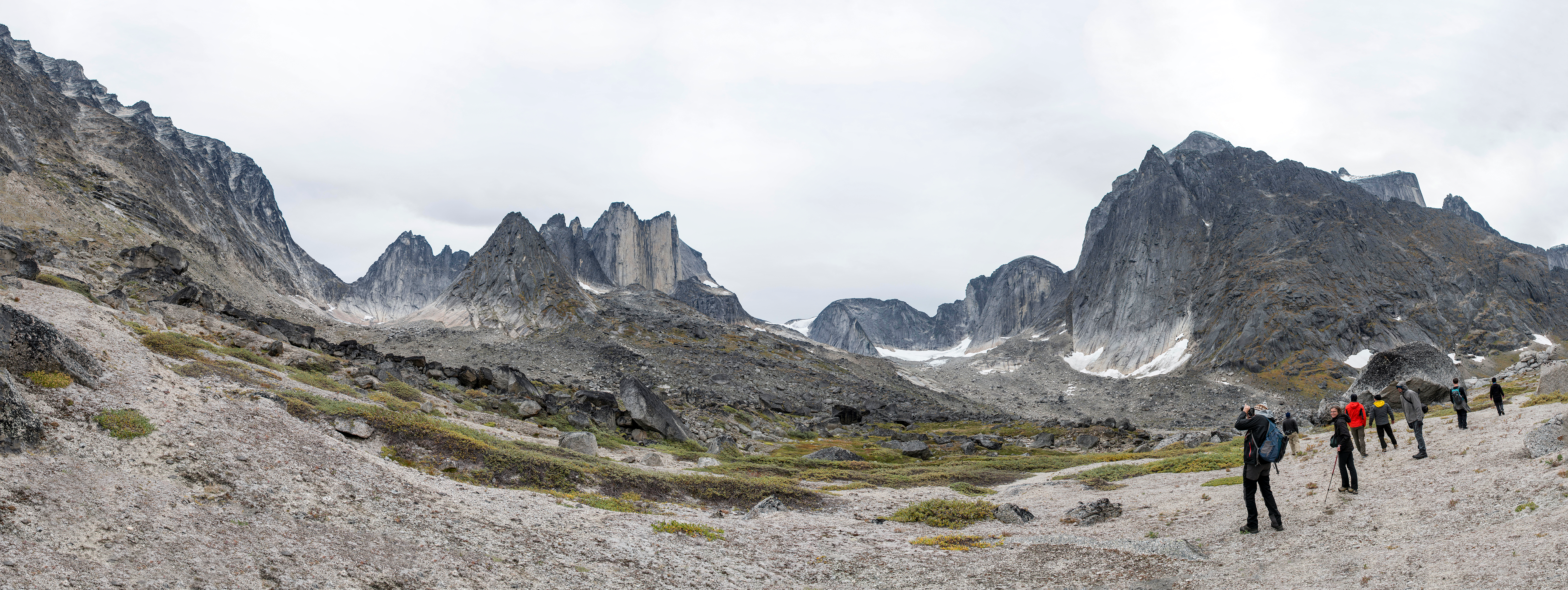
La expedición desciende cantando explotando
toda la producción musical de dibujos animados de los 70’s y 80’s. Durante un rato es llevadero pero pasado un tiempo comenzamos a taladrar oídos y alejamos animales. Rompemos la magia del
momento por lo que callamos y seguimos descendiendo.
Al fondo del fiordo el sol trata de romper las nubes y provoca un atardecer pintado de colores brillantes. El grupo llega más cansado pero aún así sacamos fuerza para continuar disfrutando
del entorno mediante las artes de la pesca. Nicola ha preparado en el desayuno un cebo y Pera probará suerte. Mientras Pedro está corriendo por la playa, ambos tiran la caña y no consiguen
resultados. Sin meterles presión les decimos que la cena depende exclusivamente de ellos. Nicola tiene una captura sin muerte de un pequeñín y lo devuelve al fiordo. Pera tiene la feliz idea
de que yo pruebe. Es la primera vez que cojo una caña y estoy como pollo sin cabeza, oyendo instrucciones en castellano e italiano. La agarro con fuerza porque tengo la sensación de que se me
va a escapar al agua y me tocará sacarla de las gélidas aguas del fiordo. Dos veces la lanzo y aunque no hay suerte la sensación es buena. Empieza a hacer frío en la playa y mientras Nicola
sigue intentando pescar la marea sube y vamos moviendo la caja de los anzuelos. Cuando el aire empieza a remover la atmósfera ya estamos recogiendo las parkas para ir a la tienda Domo a cenar.
Lluvia fina. La cena transcurre con gotas cayendo del techo que no auguran una noche de luces del norte. El tiempo, relativamente estable hasta ese momento, iba a enseñarnos sus dientes.
Confidencias bajo el parapeto de rocas y despedida hasta el desayuno. La lluvia y el viento se vuelven más y más intensos. En la tienda, perfumada una vez más para una noche de vientos huracanados,
uso la parka como almohada. Este simple gesto me mantendrá secos sin saberlo tanto el saco de dormir como la cabeza. Nuestra tienda está orientada EW y mi lado es barlovento, con las cabezas en
el oeste. Tratamos de dormir ignorando el huracán que recorre Tasermiut. Son los vientos catabáticos, creados por el llamado efecto Foehn. A mitad de la noche despierto.
La lluvia cae horizontalmente y campa a sus anchas dentro de la tienda. La zamarra está calada y parte del suelo de mi lado está empapado a la altura de la cabeza. Al grito de “¡Jonathan,
despierta, nos hundimos!” trato de despertar al navegante que con su arrojo natural me contesta: “Sí, en tu cabeza”. El gigante vasco no cabe en la tienda y duerme en diagonal.
Se gira y continua durmiendo. A grandes males, grandes remedios. Al día siguiente le explicaré en el desayuno entre risas porqué se despertó con mis pies en su cara.
Sábado, 9 de septiembre de 2017
La revisión de la tienda al amanecer da como resultado que solo una esquina estaba mojada: La mía. Afortunadamente, el resto está intacto, petates y botas incluidas. Tensamos de nuevo las cuerdas
y lo dejamos preparado para una segunda noche movida en caso de ser necesario. Última noche en Tasermiut, rebautizado en mi mente como One Ton Camp. Hoy la marcha
se dirige al Ulamertorsuaq (Gran Cilindro). Para nuestro asombro el grupo maduro de españoles mantiene la ley y el orden a base de plomada. Desde el interior de la tienda,
mientras recojo, oigo a una mujer española increpando a alguien. Es Marie. La mujer española no entiende porqué ha metido papel en la bolsa blanca, siguiendo instrucciones de Nora. Cuando me acerco
y pregunto cuál es el problema me dice que así no se hace. En el momento le ruego que nos instruya y me contesta sin dudar que la bolsa blanca es para guardar las bolsas negras y blancas de repuesto…
que son de plástico…por si se mojan. El tiempo me da la razón, el grupo de españoles no era buen grupo para viajar. Río con Marie y olvidamos el asunto. Ellos ya abandonan el campamento y será
nuestra última noche en Tasermiut solos. Desayunamos entre risas y con un día menos aterrador que la noche. En las cimas se ve claramente que ha nevado esta noche. Ayer la
temperatura bajó pero la sensación térmica era aún peor. Dejamos las parkas mojadas en “La Cueva” para que se sequen. Iniciamos la marcha al Ula con más ganas aún. Charlas amenas de El Señor de
los Anillos, del Silmarillion, de películas en general y de Fuju. El dragón es de la historia interminable, de la novela de Michael Ende que se rodó entre Alemania y EE UU. Primera pista.
Durante buena parte de la marcha nos dedicamos a reírnos del peor actor del mundo (decide tú quien es, allí lo teníamos muy claro) y de ”grandes películas de mierda que molan”. A la derecha
un valle glaciar divide el Ula y el Sulkkuasuuaq. Las vistas son imponentes. El calor vuelve y el frío y la humedad va cediendo. Había leído que los temporales no duraban mucho
tiempo en Groenlandia y el tiempo lo está demostrando. Al levantar la vista la cima troncocónica del Ula se niega a enseñarnos su rostro. Tras el picnic en la zona segura del Ula y mientras la
expedición descansa, persigo cacas de liebre a la búsqueda del zorro ártico.
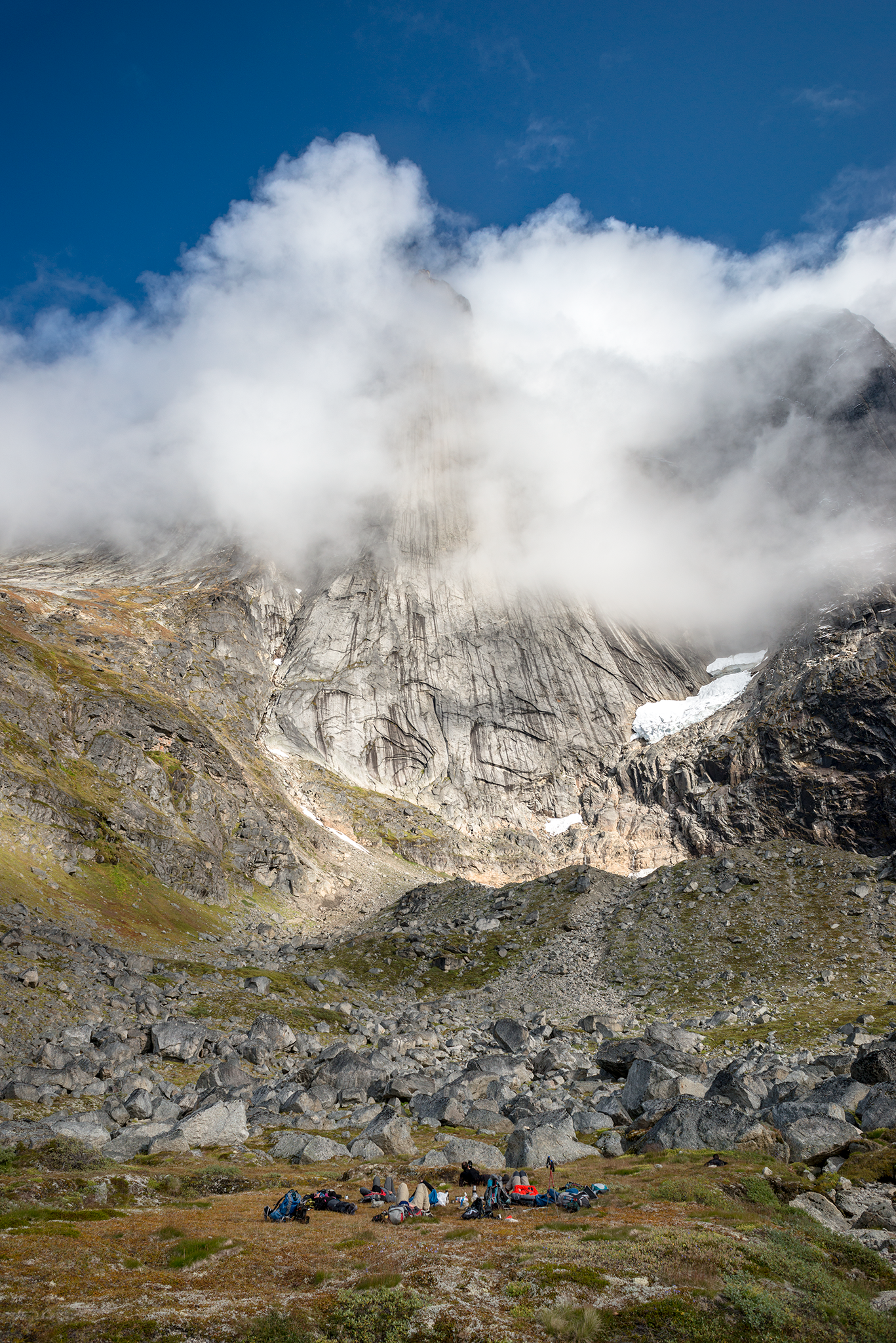
Sobre las rocas campanillas y flores de Groenlandia, Niviarsiaq, la flor nacional. Su traducción
es “mujer joven, muchachita”. Sobre la chimenea las nubes giran una y otra vez, recargándose y atrayendo nuevas nubes. Una vez descansados subimos un sendero de cauces secos que nos llevan hasta
la misma olla del Ula. El río discurre fuerte a nuestra derecha y en septiembre nuestro lado es un reguero perdido. La olla está totalmente vacía. Más fotos y comenzamos el descenso. Aunque hay
nube hoy no me separaré de la cámara. Descendemos sin prisa, y nos giramos de vez en cuando para observar la cima, que no desvelará sus secretos hoy. En la cena, Carlos Mejía Godoy y los de Palacagüina. Segunda pista. Le agradezco a Pedro que me dejara el cortaúñas pero parece que no será
necesario: ya no hay uña. Un problema menos. Fuera, en la inmensidad del fondo y bajo el manto de estrellas groenlandés, le pido a Nora que me cuente una leyenda groenlandesa. Risueña me narra
la historia de Sedna.
"Cuentan los viejos que alguna vez existió una muchacha joven, hermosa y de largos cabellos negros llamada Sedna que vivía con su padre. Nadie buscaba casarse
con ella llegada la edad para hacerlo, pero un día vio desde su cabaña un magnífico velero capitaneado por un apuesto cazador extranjero. El capitán se enamoró inmediatamente de ella y después
de haber sido seducida con palabras llenas de promesas y tesoros se marchó con él. La joven cayó en la desesperación al enterarse que la verdadera identidad del cazador era la de un chamán,
capaz de cambiar de forma. El padre, oyendo el llanto desesperado de su hija, se aventuró en su kayak a través del océano hasta que dio con ella. La encontró sola y huyeron, pero cuando el
chamán regresó en forma de pájaro y se percató de la partida de su amada, enfureció y partió tras ellos. El pájaro, ciego por la cólera, desencadenó con sus poderes una rabiosa tempestad al ver
que el padre se negaba a devolverle a su querida niña. Con los ojos envueltos en lágrimas, el pescador comprendió que la voluntad del mar era raclamar a su hija y aterrorizado lanzó a Sedna a las
frías aguas para consumar el sacrificio. En medio de la desesperación, Sedna salió a la superficie y se aferró al kayak de su padre con los dedos congelados. Al verse en peligro, el padre cortó
los dedos de su hija que se convirtieron en peces y focas pequeñas, de igual manera los pulgares y las manos se transformaron en morsas, ballenas y todos los animales marinos. Tras la feroz
escena, el océano calmó la furia desatada por el chamán y Sedna se hundió para siempre en el fondo del mar. Los inuit creen que cuando los pecados de los hombres, que siempre van al mar, han
contaminado el océano, los largos y negros cabellos de Sedna se enredan. Dado que ella ya no tiene manos para peinarse llora y se enoja, por lo que los animales marinos se alejan de las costas
y acuden a consolarla. Cuando los inuit empiezan a pasar hambre saben que es hora de confesar su atentado contra la naturaleza y salen en gran número al océano a bordo de sus embarcaciones,
a peinar el mar, limpiar y desenredar así los cabellos de la hija del pescador".
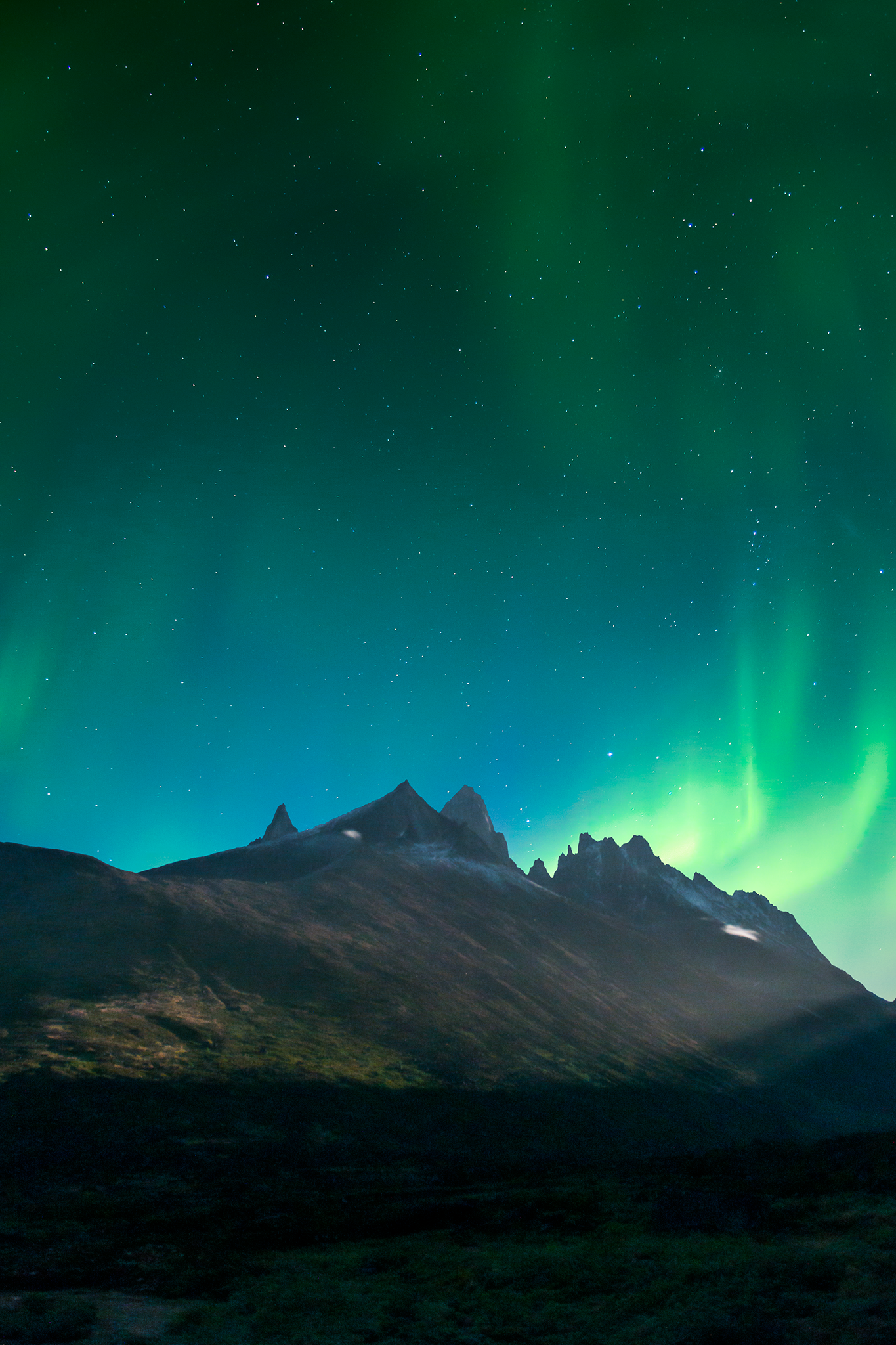
Agradezco a Nora el momento mágico del Tasermiut. Para quitarme el mono, monto la cámara en el
trípode. Tenemos auroras, pero hay demasiadas nubes y la Luna está saliendo fuerte por detrás del Ula. El resultado no es menos conmovedor. Un silencio recorre el campamento únicamente roto
por los obturadores de las cámaras, las verdaderas “outsiders” de la expedición. Saco una foto nocturna del fiordo que me ha cobijado estas tres últimas noches. Mañana será un día duro.
Tendremos que desmontar todo el campamento, cocina y enseres incluidos, y cargar todo de nuevo en las zodiacs. Hoy no habrá lluvia y la noche será plácida y fría a la luz de la Luna en
Tasermiut, donde Sila domina todo.
Tuesday, 5 September 2017
Sunrise and children go to school riding their bicycles. 07:30 AM Narsaq begins to have the rhythm of Tuesday. Breakfast in the hostel with inuit tablecloth included. Free time
to stroll by Narsaq before sailing again. Today our pattern will be the Captain Jürgen “Clooney” (no, the nickname neither is mine) in the Inuk 1
(singular of Inuit, “The People”) and during the travel course SE, it will sound Iron Maiden, David Bowie and Queen, among others as Nirvana. We visit the outsides of Henrik Lund’s House,
a preacher and poet that composed the hymn of Greenland in 1916, the Nunarput utoggarsuanngoravit, (You, our old land/home). Nora wears a pendant around her neck with the profile
of the island and indicates us that we can buy this kind of handmade works in the workshop of the city, but it’s closed today. By obvious reasons the flowers are made of plastic in the cemetery.
We find the supermarket, the building that last night we confused with the hostel, the school and with anything… less a shop. The first thing that I see inside is a Spanish guitar. I’m asking
myself if it’s fine-tuned? Yes!!! After two chords I appreciate to the worker that look at me in the contiguous shelf for not report me. Spanish products everywhere. Check this: after the counter,
medicines, tobacco and …bullets. By this order. Time to go back to the hostel and carry the travel bags to the Inuk 1. At the side, a typical cabin-shelter. Narsaq is big enough
to miss the way of life of the people and the great chimney of the gastronomy school. Also is bright enough at night to want to go out running, abandon the civilization and lose us in our next
destination: Uunartoq, hot springs island. We do a brief stop to visit Saarloq, a small island facing the ocean, with 32 inhabitants (2015). The access is
complicated from the boat by means of a metal ladder in the wall of rock. It seems a ghost village. Two little girls have fun on a jumping bed laughing. An old dog observes us and approaches
affectionate. It has lived better times and Nora comments me that it's always is here. At the top an antenna shares space with a cemetery. Color waxes delivered by the ground give the note
of life. To the another side, the sportive port. Pera and Pedro find a caribou horns. Everything seems abandoned. Time to return to the ship.
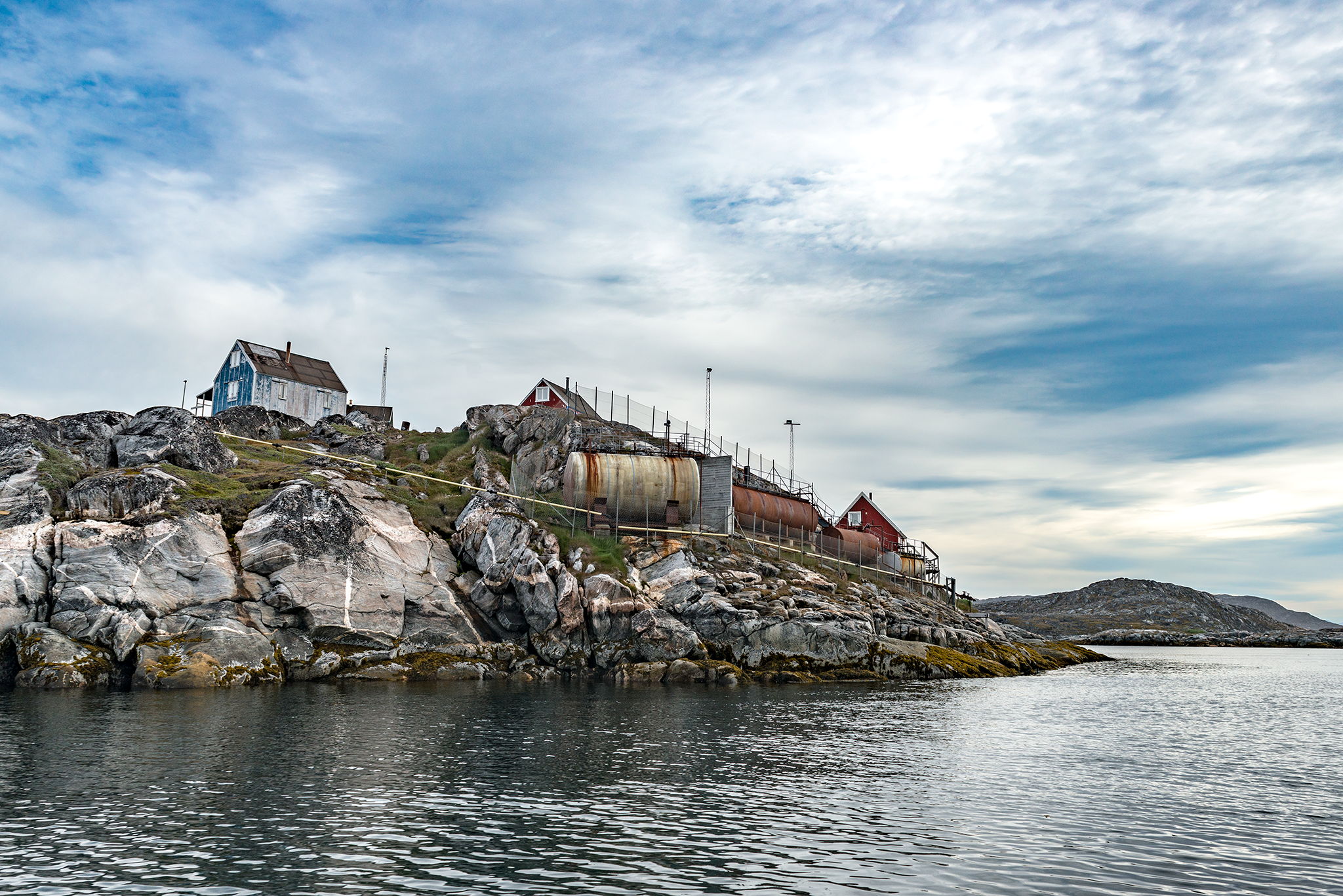
I calculate it's close 01:00 PM when, in open waters
on route to Uunartoq, our basque navigator gives the voice of alarm “¡Whale, whale!” The spiracle expels water and the column elevates from the surface. The huge tail gets up
and the whale disappears on the bottom of the sea. Without disturbing it we do the photos and leave it continue on its way. One hour after the majestic and slow dance with the whale we arrived on
Uunartoq. The origin of this island is not volcanic. Hot springs keep between the 37,7°C and 60°C. Once landed we receive instructions about the #2, this time we will carry a
shovel, but the waste of cellulose must be collected in a bag. A brief inspection to short distance show that the instructions have fallen in a broken sack previously. The camp is ready and we
only have to assign the tents. Maybe for last night in Narsaq or perhaps by the lightness of the language, Jonathan shows his slit lamb eyes and aims me with him in the first
tent. Before picnic, Nicola will be my improvised fashion model as a castaway. Picture of the crew. The island is 5 km long. We eat with the hunger that gives the bad nocturnal life and expect
the moment wished for swimming in the hot springs. I play with Lolo on a run over the beach and she’s very fit. Hot springs waits for us to 1 km of the camp. On the road we collect rubbish of
previous expeditions (Danish government must love to receive groups as us). Before, Konrad doubts in going. He says that does not carry swimsuit. I cut at one stroke and give him mine, rejecting
for a while the gift. Finally he accepted it and remains happy when I reiterate him that I have enough underwear. Once there, Nora asks us that we leave the small cabin to the girls.
Weather begins to twist again . The man cabin is cold but does not do lacking more. Fran decides to go for a walk and loses the wool cap. In spite of that I would offer me to look for it later
but we could not rescue it by the brusque change of weather. Hot spring is small and no so much deep, 1.30 m. I decide to remove me the underwear cause I’m thinking it would be a good idea
…and then the crew start to laugh. Pedro finds an especially hot zone digging with the foot and afterwards decides that it is good moment to go back to the school. Photos, videos, laughs and
several attempts to go out, but it was beginning to do really cold. Nora comes to warn us that the dinner will be in a house near of the camp and she will be there waiting for us.
She takes out photo of group and I must decline the invitation for obvious reasons. Clouds are all around us.
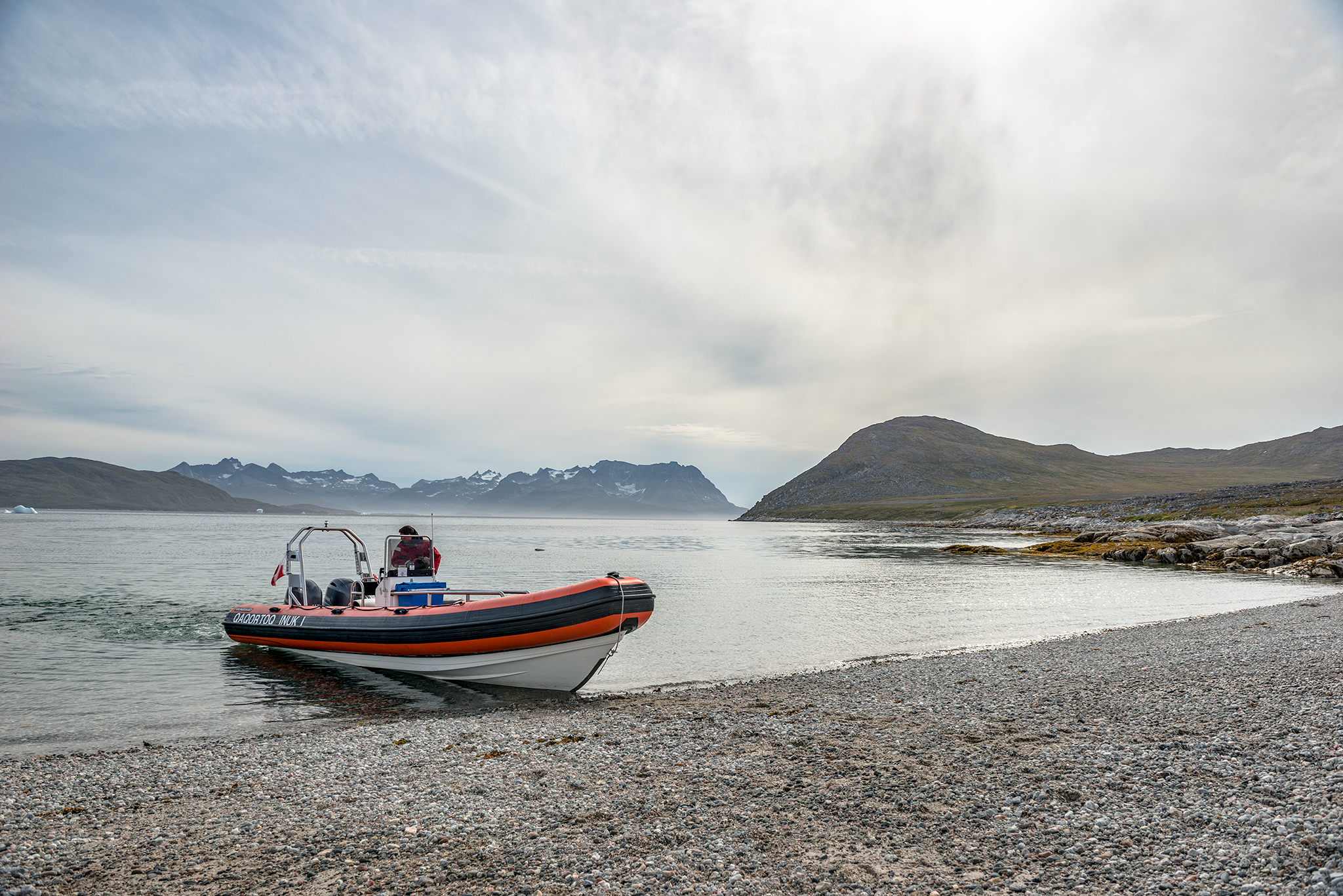
Today we will not have auroras. Pedro takes advantage of to run while the rest
return to the camp. The clouds loom closer. Marie and me smoke and breathe. A cruise floats in front of the beach. We have to walk 2 km to arrive to a very friendly cabin (and warm).
A couple with two doggies on the door greet us . We greet them. We glide us in the entrance. There, a small stay to leave the boots shares place with a kitchen. Nora is working with the pan.
In the living room two ready tables with little candles are waiting. A sofa and a stove do company to some windows decorated with objects that remember me to christmas time. Here almost everything
remembers me to christmas, in fact, including the candles. One of the dogs goes in to the living room and it lays with his master on the settee. Nora distributes the dinner from a small table
for service. Surprise! She remembers my intolerance to the lactose and has me reserved salmon for dinner. I will repeat, of course, and Nicola too. Rice and bread. Taqanaq!
There we chat of the sighting of seals. Spaniards to the right, foreigners to the left, except Konrad. The dessert includes chocolate and in the distention of the dinner we do not darse that
the owners of the house want to rest. Once finished we left with laconic qujanaq, thanking the hosts and remain for breakfast in the cabin carrying the tents disassembled.
The tide has gone up and there is not trace of the beach since we went back of the hot springs. Under the rain we go back to the camp. First tent surprise: Jonathan, the basque navigator,
perfumes his boots, his feet and the Altus tent that resists the wind and the rain. Nora comes into the tent to say good night, she feels in a magical box full of clouds and flowers.
Motor-boards noises make pleasant the night. Jonathan moves inside his sleeping bag. He dreams.
Wednesday, 6 September 2017
We get up early and follow Nicola’s movements to fold the tent. The rest of the expedition goes leaving the travel bags together with the tents on the beach. Disregarding the instructions we go up
for breakfast at the cabin. Nora reminds us orders given last night and we had breakfast between the doubt and the varied argumentations. We will go back after the breakfast to the beach to collect
the tents and come back with them again to the cabin. Finally the matter solved we go back to load the motor-board. Captain JJ to the control, our destination will be Tasiusaq
course SE, with the majestic Qasigootnoq(it will be invisible to our eyes when we arrive there). On way to Tasiusaq we do a brief stopped in the mine of graphite
of Amitsoq. José Trejo, one of the collaborators of the expedition, will explain us in Nanortalik that the island is practically inexpugnable. With the hands
marked of coal we hike the footpath Saputit no without before have lunch in the same Tasiusaq and leave to JJ sail until our final destination, where will leave us
the travel bags covered with a canvas by the forecast of rains. The neighbors see to a group of explorers in an incessant dropping to the source of the place while the boys are in the school.
The weather is not so bad to picnic in the open air and we can’t remember the warm days. Picnic in the small village. The town is small and has a terrible history of famine and death. The harsh winter of 1865 meant that food and fuel supplies did not arrive on time. Many
of those who waited there for the arrival died and others perished in the adventure of trying to reach nearby towns trying to seek help. A small monolith pays homage to the victims. After lunch & coffee the crew begin to move again and initiate the hike
from the football field used like heliport with a ravine behind whose footpath carries to the junk yard. We hiking 10 kms chatting cheerfully with Jürgen of football (no luck for total football
tonight Jürgen) and of how Nora would surprise us about the future #2 in our destination. On the way, the streams of rivers dye red by the clays of the place mingled with magnetite and iron oxides.
First horse appears in front of us. In spite of seeing it in freedom it has owner. Without being high, the greenland horses neither are small. They’re besides very strong and they have used especial
collect the livestock of the mountains. It does not like him a lot the human company and decides to pose the minimum time so that Pedro get closer and can take out photos. We leave to the right
Nuugaarsuk and its green meadows and hike on a way where the track ends with low clouds covering a farm. The surprise of the day is that in sight of the forecast we will not sleep
in camp and lodge us in a cabin of hunters, no too far of the farm. A very enthusiastic doggy comes to welcome us. The doggy's name is Nuka. Pedro starts a race with the border collie to explore the farm and from the beach
we go to the point where JJ has left us the green bags. The cabin, that has form of L, has one floor. The stairs give access to a narrow corridor where we leave the boots. There we discovered
that our Spanish colleagues from the other group have dried our parkas (my coat is hunging). Nuka seems to want to get in, but no. It wants to play catch the raindrops falling from the cabin
roof and it cries when there is no rain that feed its desire to play. It's a border collie keeping a secret. After the caresses of rigor we continued with the load of luggages constantly breaking
rabies gold rule (we did not know to what extent it). I will describe the house (owned by Tuperna's aunt). To the left our drums rest with the foods for the expedition, always with us, excepting all those that the captains
move to us, as today, to destination. Crossing a door a big canteen to different height very cold and a full kitchen of groceries. We have to warm the room before dining, is late and the
temperature keep on going down. Pera finds the chimney and starts to light the fire. Neither there are bathrooms. We have carried the shovel with us. Already we know how we will resolve the #2.
To the right of the corridor, a distributor with tens of pairs of winter home shoes of all the sizes. The distributor carries us to two small rooms and at the end a big living room lits by big
windows that offer a 180º panoramic vision of the place, now covered by the clouds, with two enormous sofas limiting a little table, another bigger one, full shelves of peculiar objects and
one more chimney. On the distributor door a photo of Thierry Henry. To light the fire, Pedro and me go out to look for twigs and find them in the same door of the house. There are rests of a big
bonfire on the outside and I found Fortuna cigarettes butts in the ashes stubs. Undoubtedly Spanish travelers have been just passing by here (Fran defended us Marie and me when Antonio found
a cigarette butt on the ground of the One Thousand Flowers Valley and signal us, leaving clear that neither an alone trace -no organic- of our step remained in Greenland).
We prepare a full cube of twigs which Pera will be able to initiate the fire. He has reserved several wooden pieces to keep it litting during the dinner. We leave to Pera working on the fire
and Nora comments us that there is not drinkable water. Nicola, Jürgen, Pedro and me get close to the farm with several empty water bins and two words to improve the language: Imeq
and Qujanaq. Hike footpath from the beach that step by step goes disappearing with the tide, meanwhile the threatening clouds over our heads makes the day darker and Nuka follows
us closely. When arriving to the house, the lady perplexed, observes to the Fantastic Four asking for Imeq and replaying Qujanaq, each one of his father and his
mother. Across the window, a middle age woman sees us loading with empty water bins and commands us to reach back part house. There, she appears again on the stairs and signals a hose of which
water flows. Immediately we answer with a qujanaqs increasing tones and we start to fill up the water bins until five wild beasts appear out by the door and stay on the stairs looking us. And with
those kisses machines another border collie, Rudo, the partner of our new friend that can not do at all so that his five puppies launch themselves to our necks. We take the rabies gold rule and pass it
through the arch of the triumph, and while the water bins are filling, we leave us entertain by our hosts. Meanwhile, puppies' father gives up. Grandfather appears and observes the scene from
the stairs. Puppies just want to stay asleep in our arms, looking for our heat. The howls of pleasure are increasing. What have I come to do here? Several qujanaqs get us out of
dream. It's time to carry the water back to the cabin. Our last qujanaq to the lady provokes a laugh. We set us up and the doggy goes back crazier still treating to detain the
advance of its puppies. No very far of there the farmer works with his tractor on the lands. It does not remain neither trace of the beach. Resolved the subject of the water, the expedition
rests, reads or sleeps in the cabin. Alejandro Sanz sounds in the living-room. The fire is lit. With a tea and hot coffee I talk about the subject of the birthdays in case some traveler has
decided to celebrate it with us along the trip and results that we have two. Chris and Marie. An incomparable frame for a celebration of this level. I found a comic of Ben-hur…in greenlandic.
Doggy has gone back until the house to play with the drops of rain while it barks to his couple so that it goes back with the puppies to the farm. Hard hand. It bends the ears and goes back
to the house. Besides, Nuka wants to run, full energy and it can't be quiet. Before dining and as a result of the stupidity that occurs me to finish the French sentences of our mates with
“by Jean Paul Gaultier”, Pera takes us out his survival kit. It composes of the minimum material to bring the civilization to the most remote places. It includes several essences and perfumes.
He uses One Million, of Paco Rabanne, on my wrist and that simple gesture will be one of the reasons the doggy will turned back even more unbalanced. The dinner runs distended. All of us are
enough warm and chatting. Tomorrow it will be my turn in the breakfast to clean dishes with Jonathan. After the dinner and with enclosed night I'll take the shovel and the headlamp. Nuka still
wants to play and after several careers we both look for an appropriate place for burying my ego. The clouds cover all the landscape and in spite of the darkness something begins to reveal in
north direction. The mist dissipates and the majestic silhouette of the Qasigeetneq cutted with the light of the Moon(Harvest Moon or Corn Moon) begins to break the clouds.
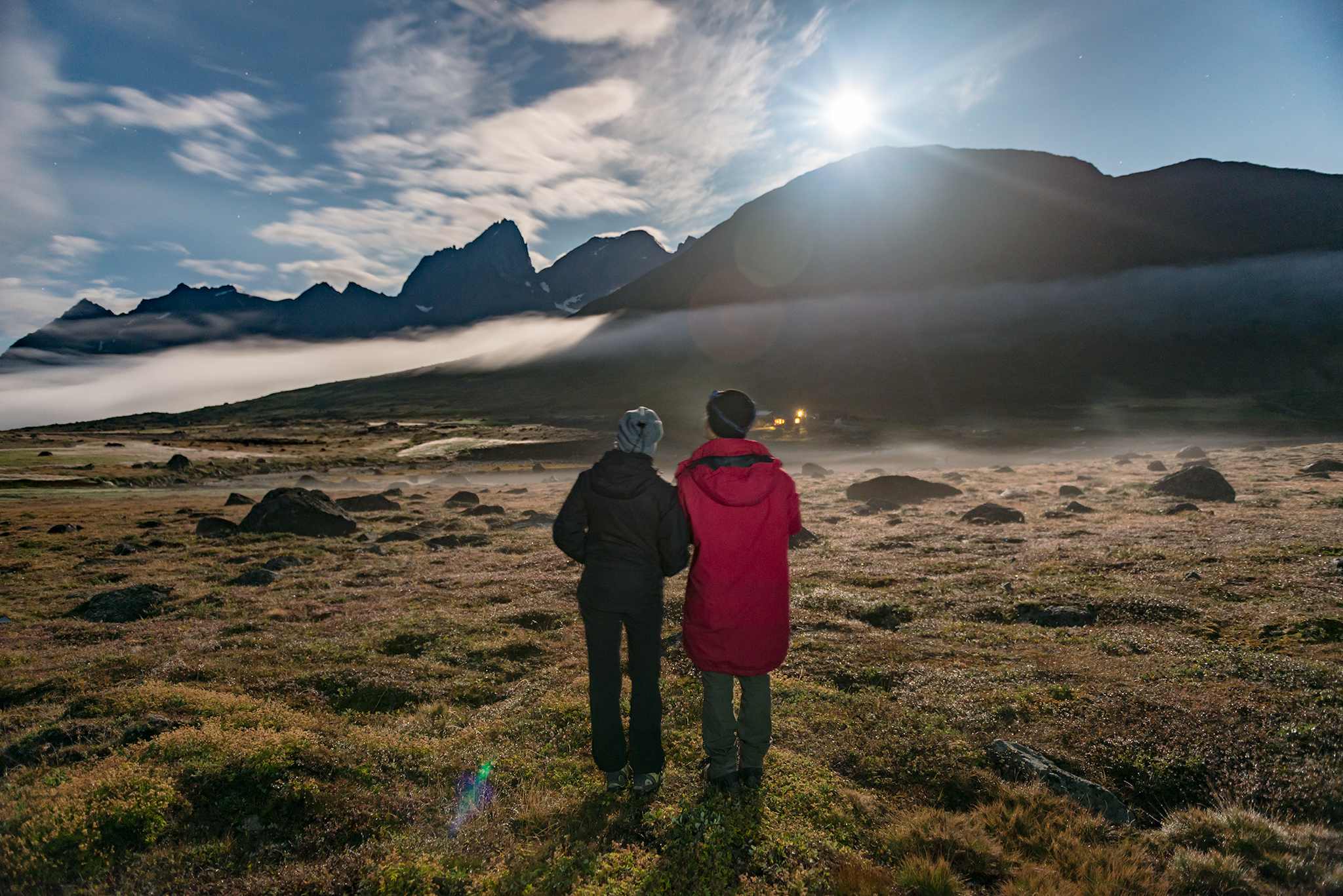
Tukik is the masculine god of the Moon and the legend explains He is able to leave pregnant to all woman that will be alone working until
afternoon in a night of full moon, by what in days of full moon, the women avoid to be until afternoon unless they want to remain pregnant… I catched the camera and the tripod. There is an odd
agitation in spite of not being a night of auroras. Stephane and Chris aim to the party. Lolo and Marie also and I could portray them. Fulfilled my respects to the mountain I give my headlamp
with red light to Lolo and between guffaws ask if she can run of left to right moving the light with the insane hand. The place has something special and we have arrived in the suitable moment.
It is the atmosphere of fog and moonlight cutting the silhouettes of the mountains. I see to Jonathan over one of the windows in the living room asking himself what fuck are we doing. After the
laughs arrives the moment of the farewell by today. I go into the house again, saying good night to Nuka and reach the living room. The partners have reserved me a sofa where I will have
a magical vision that, added to the polyphony of my mates, will do me fall in a deep dream.
Thursday, 7 September 2017
Sun rise again and we breakfast with strengths improved. Finally and although with cold, the house has respected us the dream. Today Captain JJ will pick up us to go to the Tasermiut
Glacier, course N, and to the camp of same name. When waking up Nuka is keeping an eye to the door. Knowing that behind the door we can find us with the wild beasts, we excited get ready
the bags, dishes and house before going out. And they're there. The father arrives with four of the collies willing to devour us with kisses. Meanwhile we're playing I ask to Chris that If he can
take my camera and take me out one of the most beautiful photos of the trip. I take advantage of to portray to Lolo with her new friends that leave to shiver in the same moment that she takes them
in her arms. The time passes and would not know to say if they were one or two hours of relax (no matter the time in these latitudes). Portrait to Nora: she is another crazy of the dogs.
To the while a whistle gives us back to the reality. The dogs have to return to the farm and we have to begin to load the bundles until the jetty. Marie and me accompany to the family dogs one
hundred of metres and Jonathan gifts me another fantastic photography. He already knows to handle his nikon in manual mode! Doggy watchs us in the change2change with a pair of puppies.
Paplo will be the only puppy to remain the owners of the litter. We initiate
the travel and observe to Nuka on the rocks. We will not go back to see it. During the trip many of the conversations will be about the puppies.
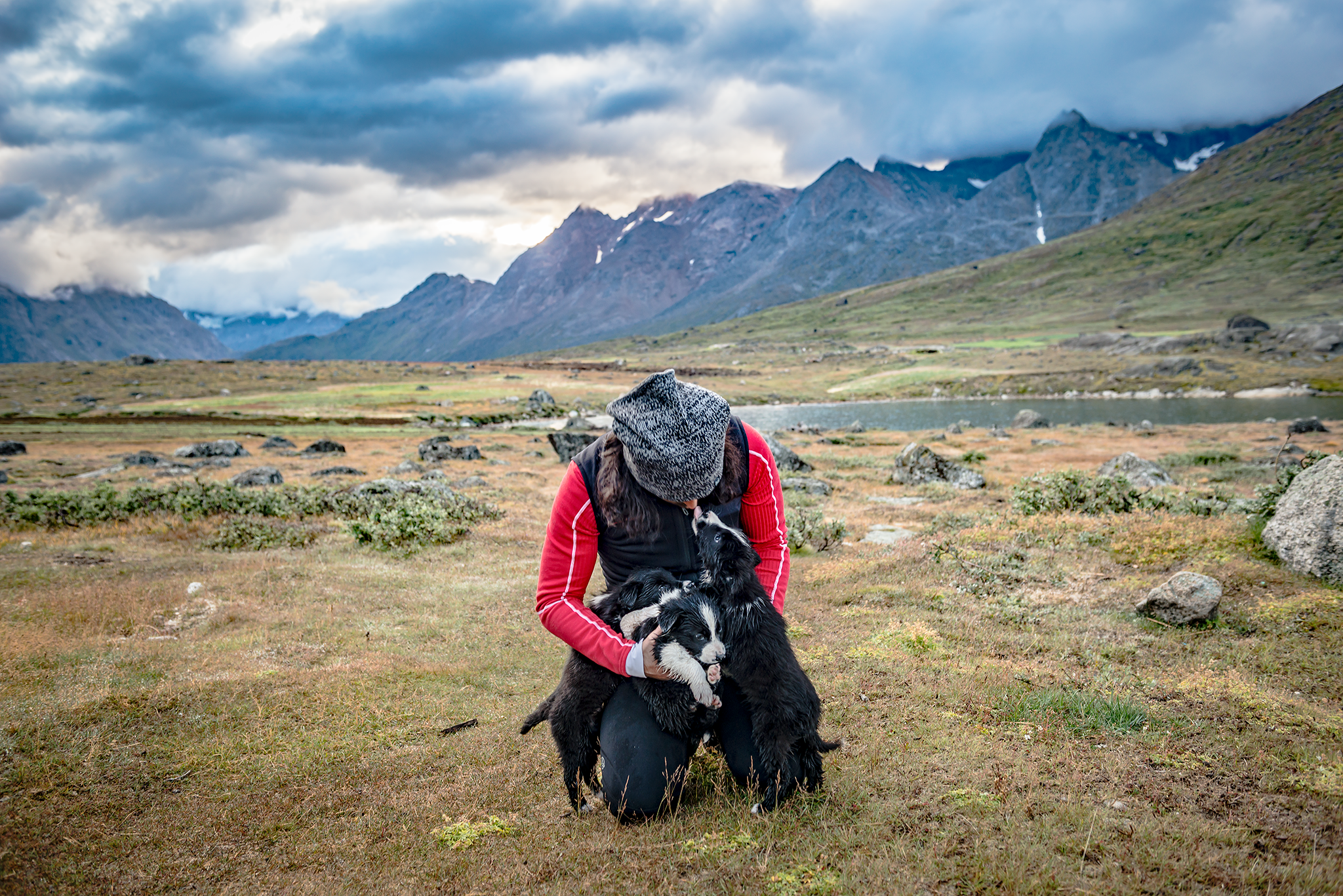
The travel by the fiord of Tasermiut
has a great pictures all around with enormous mountains that seem to arise of the bottom of the challenging fjord. At the end it begins to draw itself the glacier profile. We are all mad for
landing and take out photos. Fran decides to remain on the motor board and Nora give us new instructions. The orders of JJ are clear: no more than three photos. Three photos by minute, three
photos by second…The group is looking for the best angle, the unique vision of the glacier, always moving away of the dangerous points where we can’t control the fall of big rocks.
I take advantage of to portray them one by one. The wall of ice falls to lead 1240 metres until the bottom of the fjord. We take with our hands blocks of ice with thousands of years of antiquity
in some clearly damaged surroundings by the shrinking of the glacier. In the point of disembark the stone is nude and strong waterfalls are the proof of the death of the glacier. The surroundings
does not leave to be magic and ask myself how would be to see it in its splendor time. JJ asks us that we return to the boat. While the expedition take position I'm finishing to portray the team.
The camp of Tasermiut is waiting for us.
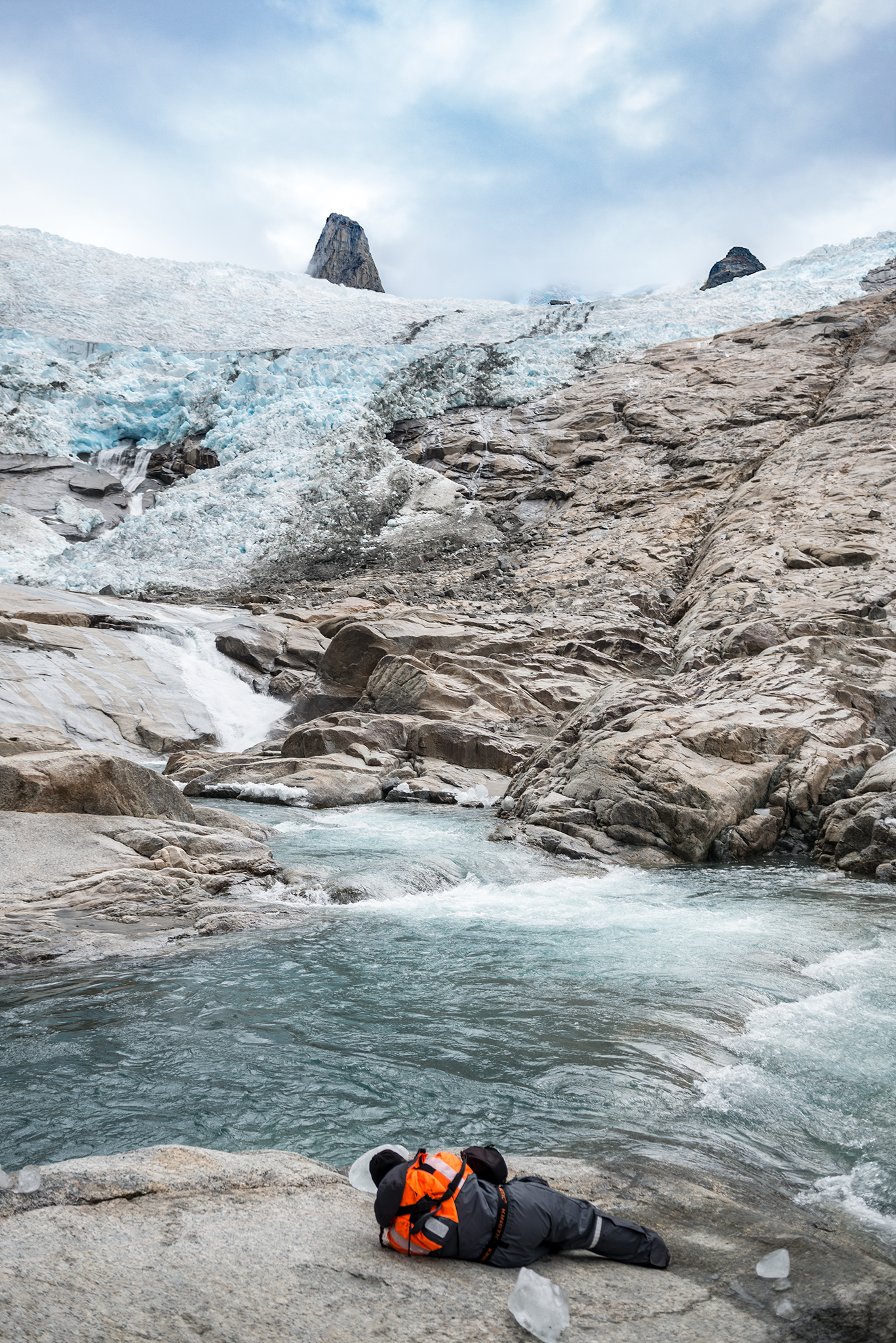
The travel change the direction now to south to arrive to a bounded location by big walls. We landed on a beach. A group of Spaniards wait
for us. They are witnesses of our courageous (and hilarious) change2change. I meet the Spanish traveler who "saved me” of the attack of the giant mosquito in Keflavik and that besides they occupied
to hanging the parkas for drying in the cabin of hunters of the previous day. Time to load the luggages, bundles, food and rest of utensils to the camp. From the beach there is a gap of some 50 m
and under the sun we notice the heat of the effort. Fortunately another group that today abandons the camp has left mounted the tents and we feel relief after loading in the sunlight. The domo tent
of the kitchen is even more high that the own camp. We will share settlement with the group where also the olders Spaniards are. We have new instructions for the #2: black rubbish + white rubbish =
community drum only for organic waste. The cellulosic wastes will go in the white bag. And yes, we will have to disassemble all when we leave, and yes, Pedro will load with the community organic
magic blue bin to the boat. We have a beautiful kitchen-canteen with enough room. Two rows of banks join two tables and are able to give service to the 13, with kitchen, furniture and varied
shelvings. Besides, we have an enormous plastic bunker to our service. The landscape is impressive. To the right the Ulamertorsuaq dominates the sight. In the centre, at the end
of a valley, outlines the Nalumasortoq. Distribution of tents and food in the kitchen. Clear skies shows us a spectacular night in the camp. I comment it to Stephan and Chris.
We set us up. We will advance by the valley, crossing the river through a tibetan bridge. On the road we'll see inuit grave and a cabine that serves of shelter. Nora explains us the outlaws' story
of Greenlanders. They can return, and sometimes they can bumpsr with the inhabitants after so many years living out of the rules. Front of us the Nalumasortoq. Looks like an open
book. We will visit it tomorrow morning. Photos of courtesy, rest to observe the surroundings and return to the camp. Behind the kitchen, you can find a small river and on the river a bridge done
of three wooden boards, from where we will fill the water bins and we will do the pertinent cleaning of dishes, covered, pots and frying pans (I can seem odd but advise that all those that have
the delicate and sensitive skin execute these nocturnal works with gloves). And after the dinner, as always punctual, the storm. The most spectacular lights of the trip. Electrons of the oxygen
and nitrogen dancing of wild form crossing all the sky, excited for the solar wind and falling again to the fundamental state. Without words. My camera and frontlight are in the tent right now.
I enjoyed the gift. Stephane, Chris and Jonathan together with Nora and another guide have the cameras next to them. After the celestial agitation, that include red, green and yellow, the sky
begins to relax . Sometimes I ignore my intuition and finally realize too late. But there we were, all impressed with that scene never dreamed before. With the excitation of the moment I'm feeling
intense cold. Nora and the another guide say toghether, as in a distant litany, Immaqa, perhaps, as an answer to a question I formulated about the lights can go back to repeat.
We are in some really uninhabited surroundings far of the civilization, where the foxes can do us a visit with simply leave food. The rabies rule in case
of foxes is stricter.
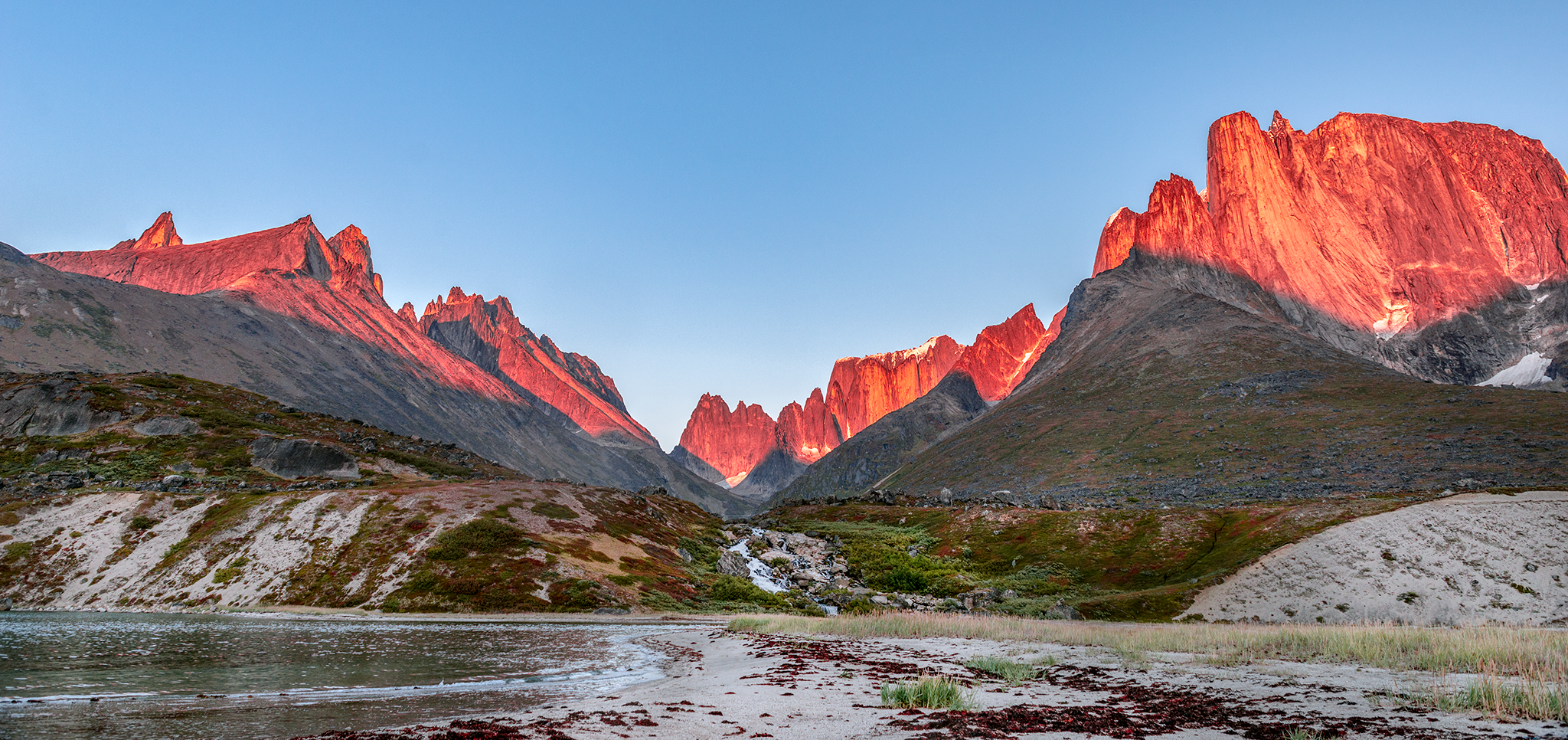
Friday, 8 September 2017 Happy Birthday Chris!
Dawns on Tasermiut. On the walls of the fjord you can see Napasorsuaq, The Cathedral (2030 m). Inexorably, every #2 is celebrated with a triumphal ride.
After breakfast we pick up the picnic utensils. Today we move to the feet of Nalumasortoq (2045 m), better known as The Book. The hike from the camp makes between moraines and
rivers. The sun hits hard again and from this point we look the clouds beginng to cover slowly the north face of the Ula, which we leave to the right. Nora tells us the story of a young mexican
boy who was waiting his father climbing the Ula meanwhile he was climbing too the same time back north in front of Ula. We find the open view point of the Nalu. The immense mole is formed with
three enormous pillars so that the result resembles an open book. On the march we stop to rest, snack and drink, while taking photos. The waterfalls break the wall that leaves to our left and
we stop on the foot of the Book to eat. Picnic under the clouds that begin to cover everything. We finished the picnic and Chris flights the drone. Today is his birthday. We restart the route
up to an empty glacier basin, about 150 m of unevenness. We are in the bowels of a glacier of thousands of years: an entirely dry glacier in the south of Greenland. Before returning, from a high
point, I tested a panoramic of the place. The expedition descends singing exploiting all the musical 70’s & 80’s cartoons production. For a while
it is bearable, but we begin to loss audiences and to move away animals. We break the magic of the moment and continue descending. At the end of the fjord the sun tries to break the clouds and causes a sunset painted of brighter colors.
The group arrives more tired but still draws strength to continue enjoying the surroundings by means of the fishing arts. Nicola has cooked a bait at breakfast and Pera will try his luck.
While Pedro runs down the beach, both throw the rod we said them dinner depends exclusively on them. Nicola has a capture of a little fish and returns it to the fjord. Pera has the happy
idea that I must to try it. It is the first time that I take a rod. I have no idea indeed, listening to instructions in Spanish and Italian at the same time. I hold it tight because I have
the feeling that it is going to escape me to the water and I have to rescue it from the icy waters of the fjord. Twice I throw it and although there is no luck the feeling is good. It starts
to get cold on the beach. When the air starts to stir the atmosphere we are already picking up the parkas to go to the kitchen dome for dinner. Rain has come. Dinner runs with raindrops falling
from the ceiling that do not augur a night of northern lights. The weather, relatively stable until this moment was ready to show us its teeth. Confidences under the wall of rocks and farewell
until breakfast. Rain and wind become more and more intense. In the tent, perfumed once more for a night of hurricane winds, I use the parka as a pillow. This idea will keep dry the sleeping bag...
and my head. Our tent is oriented EW and my side is windward, with heads pointing to the west. We try to sleep ignoring the hurricane that visits Tasermiut. Katabatic winds,
created by the so-called Foehn effect. In the middle of the night hurricane wake me up. The rain falls horizontally and flushes its weight inside the tent. The zamarra is wet and part of the
floor of my side is soaked at the height of the head. Screaming "Jonathan, wake up, we’re sinking man!" I try to wake up the navigator who, with his natural comedy, answers me: "Yes, over
your head". The Basque giant does not fit in the tent and sleeps diagonally. He turns and keep on sleeping. Great troubles, great remedies. The next day I will explain them at breakfast
we were laughing, the reason why I awoke with my feet on Jonathan’s face.
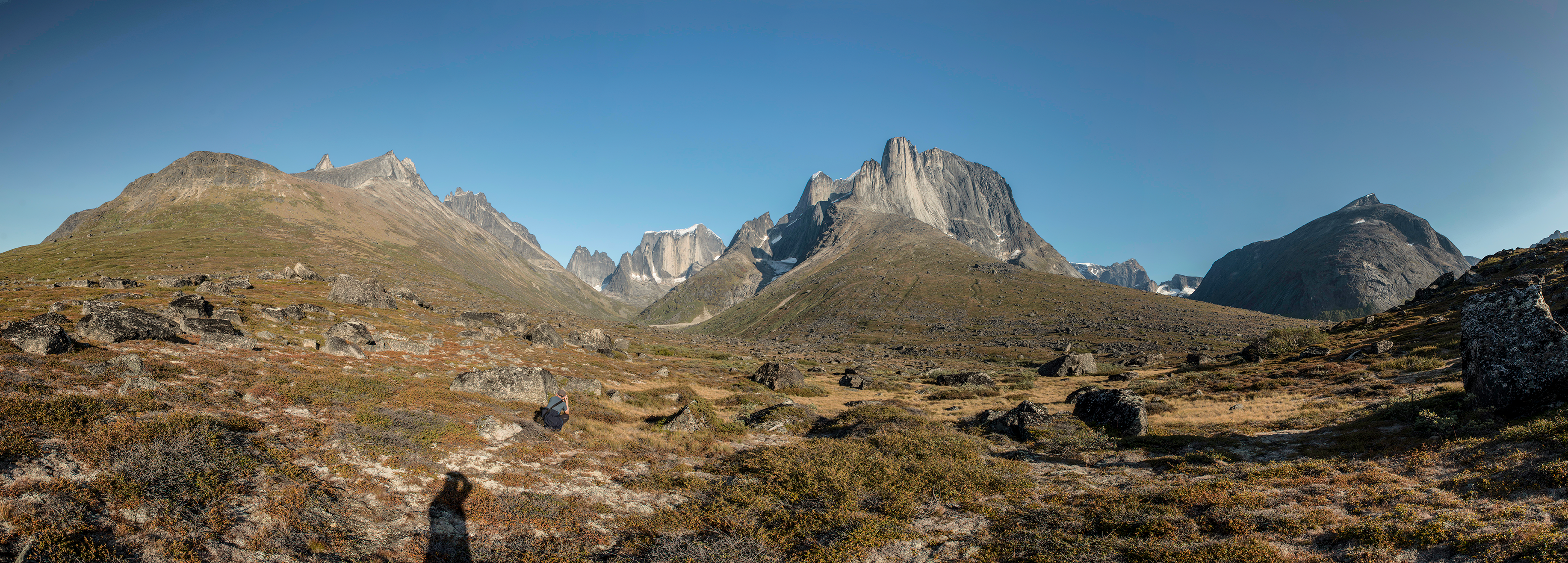
Saturday, 9 September 2017
We check the tent at dawn and it results in only one corner being soaked: my corner. Fortunately, the rest of the tent is intact, travel bags and boots. We re-tighten the ropes and leave it ready
for hectic second night if necessary. The last night at Tasermiut, renamed in my mind as One Ton Camp. Today the expedition moves to Ulamertorsuaq
(Literally large cylinder). To our amazement the mature group of Spaniards maintains law and order with the plumb line. From the inside of the tent, while I'm fixing the sleeping bag, I hear a
Spanish woman berate someone. She's Marie. The Spanish woman does not understand why Marie has put paper in the white bag of cellulosic waste, following Nora's instructions. When I approach and
ask her what the problem is, she answer me the white bag is for saving the black and white spare stock bags ,made of plastic ... in case they get wet…. Finally they have already left the camp
and will be our last night by our own. We had breakfast between laughter. Over the peaks skies are clean and we can see it snowed tonight. Yesterday the temperature went down, but the cold sensation
was even worse. We leave the wet parkas in "The cave" to dry. Hike to Ula. Thirteen adventurers walking to a magical mountain. The Lord of the Rings, the Silmarillion, films in general and Fuju
will be the topics for this hike. During a good part of the way we have been dedicated to laughing with the worst actor ever (you decide who is, it was very clear for us) and "great shit movies
that they rule" To the right a glacier valley divides the Ula and the Sulkkuasuuaq. The views are stunning. The heat goes back and the sun bright decreasing humidity. He had read
that the storms don not last long in Greenland and time is showing it. When we look up to the Ula, it refuses to show us its face. After the picnic on the safe area of the Ula, while the expedition
rests, I chase rabbit hounds looking for arctic foxes. On the rocks, little bells and Niviarsiaq, the national flower of Greenland. You can translate it as "young girl". Clouds revolve around the
chimney all around, recharging and attracting new clouds. Once rested, the crew climb up a path of dry paths that lead us to the same Ula’s slope. The river runs hard to our right during September
and our side is a dry path. The pot is completely empty. More photos and we start the descent. Although there are clouds today, I will carry the camera with me everytime. We descend without haste
and we turn from time to time to observe the peak. Ula will not reveal its secrets today.

At dinner, Carlos Mejía Godoy and those of Palacagüina. Second
clue. I appreciate Pedro nail clipper but it seems that it will not be necessary: there is no nail at all. Outside, in the immensity of the background and under the mantle of Greenland stars
,I ask to Nora that explains me a Greenlandic legend. She smiles and tells me the story of Sedna.
The old ladies tell that once upon a time there was a young woman
beautiful, long-black haired girl named Sedna, who lived with her father. Anyone sought to marry her reached the age of it, but one day she saw from his cabin a glorious sailboat captained by
a foreign hunter. The captain immediately fell in love with her and has been seduced with words full of promises and treasures so she left with him. Sedna fell into despair to discover that the
true identity of the hunter was that of a shaman, able to change shape. The father, hearing the desperate cry of his daughter, ventured in his kayak by the ocean until he found her. He found her
alone and escaped, but when the shaman returned in the form of a bird and noticed the game of his beloved. The bird, blinded by the rage, unleashed with its powers to raging tempest to see that
the father denied giving to his dear girl. With tears in his eyes, the fisherman understood that the sea was to strike his daughter and throw Sedna overboard to the cold waters to consummate the
sacrifice. In the midst of despair, Sedna surfaced and grabbed her father's kayak with frozen fingers. When he was in danger, the father cut off his daughter's fingers, which became small fish
and seals, and thumbs and hands became walruses, whales and all marine animals. After the fierce scene, the ocean calmed the fury unleashed by the shaman, and Sedna sank forever in the bottom
of the sea. The Inuit believe that when the sins of men, which always go to sea, have polluted the ocean, the long dark hair of Sedna is entangled. Since she no longer has hands to comb her hair,
she cries and becomes angry, so the marine animals move away from the coasts and come to comfort her. When the Inuit begin to starve, they know that it is time to confess the attack on nature and
they go out in large numbers to the ocean on board their boats, to comb the sea, to clean and to unravel the hair of the fisherman's daughter.
I thank Nora for the magical moment in
Tasermiut. I mount the camera on the tripod. We have auroras, but there are too many clouds and the Moon is coming out strong behind the Ula. The result is no less poignant.
A silence runs through the camp only broken by the shutters of the cameras, the real outsiders of the expedition. I take an evening photo of the fjord has covered me these last three nights.
We’ll have a hard day tomorrow. We have to dismantle the entire camp, kitchen and belongings included, and load everything back into the boat. Today there will be no rain and the night will be
placid and cold under the the moon light. Last photo in Tasermiut, where Sila dominates everything.
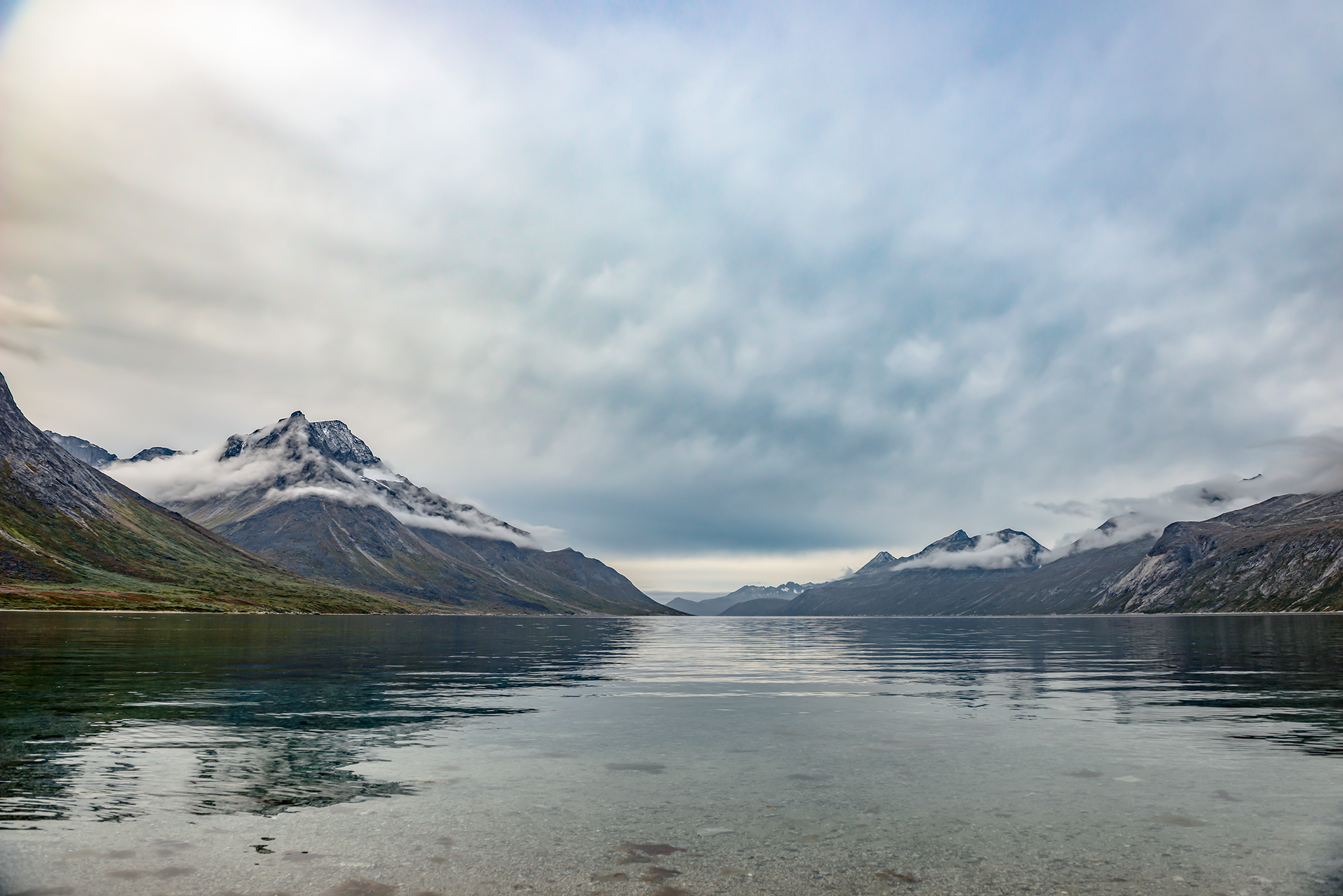
Domingo, 10 de Septiembre de 2017
Despertar más triste de lo acostumbrado. Hoy abandonaremos Tasermiut rumbo de nuevo a la civilización. Quizá la comodidad de una cama se echa de menos, pero el entorno del fiordo
es único y sus noches las más espectaculares de la isla. Tenemos por delante dos horas antes de que lleguen Trejo y JJ para desmontar todo el campamento y bajar los pertrechos a la playa.
El desnivel vuelve de nuevo, pero esta vez es bajada y se hace más llevadero. Bombonas de gas, cocina, mobiliario, estanterías, bancos, mesas. Sólo dejamos el esqueleto de la tienda y el suelo
de losetas de madera. Trejo llega acompañado y llenamos su barco con todos los enseres de la cocina, las tiendas y las colchonetas. JJ se retrasará un poco y disfrutamos de un último vistazo a la
que ha sido nuestra casa las tres últimas noches. Destino Nanortalik (literalmente el lugar donde hay osos polares). Allí nos espera Jørgen, hijo del Capitán Niels, el hombre para
todo en Groenlandia. En su casa dejamos el campamento desmontado y…nuestro agradecimiento por tanto amor que cargamos con nosotros. Nuestra nueva vivienda será un edificio de dos plantas, caldeado
(muuuuy caldeado) y también acogedor. Una larga escalera llega hasta una terraza y la puerta principal, con un pequeño hall para descalzarnos. En la planta baja tenemos un baño con ducha que
funciona perfectamente, un salón con dos confortables sofás, chimenea de hierro y un gran ventanal con vistas al pueblo. Hay además tres habitaciones con camas pequeñas. La mía da a la bahía.
La segunda planta tiene una cocina muy funcional y tres habitaciones más. En la segunda planta hace mucho calor y tenemos la ventana de la cocina abierta. La vista de la bahía desde el comedor es
espectacular.
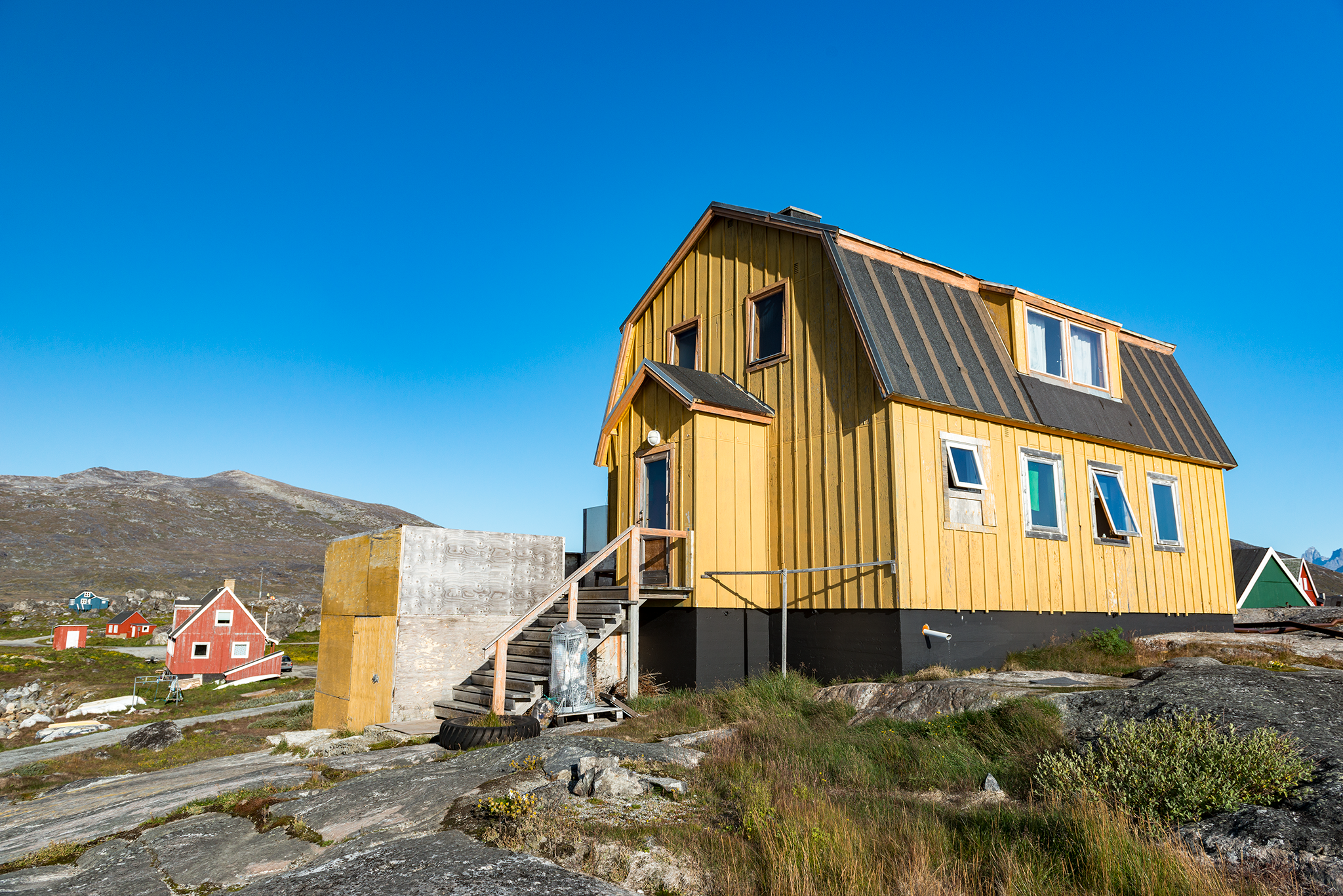
Cuando bajo a la habitación Jonathan ya ha enchufado toda su potencia electrónica. Hoy es la noche libre de Nora por lo que nos toca cocinar. Todos miramos a Nicola y obviamente nos
preparará su pasta. Llegamos poco antes de que cierre el supermercado y allí cada uno hace acopio de material para cubrir sus propias necesidades. Aprovecho para comprar dos filetes de ternera,
tabaco marca Prince, soft según la dependienta, cacahuetes y un croissant. Uno de los filetes se lo prepararé a Fran, puesto que Nico nos llenará hasta arriba. En la cocina el calor es sofocante
. Mientras el grupo se ducha tras la comida, Pedro y yo salimos a la búsqueda de huskies. Una de las calles con casas familiares tiene una buena concentración de
huskies y jugamos con ellos. Comienza a cambiar el tiempo. Sobre una torre con electricidad los niños se columpian dando vueltas con una cuerda y un trozo de plástico atado. Durante la marcha por el
pueblo encontramos una bolsa transparente llena de trozos descuartizados de un animal. Damos una vuelta a la casa y la dueña nos remite al marido, el caribú hunter. Peculiarmente ataviado con un
sombrero, un mandil, gafas y coleta nos cuenta que él mismo cazó al caribú y que ahora está secando la carne al aire a base de cortar trozos finos. Tiene un color estupendo. Al descubrir que somos
españoles repite con alegría “¡Olé, señorita!”. Comienza a llover. Nos despedimos y retornamos a la casa. La tarde pasa entre coladas, parchís asalvajao y duchas. Para aprovechar el calor de la casa
desmonto una de las bolsas y uso las cuerdas como tendedero. Nos informan que el bar del pueblo cierra pronto y Trejo nos ha puesto sobre aviso: llegan vientos fuertes. Nora nos confirma que
estaremos dos noches en Nanortalik ¿Vientos fuertes? ¿Bares en un pueblo? ¿Qué puede salir mal? Habiendo bares y después de la experiencia en Narsaq quedarse en
tierra ya no parece tan mala idea. Cena opípara y los Nightclubs Explorers nos vamos al bar del hotel. Captain Morgan y Despacito en latitudes árticas. Sigue lloviendo. Un canadiense se descojona
con nosotros. La camarera y el camarero se quedan flipando. Una paisana se acerca y pregunta que si somos españoles. Tiene un trato exquisito y está emocionada porque en un viaje a Mallorca aprendió
una palabra en español: “Bursa”. Nos miramos extrañados. Le preguntamos en qué contexto y responde divertida que cada vez que iba a pagar en el supermercado la chica que atendía le preguntaba si
quería “bursa”. Es un puntazo de mujer. Se llama Tuperna y es la hermana del dueño de la granja de Nuugaarsuk. Tras los bailes con los paisanos y despedidas con juramentos de amor eterno nos volvemos a la casa. Lluvia y viento. Uso uno de los cojines del sofá como
almohada. Dos lamas del somier no están ancladas. Por circunstancias inverosímiles el navegante vasco con el que comparto habitación amanece en el sofá. Sospecho que la cama, como la tienda,
también le queda pequeña y mis ronquidos le quedan grandes. Nuestros dos vecinos franceses se han quedado en la casa con antibióticos. Creo que Chris tiene otitis. Calor intenso dentro.
Lunes, 11 de Septiembre de 2017, ¡Feliz Cumpleaños Marie!
Lamentando quedarnos en tierra parte de la expedición nos dirigiremos al asentamiento original. El sol brilla pero es verdad que un fuerte viento hace difícil la navegación. Mar adentro la espuma
de mar se levanta varios metros. Después del desayuno echamos a andar. Los cuervos disfrutan del foahn que recorre violentamente el pueblo. Las embarcaciones están en puerto. Una barrera metálica
impide la entrada de icebergs que podrían acabar con los pequeños botes.
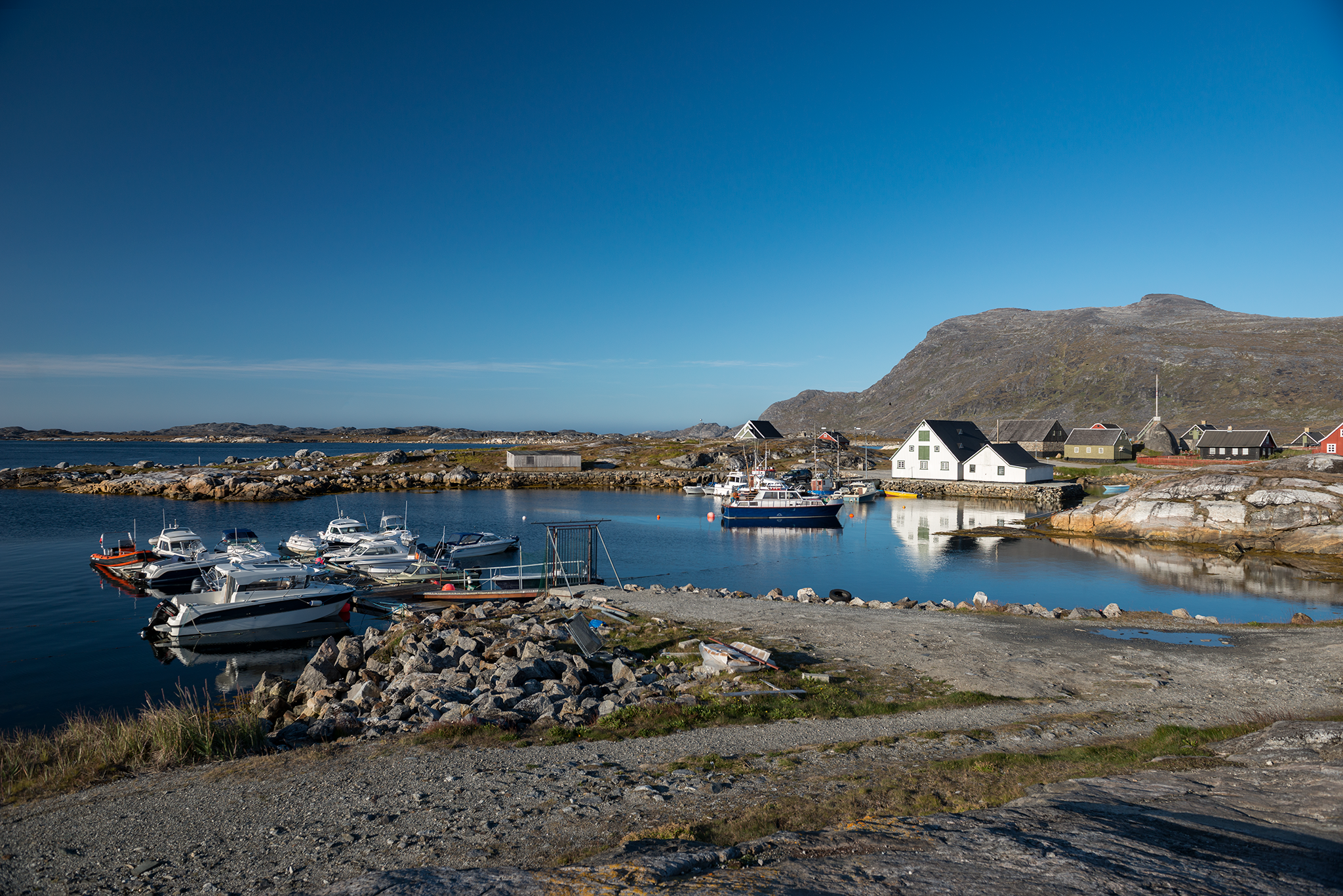
Recorreremos el pueblo rodeando la bahía y deteniéndonos en cada casa en la que vemos huskies para sacar fotos. El camino
no es largo pero las ráfagas de viento hacen que te sientas vivo por momentos en medio de la civilización. Nennortalik era el nombre original del asentamiento. A mitad de camino
encontramos una tumba inuit.
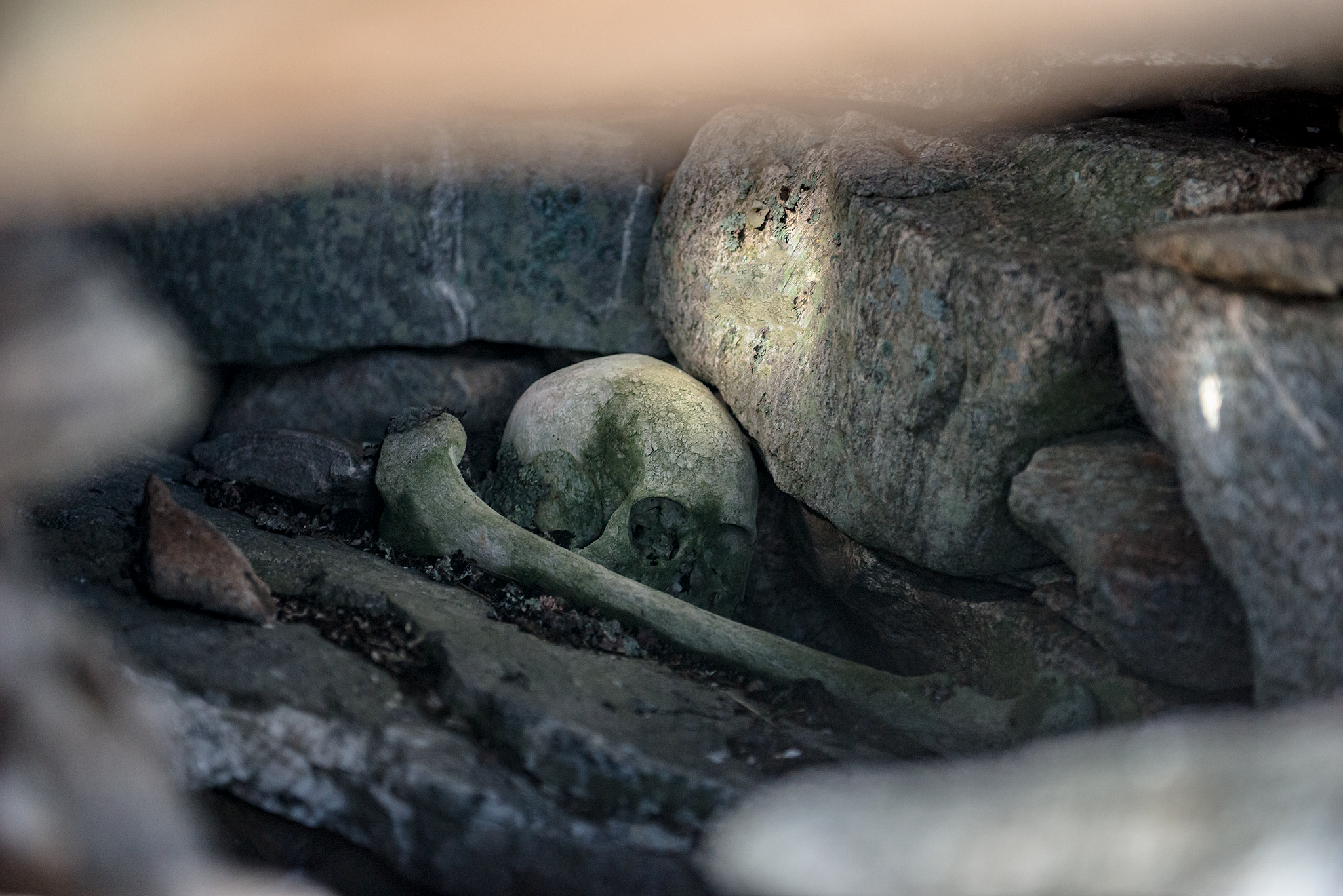
Finalmente llegamos al punto donde se encontraba el pueblo. Una cruz blanca mirando al mar nos espera. Fotos de cortesía y regreso a la casa para comer rápidamente.
Trejo nos hará de guía en el Museo. Allí nos descubre las bondades y costumbres del pueblo Inuit. El nombre de esquimales se lo dieron los indios norteamericanos al observar que comían carne cruda.
Trejo disfruta con cada explicación, y deja silencios para que podamos pensar respuestas a preguntas que alguna vez pudimos hacernos. ¿Cómo construían con madera si apenas hay árboles en Groenlandia?
Madera de deriva ¿Cómo sobrevivían en ambientes tan hostiles? Estómagos y pieles de foca para crear el primer goretex. ¿Cómo podían navegar sin deslumbrarse? Ahí tienes las primeras gafas de sol.
Los Inuit tienen una forma muy curiosa de definir el arte, para ellos Eqqumiitsuliorneq no es ni más ni menos que “cosas extrañas hechas por otros”. Nos relata además que la mayoría
de las piezas del museo son obra de un vecino. Entre las historias destaca uno de los símbolos de la naviera danesa, el Hans Hedtodt, el pequeño Titanic. Sus constructores recordaban el pasado del
Titanic y se jactaban de que eso nunca podría sucederle al Hans Hedtoft: eran otros tiempos… más modernos y los ingenieros presumían del blindaje a proa y a popa, de su doble fondo y sobre todo
de sus 7 compartimentos estancos. Construido para mayor gloria de los daneses se perdió el 30 de enero de 1959 de regreso del viaje inaugural de Groenladia a Copenhague, al sur de Cape Farewell.
Únicamente aparecerían los flotadores. Disfruta contándonos las tradiciones y los trajes regionales de la zona. Merece la pena ver las reproducciones de barcos balleneros y kayaks con pieles de
foca cosidos a mano. Lograban grandes resultados con la materia prima que disponían. Máscaras tradicionales, tallas delicadas y demás ornamentos están presididas por la piel de un oso polar
(el cazador nanoq) de tamaño mediano.
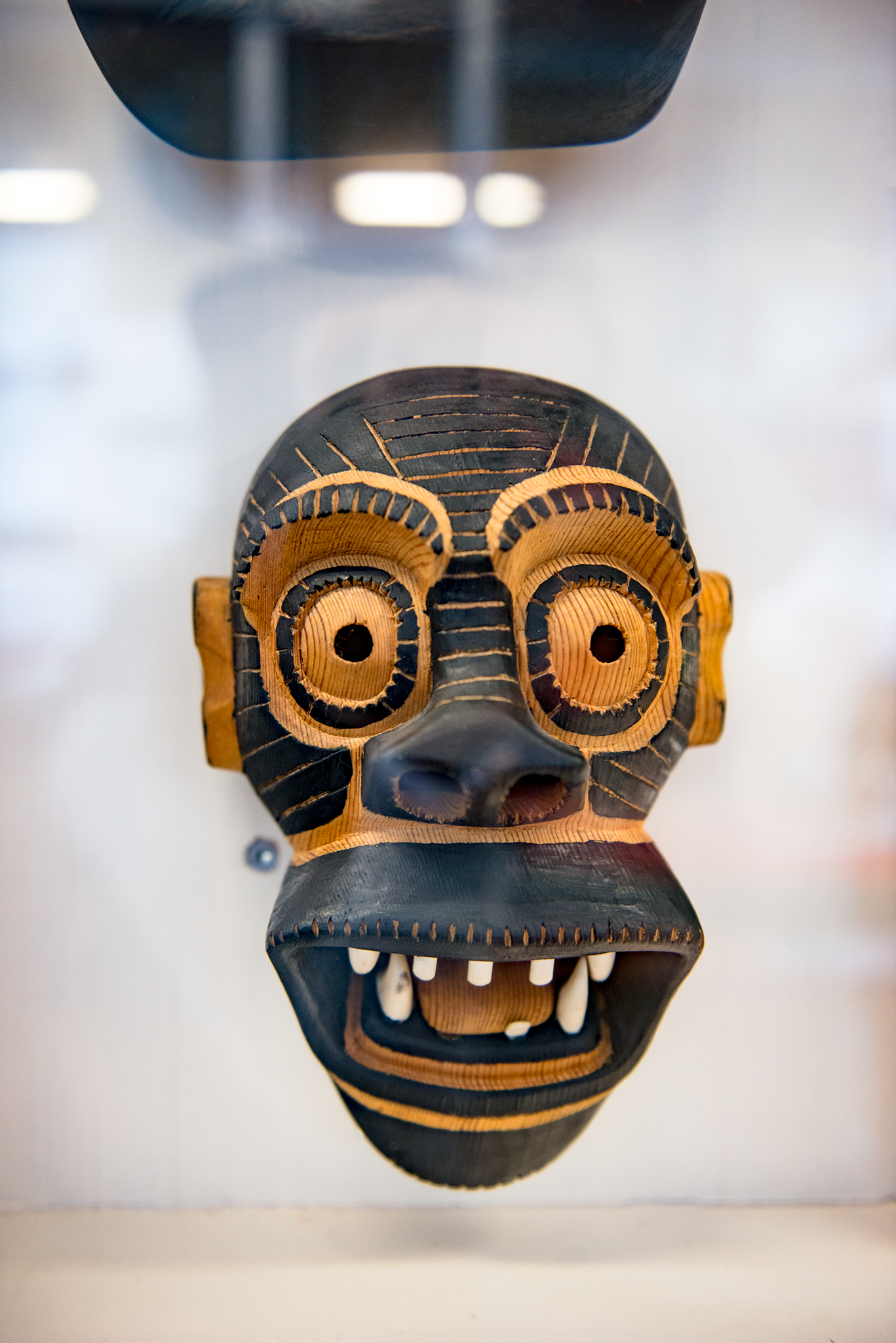
Como curiosidad, la lancha que lleva JJ se llama Avannaq, literalmente “viento frío del norte” y puede alcanzar velocidades
entre 45 km/h (con carga) y 74 km/h (en vacío). La visita continúa por un edificio que alberga kayaks antiguos y barcos familiares. Los kayaks originales tienen una bolsa para guardar piezas y
otras ideas para hacer más fácil la travesía por las aguas helados. El edificio está decorado con fotos antiguas. Cada pieza de piel del casco está cosida a mano formando una unión estanca.
La técnica de esquimotaje es tan importante que se organizan competiciones para ver cuántos giros son capaces de hacer. En la segunda planta veremos al único zorro ártico que veré en el viaje,
disecado. Dejamos el pajar y nos adentramos en el taller ballenero. Dentro, inmensas prensas para trabajar el aceite de ballena, sierras enormes para cortar el hielo en el mar y el tarso de una
ballena. Entre las conversaciones se cuelan historias de escorbuto y déficit de vitamina C, de cómo los exploradores de principios de siglo XIX lograban o no sobrevivir dependiendo de su
acondicionamiento a la comida cruda o ahumada (las propiedades de la comida se pierden al calentarlas al altas temperaturas y eso aquí es un gran error). Peary, Amundssen, Scott, Shackleton,
Nansen…nombres que inspiran. Pese a hacer sol, el foahn arrebata el calor de las estancias. Comento con Trejo las canciones tradicionales para los días de solsticio inuit pero creo que
son samis. Algo cantarán estas gentes los días señalados, porque pese al tiempo son extremadamente alegres. El siguiente edificio es estrecho y nos habla de la geología y gemología del lugar.
Comentamos la mina de oro al aire libre de Nanulaq (frente a Kusisuaq, donde los cachorros) y en la que el Capitán Jørgen estuvo trabajando y recordamos la parada
a la mina de grafito de Amitsoq. Nora nos había comentado que una de las piedras más apreciadas de Groenlandia es la Tugtupita. Un aluminosilicato anhidro de sodio
y berilio con aniones de cloro e impurezas de hierro, galio, magnesio entre otros. Es piezoeléctrico, por lo que es capaz de generar corriente eléctrica mediante la presión y la tensión, además
de tener tenebrescencia: se oscurece al exponerse a la luz y se aclara en lugares oscuros. Se descubre en Tugtup Agtakortfia, al norte de Narsaq. Tugtupita viene
de la lengua inuit y literalmente es Sangre de Reno (Tugtup es reno). Vuelta a la casa, hoy cenaremos pronto para que no nos cierren los bares! Al final de la
cena Nora hace gala de buena guía y sorprende a Marie con una tarta de bizcocho. En la cara de la cumpleañera asoma una emoción que difícilmente contiene únicamente rota por las velas trucadas
que no paran de reencenderse una y otra vez. Los nightclubs explorers vamos al Café 44, que ayer estaba cerrado por ser domingo. El dueño nos comenta que JJ ha estado cerca de
Qaqortoq pegándose con olas de hasta 4 metros. Aquí es toda una celebridad y no es para menos. El ambiente es más chusquero. Un escenario vacío repleto de instrumentos y una
gibson acústica que no suena mal. Es demasiado relajado el garito y no hay marcha. Nos vamos al bar del hotel. Después de la marcha y el fiestón de anoche hoy está muerto. Recuerdo los gritos
de una chica que nos decía ayer “¡mañana no salgo, que tengo que trabajar!” mientras dejaba su enésima cerveza en la mesa compartida con sus amigos. Ni el canadiense prestándonos su móvil logra
que remonte la noche. Regresamos a la casa tras una breve charla con el Capitán Morgan. La noche es más plácida. Los vientos van cesando poco a poco. Descansamos. Aún quedan cosas interesantes
que hacer y que ver en Nanortalik antes de nuestra partida de mañana. Es tarde, madrugada del lunes al martes y el baño no traga bien cuando tiro de la cadena. El nivel de agua
sube en el retrete ¿Tenemos atranco? Las bolsas negras ya no parecen tan mala idea.
Martes, 12 de septiembre de 2017 ¡ Inuuinni pilluarit JJ!
Tenemos atranco. A primerísima hora se presenta un pocero local y nos limpia la fosa. Todo vuelve a funcionar. Nanortalik me ahoga. Me levanto temprano y me doy una breve vuelta
por el pueblo antes de que el resto de la expedición se levante. El foahn ha desaparecido por completo y los enormes cuervos hoy no disfrutan tanto.
Uno de ellos amaneció muerto ayer cerca de nuestra casa. Tomo el sol en las escaleras de la puerta. Llega Nora para el desayuno.
A medio día zarparemos rumbo Qaqortoq. Paso por la oficina de turismo y allí están Chris y Stephan enganchados al wifi.
Jonathan viene conmigo. Dado que hoy me toca limpieza de platos pido a Lolo que me compre un mapa y más tarde saldo la cuenta con ella.
Allí compro una camiseta pensando en los aviones que me esperan de vuelta y que pese a la concienzuda colada, la humedad se queda en la ropa y los
olores ambientales en las casas pasan de nuevo a las camisetas térmicas. Compro además semillas de angélica y un imán de osos polares.
Gastamos el tiempo dando una vuelta por Nanortalik, entre huskies, parejas inverosímiles bebiendo a las 10 de la mañana y alucinando con las chimeneas.
La construcción de chimeneas se compone de ladrillos que parecen disponerse al azar. La del supermercado da la sensación de que no llegara en pie hasta navidad.
Es la chimenea del horno y debo reconocer que la bollería está exquisita. Las mañanas son menos movidas que en Narsaq. La lonja de pescado funciona desde primera hora
de la mañana y al lado una pequeña tienda de ropa. Entro con Marie. La chica nos atiende estupendamente. Allí predomina una marca: INUIT.
Nos despedimos.
Hora de regresar a la casa y terminar la limpieza.
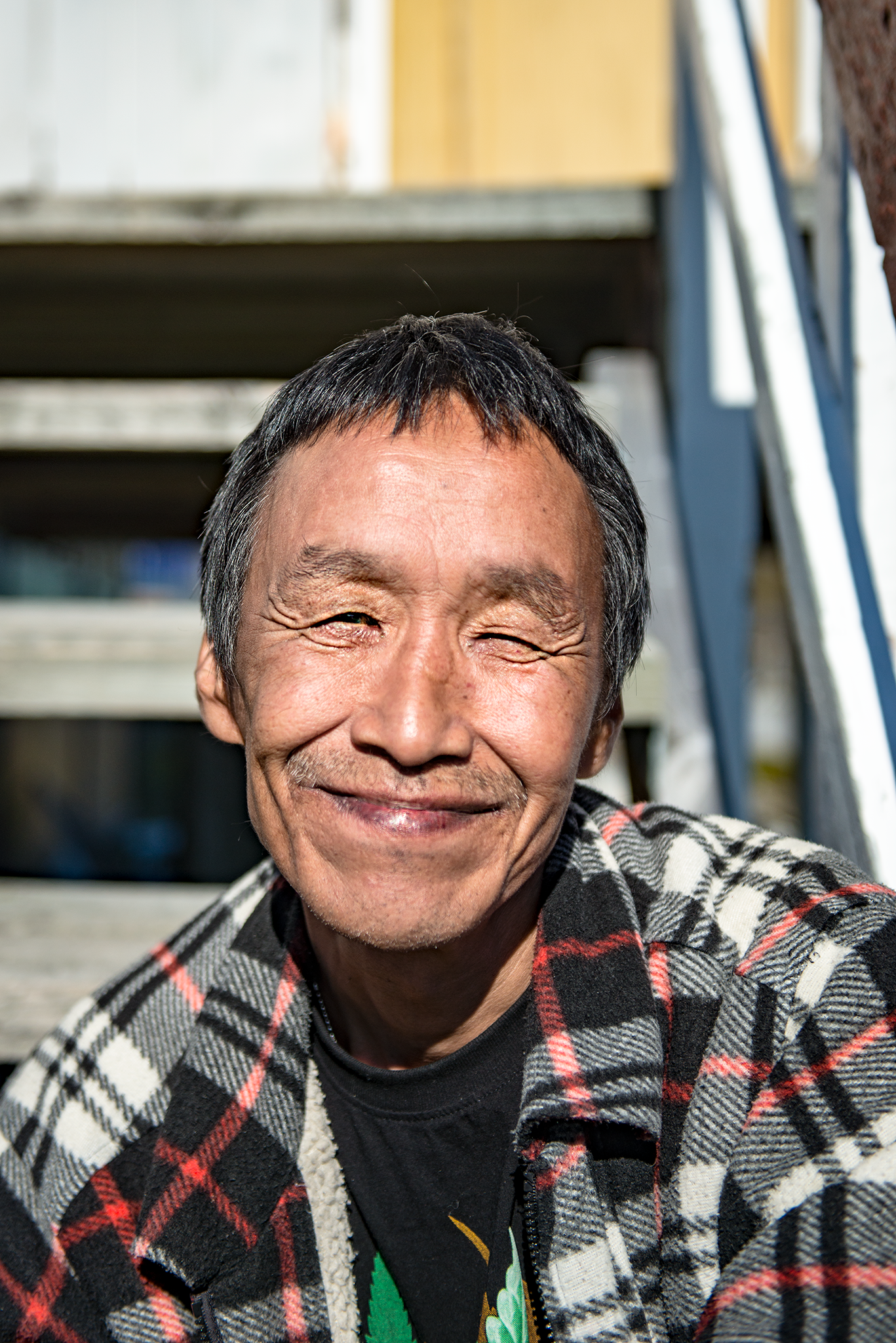
Último change2change en Nanortalik y despedimos a Trejo. Un extremeño curioso,
tiene un blog muy interesante donde cuenta sus aventuras por el ártico y gracias al cual he podido parchear las lagunas de este diario de viaje.
Zarpamos rumbo a Qaqortoq (Blanco). En la zodiac de JJ ondea una bandera pequeña pero totalmente reconocible. Erfalasorput “nuestra bandera” o
Aappalaartoq (la roja).
Thue Christiansen el creador de la bandera la resume de la siguiente manera: la parte blanca de la bandera simboliza la capa de hielo y nuestros fiordos están representados por la parte roja
del círculo. La parte blanca del círculo simboliza los icebergs y la banquisa, y la parte roja de la bandera representa el océano. De camino JJ nos hace una parada en Alluitsup Paa
para el picnic. Allí tienen un centro comercial con una planta llena de trabajadores pegados a ordenadores. Tiene pinta de un centro de control. De forma educada me enseña el baño, una estancia
con 300 rollos de papel higiénico y con otra puerta en el pasillo que conduce directamente al vacío. Es el cumpleaños de JJ y Marie me saca una foto con él y le devuelvo el favor retratando a los
dos cumpleañeros juntos. Tras el picnic volvemos a la lancha y tras una singladura rumbo norte, con el sol cayendo de pleno al oeste (y sin haberme puesto la crema protectora…) las coloridas casas
de Qaqortoq nos recibe con tiempo apacible. Cada color representa un gremio. Desembarcamos los petates, los subimos a un taxi y a pie subimos por la calle Algo Lyngesvej hasta
una casa color mostaza. Escaleras largas, un pequeño porche y varias habitaciones. La mía alicatada de literas hasta el techo. Mis compañeros esta noche serán Jürgen, Konrad, Nicola y Jonathan.
Vuelvo a cometer el error de coger la litera de arriba en núcleo urbano con bares…Tenemos una estancia con ducha y un pequeño baño a la entrada. La cocina es abierta al salón y una gran terraza
que se desaconseja estar varias personas simultáneamente. Al rato sentado allí y con el sol cayendo empieza a refrescar. La casa no me gusta. Antes de subir todos los petates al alojamiento donde
haremos noche, Pedro ha reservado en el Lal’laati Córner, un pintoresco restaurante en mitad de la plaza de la ciudad. En dicha plaza hay una fuente y una casa colonial de hace
200 años, ahora convertida en casa museo. Frente a la casa la estatua de Arnannguaq (“Dulce muchachita”) que si no recuerdo mal es en honor de la primera mujer exploradora.
El misionero luterano Hans Egede fundó la capital de Groenlandia, Nuuk. Es el Apóstol del país. La iglesia de hormigón blanca que está cerca está consagrada a su mujer,
Gerturd Rask. Dentro de la iglesia hay un salvavidas encontrado tras el desastre del Hans Hedtoft. Salimos para dar una vuelta hasta el Lago Taseiqoq, que domina el norte de
Qaqortoq y empalmaremos con la cena. Dejo la cámara y el trípode allí. Es bueno de vez en cuando disfrutar del lugar sin preocuparse de hacer esa foto que estamos todos deseando
hacer. Y de nuevo Sila volverá a disfrutar a mi costa. El paseo transcurre desde la plaza con una fuente hasta un mirador desde el que se divisa toda la ciudad y parte del lago,
donde la gente disfruta corriendo, haciendo mountain bike o en kayak. Nos sigue hasta la cuesta del cementerio un señor bastante desmejorado que más tarde, muy educadamente me pide un cigarro que
agradece hasta en tres ocasiones. Pasamos por unos locales de ensayo muy currados para que los chavales practiquen. La escena me deja embobado viendo como en Madrid cierran salas de música en
vivo y locales de ensayo, mientras que en cualquier pueblito perdido de Groenlandia la música en directo es prácticamente obligatoria. Al otro lado del mirador se ven claramente los grandes
depósitos de combustible para barcos.
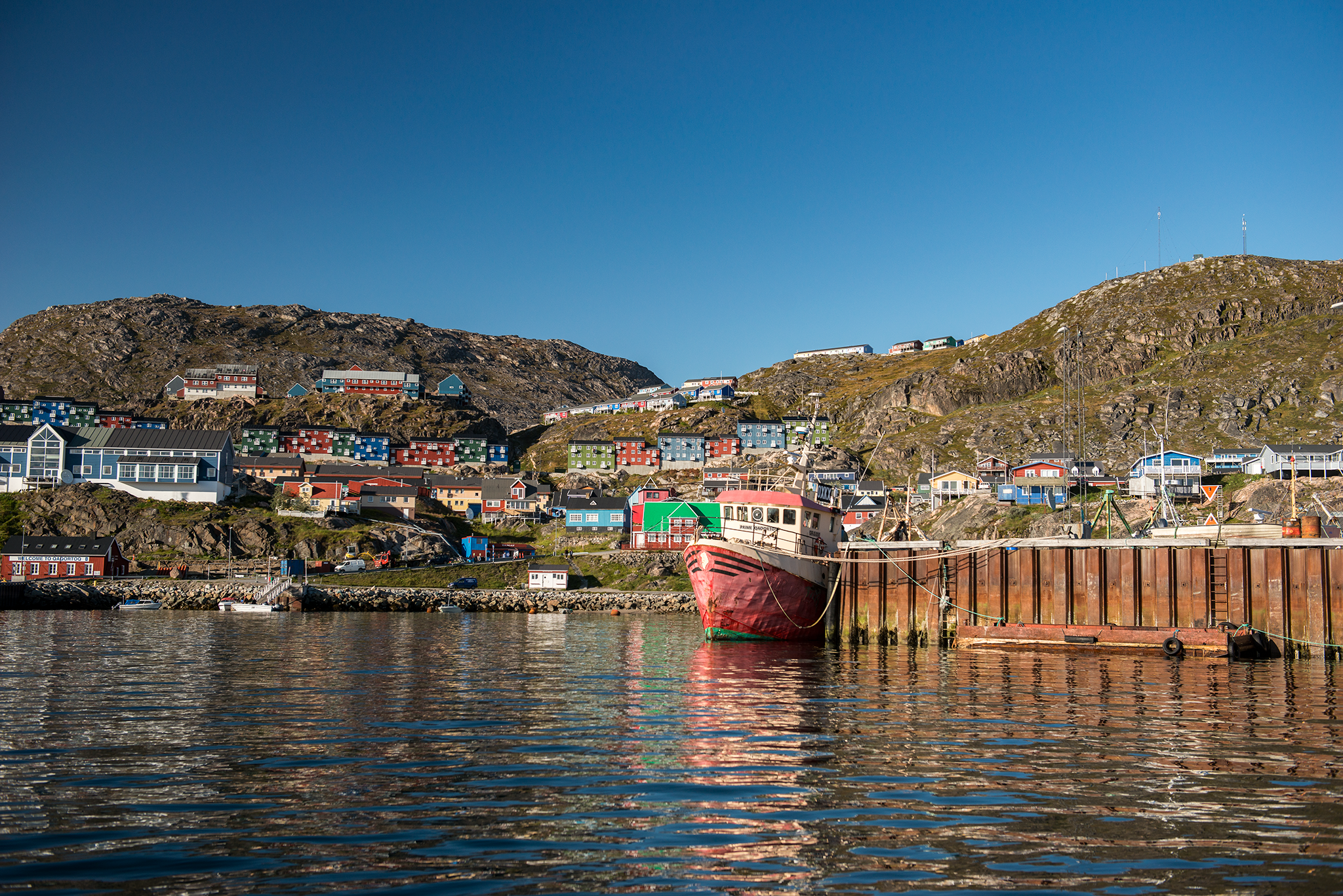
Entramos en el Lal’laati. Es un local de madera muy bien acondicionado. Tenemos reservada toda la segunda planta para nosotros. Jonathan,
con acierto, se enamora perdidamente de la camarera, una rubia platino alta y con rasgos muy marcados (inexplicablemente se olvida a las horas y la cambia por una cantante búlgara, pero…no
adelantemos acontecimientos). Una cena para estómagos agradecidos, bañada en Qajaq, la única cerveza que parece gustar aquí, lejos de la Calsberg y la Tuborg. Como no podía ser
menos, y con mi cámara en la casa, la aurora hace su aparición fiel a su cita, justo al finalizar la cena. Todos disfrutamos del espectáculo de luces. Esta noche vuelve a ser especialmente fuerte
y la expedición se lanza a sacar fotos a la luz de las farolas. Como era de esperar, a los paisanos una aurora más o menos les resulta indiferente. Pedro sacaría una foto estupenda justo en el
zenit: el ojo de Sila. De vuelta a la casa para aligerar ropa y celebrar el cumpleaños de Marie en Rockhouse con la pechotes, una nativa que ha quedado prendada de Pera y la
danesa que nos enseña una nueva palabra: Kassutta (dígase Gass Udda, literalmente “Deja que nuestros vasos se conozcan”). Las mujeres en Groenlandia no dan puntada sin hilo,
avisados estáis. Fumando en la calle charlo con un danés fan del United y de Laudrup. Pedro ya ha hecho dos colegas nuevos. Una pareja canta en directo, no se les da nada mal teniendo en cuenta
que tocan sobre una base pregrabada. Sí, cantan “Despacito”. Sí, cantan Enrique Iglesias. Sí, los españoles nos lanzamos a la pista. Sí, nos miran con cara de extrañeza cuando les cantamos las
canciones a un palmo de su cara. Sí, sospechan que somos españoles y bajan el volumen. Sí, provocamos una estampida de gente a la pista de baile. Cuando hacen un descanso charlo con ellos.
Son búlgaros que se hacen llamar Extasy Duo. Dicen que se sienten inseguros cantando canciones sin saber español en Groenlandia. Para no taladrarme más la cabeza les pido Queen
y consiguen lo imposible: destrozarme media discografía. Afortunadamente nuestros berridos tapan el estropicio. (Conste que son majos y no lo hacen mal pero es bastante probable que las
conversaciones nocturnas con el Capitán Morgan haya desvirtuado la realidad en este punto). Creo que ya hemos probado suficientemente las bondades de la noche de Qaqortoq y nos
retiramos a descansar.
Sunday, 10 September 2017
We wake up sadder of the accustomed. Today we will abandon Tasermiut camp and we'll come back to the civilization again. Perhaps we miss the comfort of a warm bed, but the
surroundings of the fiord are unique and its nights showed us the most spectacular pictures of the island. We have two hours before Trejo and JJ arrive and we must to disassemble all the camp
and go down the equipment to the beach . The gap goes back again, but this time is descent and does more bearable. Camping gas bottles, kitchen, furniture, shelvings, banks, tables. We leave
only the skeleton of the dome and the wooden floor. Trejo arrives accompanied and fill his ship with all the utensils of the kitchen, the tents and the mats. JJ will be a little late and we can
enjoy one last look at Ula. Course NW, destination Nanortalik (literally the place where there are polar bears). Jørgen, Captain Niels’ son, the man for everything in Greenland
awaits us here. At home we leave the camp dismantled and ... our gratitude. Our new house is a building of two floors, warm (very warm) and also cozy. A long staircase leads to a terrace and the
main door, with a small walkway to take off the boots. Downstairs has a bathroom with shower that works perfectly, a living room with two comfortable sofas, iron fireplace and a large window
overlooking the village. There are also three rooms with small beds. Mine is oriented to the east. The second floor has a very functional kitchen and three more bedrooms. On the second floor it
is very hot and the kitchen window is open. The view of the bay from the canteen is spectacular. When Jonathan goes downstairs he has plugged in all his electronic power. Today is Nora's free
night so we have to cook. Everyone look at Nicola and obviously our italian partner prepare his famous spaghetti. We arrive shortly before the supermarket closes and there everyone buys groceries.
I bought two beef steaks, Prince brand tobacco, soft according to the clerk, peanuts and a croissant. One of the steaks will be prepared for Fran (Nico will fill us that night). The heat is suffocating
in the kitchen.
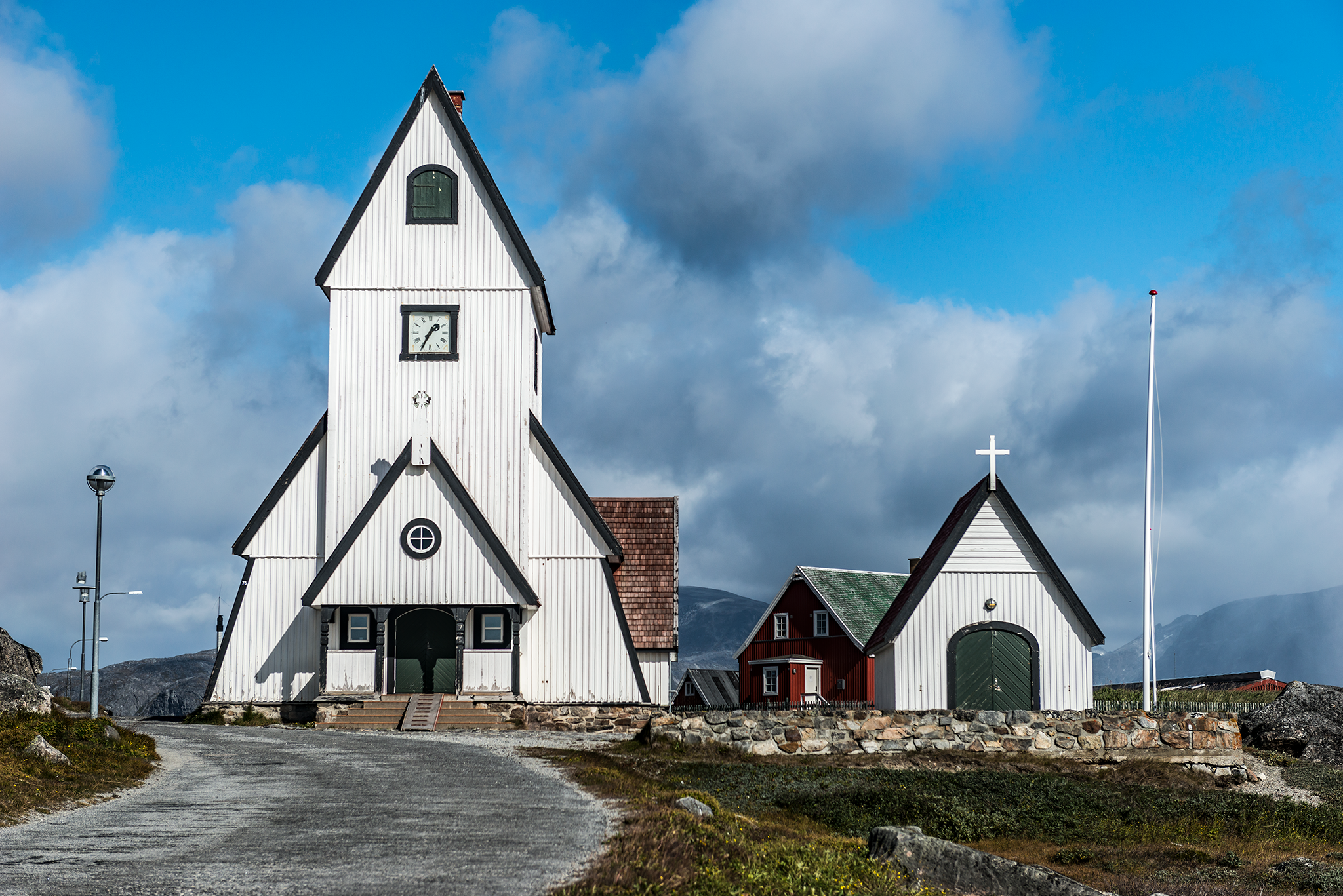
While the group rest after lunch, I take the opportunity to tour the village with Pedro looking for huskies. One of the streets with family houses has a good concentration of
huskies and we play with the doggies. One more time, the weather starts to change. In a electricity tower the children swing around with a rope and a piece of plastic tied. During the hike around
the village we find a transparent bag full of pieces of an animal dismembered. We turn the house around and the woman sends us back to the husband, the caribou hunter. The hunter is peculiarly
dressed with a hat, an apron, glasses and long hair and he tell us that he hunted the animal and that is now drying the meat in the air doing fine cuts. It has a appetizing hue. The haunter have
been talking to spanish travelers before and he sings us "Olé, Señorita!" It starts to rain. We go back to the house. The afternoon runs between laundries, wild parchis and showers.
To take advantage of the heat of the house disassemble one of the laundry bags and use the ropes as a support rope to tend the clothes. We are informed that the village bar closes soon and Trejo
has put us on alert: strong winds are arriving. Nora confirms that we will be two nights in Nanortalik. Strong winds? Bars in a village? What can go wrong? Having bars and after the experience
in Narsaq staying on the land no longer seems such a bad idea. Great dinner and the Nightclubs Explorers will go to the hotel bar. Captain Morgan and "Despacito" in arctic
latitudes. Still raining. A Canadian outcast with us. The waitress and the waiter are still surprised. A young lady approaches and questions us (she looks so excited) if we come from Spain.
On a trip to Mallorca she learned a spanish word: "Bursa". We look ourselves. We asked her for the context and she answers every time she went to pay in the supermarket the girl who attended
her asked if she wanted "bursa". So lovelly. Her name is Tuperna and she is the sister of the owner of the Nuugaarsuk farm.After the dances with the countrymen and farewells with oaths of eternal love, we are going back to the house. It rains on our return. I use one of
the sofa cushions as a pillow. I suspect that the bed, like the tent, is too small for our basque navigator and my snoring is bigger. Our two French neighbors have stayed in the house with
antibiotics. Intense heat inside.
Monday, 11 September 2017, Joyeux Anniversaire Marie!
Regretting to stay in the land the group is divided and some of us will go to the original settlement. The sun shines but it is true that a strong wind makes sailing difficult. The sea foam rises
several meters. Before breakfast I go for a walk in the village. The ravens enjoy the foahn which violently visits the village. The ships are in the port. A metal barrier prevents the entry
of icebergs which could endanger small boats. We are going to visit the village that surrounds the bay and we stop in every house in which we see huskies to take photos. The way is not long but
the bursts of wind make you feel alive for moments in the middle of the civilization. Nennortalik was the original name of the settlement. On the way we found an Inuit tomb
Finally we arrive at the point where we find the town. A white cross looking at the sea awaits us. Courtesy photos and return to the house to eat quickly. Trejo will guide us in the Museum.
There we discover the kindness and habits of the Inuit people. The name of Eskimos was given from the North American Indians by observing that they ate raw meat. Trejo enjoys every explanation
and leave silences so that we can think answers to questions. How did they build with wood if there are hardly any trees in Greendland? Driftwood. How can they survive in such a hostile
environment? Stomachs and seal skins to invent the first goretex. How could they navigate without dazzling? Here it is the first sunglasses made of wood. The Inuit have a very curious way of
defining art, for them Eqqumiitsuliorneq is "strange things done by others." He also tells us that most of the museum's pieces are the work of a neighbor. Between the stories
emphasizes one of the symbols of the Danish navy, Hans Hedtodt, the little Titanic. Its builders remembered the Titanic's past and boasted that this could never happen to Hans Hedtoft. Built
for the greater glory of the Danish it was lost on January 30, 1959 coming back from the maiden voyage from Greenland to Copenhagen, south of Cape Farewell. Only lifebuoys would appear.
Trejo keeps on explaining the traditions and regional costumes of the area. It is worth seeing the reproductions of whalers and kayaks with manually sewn seal skin. They achieved great results
with the raw material they had. Traditional masks, delicate sizes and other ornaments are presided over by the skin of a polar bear (the nanoq hunter) of medium size.
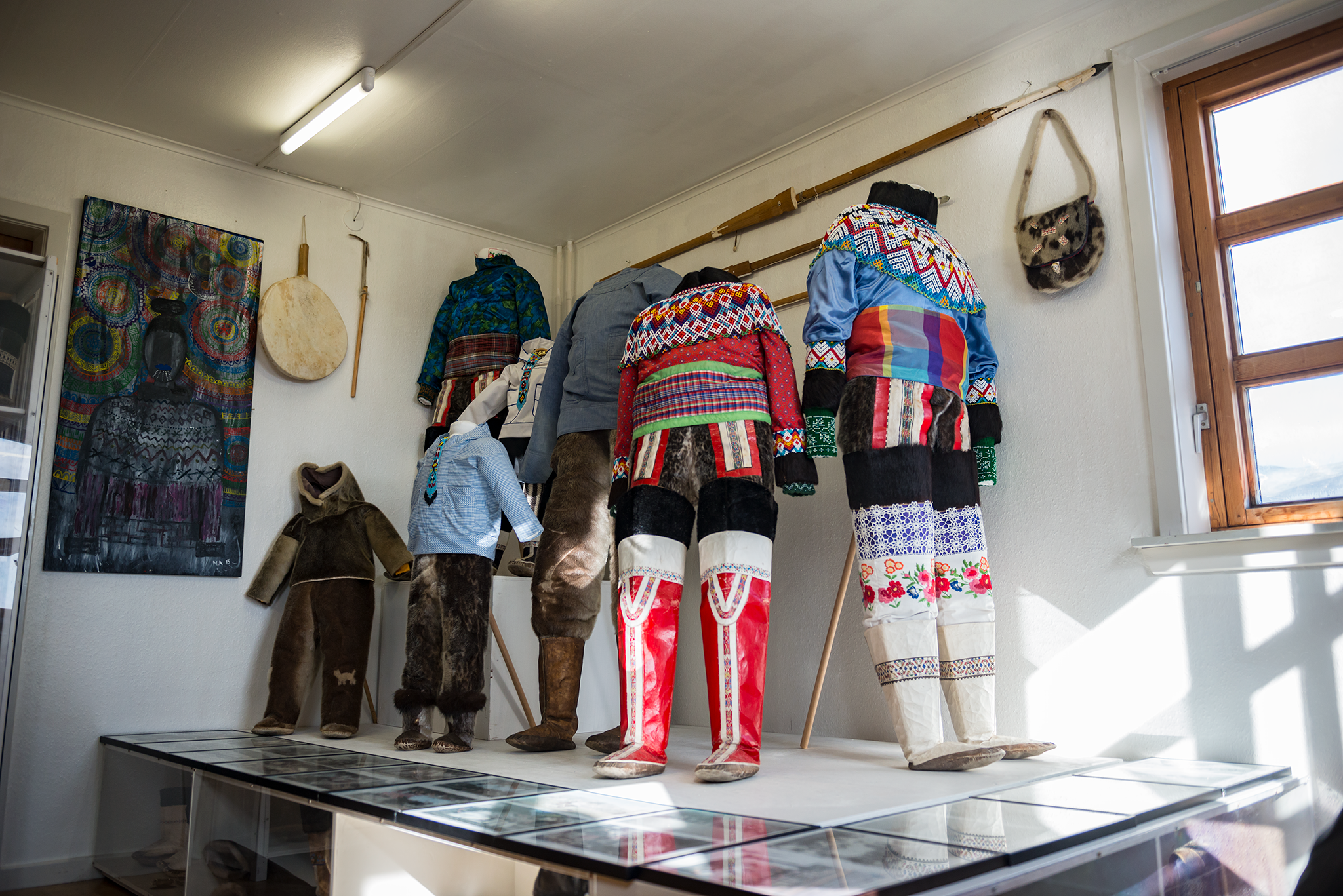
Did you saw boat’s name in
pictures? The ship commanded by Captain JJ is named Avannaq, literally "cold north wind" and can reach speeds between 45 km/h (with load) and 74 km/h (empty). The original kayaks
have a bag to store pieces and other ideas to make easier the crossing by the icy waters. The building is decorated with old photos. Each piece of hull skin is manually stitched into a tight bond.
The kayak roll (esquimotaje) training is so important that they use to organize contests to see how many turns they are able to make. On the second floor we will see the only Arctic fox of the
trip, dissected. We left the haystack and we went into the whaling workshop. In the interior, an immense press to work the whale oil, huge saws to cut the ice in the sea and whale phalanx.
Among the conversations are stories of scurvy and vitamin C deficiency, as explorers of the early 19th century managed to survive or not survive depending on their conditioning to raw or smoked
food (the properties of food lose by heating them to high temperatures and here that is a big mistake). Pear, Amundssen, Scott, Shackleton, Nansen ... inspiring names. Despite
sunny day, the foahn snatches the heat from the rooms. I comment with Trejo the traditional songs for Inuit days of solstice but finally I think they are Sami people songs. The next building
is narrow and tells us about the geology of the place. We discussed the outdoor gold mine in Nanulaq (in front of Kusisuaq, where the puppies are) and where
Captain Jørgen worked and we remember the stop at the Amitsoq graphite mine. Nora had told us that one of the most prized stones in Greenland is the Tugtupite.
An anhydrous sodium and beryllium aluminosilicate with chlorine anions and impurities of iron, gallium, magnesium and others. It is piezoelectric, so it is capable of generating electric current
by means of pressure and voltage, in addition to having tenebrescence: darker when exposed to light and clear in dark places. Discovered in Tugtup Agtakortfia north of
Narsaq. Tugtupite comes from the kalaallit oqasii and is literally reindeer's blood (tugtup is reindeer). Time to back to the house, today
we will have dinner soon that we can find clubs opened! At the end of the dinner Nora surprises to Marie with a cake. On the face of the birthday girl shows an emotion that barely contains
only broken by the tricked candles. The nightclub explorers go to Café 44, closed on sundays. The owner tells us that JJ has been close to Qaqortoq playing with
waves up to 4 meters. JJ is a celebrity here. The atmosphere inside the nightclub is darker. A complete stage of instruments and an acoustic gibson that does not sound bad. The club is out of
party. We have to go to the hotel bar. After last night Nanortalik is dead. I remember the screams of a girl who told us yesterday: "tomorrow I do not go out, I have to work!"
as she left his eleventh beer at the table shared with his friends. Neither the Canadian man who lends us his smartphone gets up the night. We returned to the house after a brief chat with
Captain Morgan. The night is more placid. We rested. There are still interesting things to do and to see in Nanortalik before left the town. Dawn on tuesday and the water closet does not
works when I pull the chain. The water level rises in the toilet. Am I in troubles? Black bags no longer seem such a bad idea…
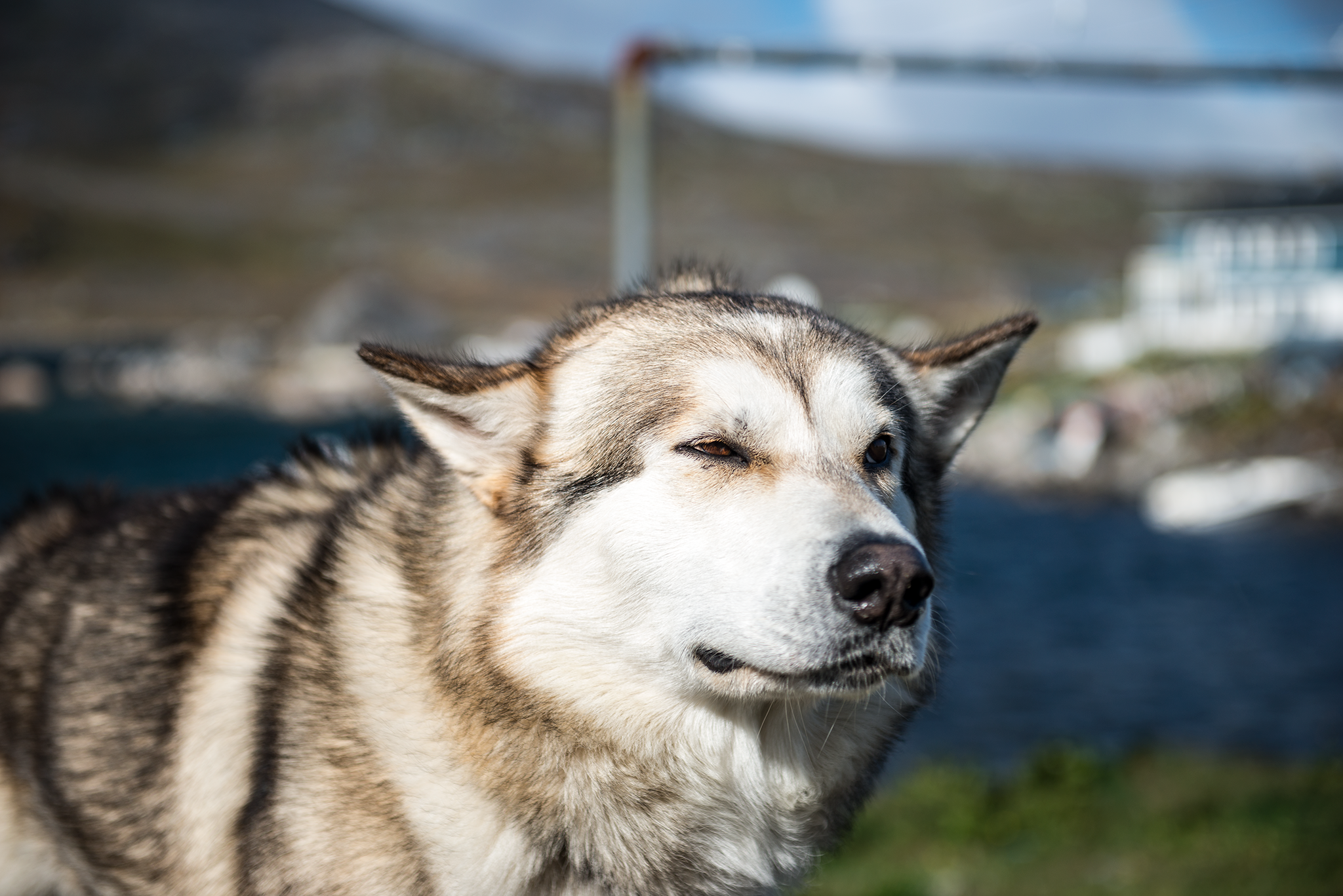
Tuesday, 12 September 2017 Inuuinni pilluarit JJ!
Confirmed, we got a jam in the well. A worker comes early in the morning to clean the well and everything works again. I get up early and take a short walk through the village. The foahn has
completely disappeared and today crows do not enjoy it so much. One of them died yesterday right to our house. I am sitting on stairs when Nora arrives for breakfast. At noon we'll change
Nanortalik for Qaqortoq. It's my turn to clean the dishes and I ask Lolo to buy me a map. I go to the tourist office and meet Chris and Stephan. Jonathan's
coming with me. There I bought a T-shirt thinking about the planes that are waiting for me and, despite drying the clothes well, the humidity stays in the clothes and the environmental odors
of the houses pass to the thermal shirts. I also get angelica seeds and a holographic polar bears magnet. We spent time touring Nanortalik: huskies and strange couples drinking
at 10 am and we’re hallucinating with the fireplaces. The chimney construction consists of bricks that appear to be randomly placed. The supermarket has one that it will stand up no far
Christmas. It is the oven chimney and I have to admit that the scones are delicious. The mornings move less than in Narsaq. The fish market runs from the early hours of the
morning and next to there is a small clothing store. Marie and I walked in and the clerk took great care of us. A brand predominates there: INUIT. Time to go back to the house
and finish cleaning.
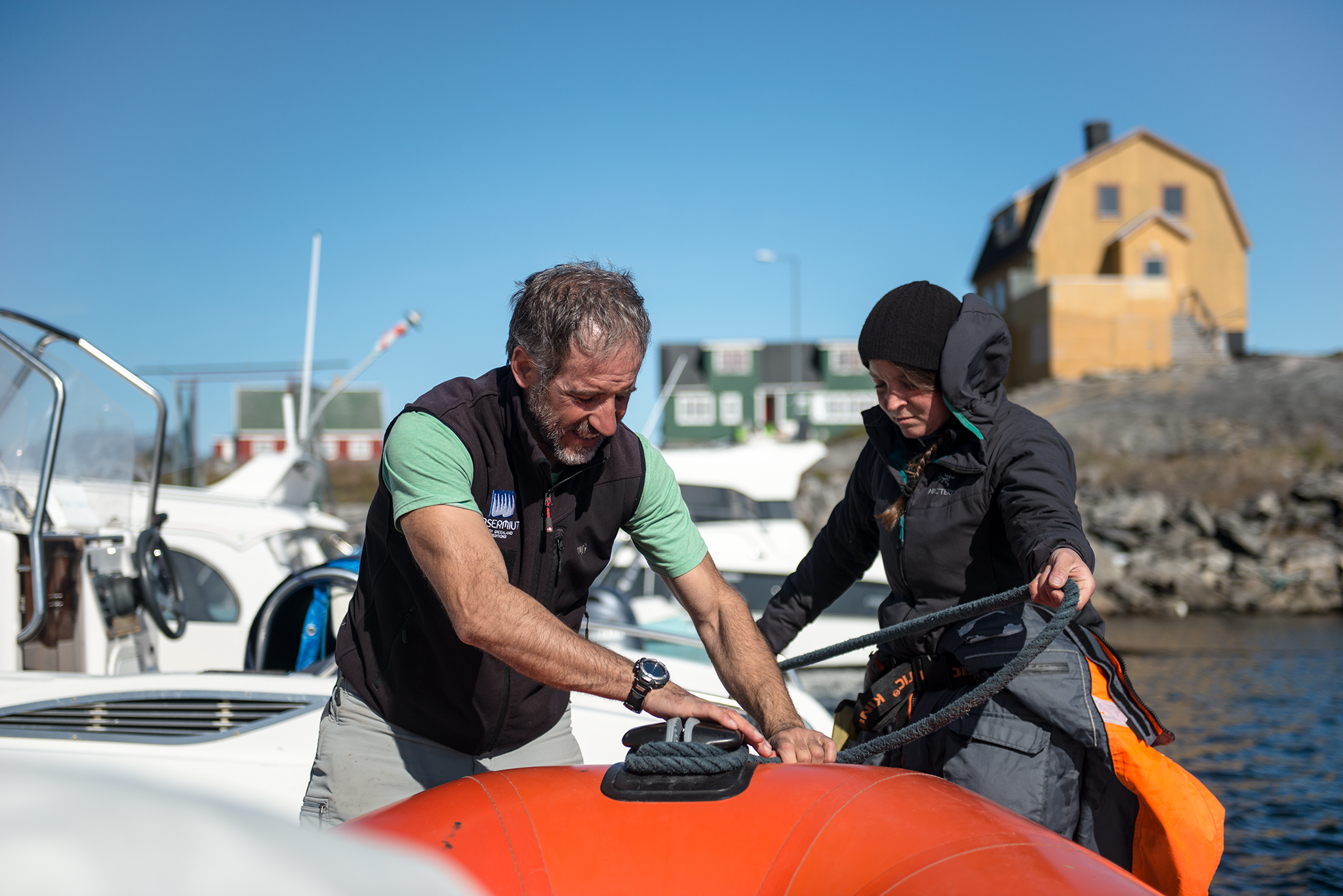
We loaded the boat and said goodbye to Trejo. A curious western Spanish man, has a very interesting blog where he explains his adventures in the Arctic and thanks to which
I have been able to mend the gaps in this travel diary. We headed in course NW to Qaqortoq (White). On JJ's boat a small flag flies. Erfalasorput "Our flag"
or Aappalaartoq (the red). Thue Christiansen is the creator of the flag. The white part of the flag symbolizes the ice cap and the fjords are represented by the red part of the
circle. The white part of the circle symbolizes icebergs and ice cap, and the red part of the flag represents the ocean. On the way JJ stops at Alluitsup Paa and there we eat.
They have a mall with a plant full of people working on computers. The room looks like a control center. The boss accompanies me to the bathroom, a room with 300 rolls of toilet paper and
another door in the hallway that leads directly to the void. It's JJ's birthday and Marie takes a picture with him and I return the favor by portraying the birthday guys together. After the
picnic we returned to the boat and turn north, with the sun falling from the west (and without putting me on the sunscreen I’ll come looking like a raccoon to Qaqortoq).
Qaqortoq welcome us with a blue sky. We disembarked the green bags, took them to a taxi, and walked up Algo Lyngesvej street to the yellow house. Long stairs, small porch
and several rooms. My room full of bunk beds. My companions tonight will be Jürgen, Konrad, Nicola and Jonathan. I again make the mistake of taking the upper bunk in urban core with night
parties ... At the end of the hallway there is a shower and a small bathroom at the entrance. The kitchen is open to the living room and a large terrace in which it is not advised to be several
people simultaneously. After sitting there and with the sun falling I'm feeling cold. I do not like the house. Before uploading all the travel bags to the accommodation where they we'll sleep
this night, Pedro has booked in the Lal'laati Corner, a quaint restaurant in the middle of the city square. In this square there is a fountain and a colonial house of 200 years
old, now it becomed a museum. In front of the house the statue of Arnannguaq ("sweet girl") that if I remember correctly it was made in honor of the first woman explorer.
Lutheran missionary Hans Egede founded the capital of Greenland, Nuuk. He is the Apostle of the country. The white concrete church is dedicated to his wife, Gerturd Rask.
Inside the church there is a lifeguard found after the disaster of Hans Hedtoft. We start the march to Lake Taseiqoq, which dominates the north of Qaqortoq and
after the hike we will dinner. I leave the camera and the tripod in the house. And again Sila will have fun again with me. The walk passes from the square with a fountain to a viewpoint
from where you can see the city and part of the lake, where people enjoy running, cycling or kayaking. We hike the slope of the cemetery followed by a delicate health man and then, politely
asks me a cigar that thanks me on three occasions. We passed some rehearsal venues for young people who want to set up a music group. The scene makes me dizzy watching how live concert halls
in Madrid and rehearsal places are disappearing, while in any lost town of Greenland live music is practically obligatory. Just across the viewpoint you can clearly see the large fuel tanks
for the ships.
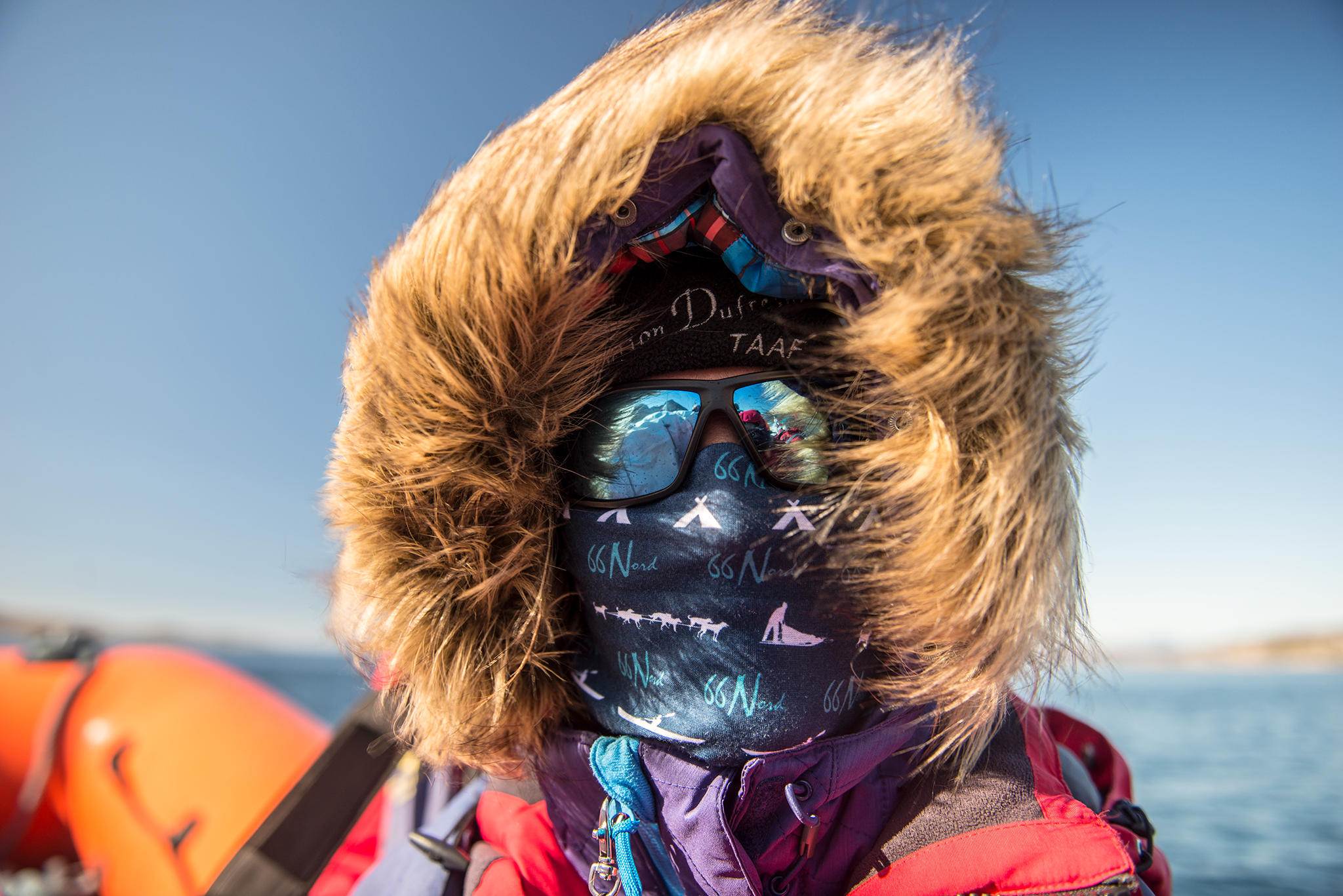
Lal'laati is a very conditioned wooden place. We booked the entire second floor for us. Jonathan, with a good eye for the girls, falls madly in love with the waitress, a platinum blonde girl very kind (inexplicably Jonathan will forget about it after two hours and will change the waitress for a Bulgarian singer). A dinner for grateful stomachs, bathed in Qajaq, the only beer that seems to please here, away from the Calsberg and Tuborg. As it could not be less, and with my camera in the house, the aurora makes its faithful appearance to its appointment, just at the end of the dinner. Everyone enjoys the light show. Tonight it becomes especially strong and the expedition run to take photos under the light of the street lamps. As expected, the countrymen are indifferent to the auroras. Pedro took a great photo at the zenith: Sila's eye. Back to the house to change clothes and celebrate Marie's birthday in Rockhouse with Big Boobs Woman, a native who has been pampered by Pera and a Danish woman who teaches us a new word: Kassutta (say Gass Udda, literally "let our glass beakers know each other"). Women in Greenland do not give stitches without thread. I go out side to smoke with a Danish Manchester United and M. Laudrup supporter. Pedro has already made two new colleagues. A couple sings live. Yes, they sing "Despacito". Yes, they sing Enrique Iglesias. Yes, the Spaniards go onto the dance floor. Yes, they look at us strangely when we sing the songs in Spanish a span of their face. Yes, the musicians suspect that we are Spanish and they turn the volume down. Yes, we caused a stampede of people onto the dance floor. When the musicians take a break I'm going to talk to them. They are Bulgarians and are called Extasy Duo. They say they feel insecure singing songs in Spanish in Greenland. In order not to pierce my ears any further I ask them if they can sing Queen and they manage to do the impossible: to destroy the entire Freddie Mercury discography. Fortunately our shrieking cover the mess (ok, they are nice and they do not play it badly but it is quite probable that the nocturnal conversations with Captain Morgan distort the reality in this point). I think we have already sufficiently proved the goodness of the night of Qaqortoq and retire to rest.
Miércoles, 13 de septiembre de 2017
Desayunamos en la casa deprimente. No me preguntes porqué, es la sensación que me provoca estar entre sus paredes. Tras recoger rehacemos el camino del día anterior. Un taxi carga nuestros petates
hasta el embarcadero y nosotros caminamos hasta allí. De día Qaqortoq tiene bastante más vida que los lugares que hemos visitado antes y se nota en la cantidad de taxis que pasan
incansables por delante de nosotros, tanto de día como de noche. Por cierto, también Toyotas. Para ser honesto, la litera de Qaqortoq es la más cómoda del viaje. En puerto volvemos
a hacer el change2change para cargar la zodiac mientras juego con una niña a escondernos. Destino: Qalerallit Camp. El campamento glaciar. La singladura rumbo NW es de las más
bellas de toda la expedición. Icebergs totalmente transparentes de color esmeralda nos dejan ojipláticos. El viaje es corto. A nuestra llegada el grupo de españoles del Consorcio guarda silencio
sepulcral mientras atracamos. Algo ha pasado ahí. Cargamos con todo hasta las tiendas domo, que son magníficas construcciones de metal formando figuras geométricas y protegidas por una lona.
Las puertas pese a que cierran un poco porculeras por la holgura de las tuercas que componen el picaporte, son eficaces para mantener el calor dentro. Estamos protegidos del suelo y dentro
tenemos espacio suficiente para 4 literas y una pequeña mesita con una sillita de plástico. La nuestra será la tienda íntegramente vasco-catalana-española. Una pequeña ópera nocturna multicultural
y trilingüee. La noche de ayer desde este punto tuvo que ser mágica. Se divisan lenguas glaciares desde el mismo campamento, y sobre ellas el inmenso Inlandis. Tras recibir
instrucciones de Francesco acerca de los #2 y de la logística del campamento, instalarnos en la tienda y descargar enseres en la cocina, bajo hasta la playa donde pequeños hielos han quedado
varados. Cientos de gaviotas esperan el momento de salir volando. Dentro de los baños portátiles secos, un inmenso retrete completamente limpio, varios rollos de papel, un ambientador,
un jabón de manos desinfectante y 3 m de caída a la más absoluta oscuridad. Perder pie aquí no es buena idea. Desde la playa observamos cómo los capitanes tratan de reflotar una de las lanchas
que zozobra sin remisión. La maniobra consiste en arrastrarla y que la propia fuerza del agua mantenga a flote la embarcación. Parece hundirse sin remisión. Comemos en la tienda comedor y nos
dirigimos al meeting point con Nora para cruzar el fiordo de Qalerallit para acercarnos a los muros del glaciar. En aquel mismo instante, mientras esperamos al resto de la
expedición, una nube negra se levanta desde la parte de atrás de nuestro campamento. Damos el aviso a Nora y nos pide que nos quedemos allí mismo. Lógicamente, ignoramos sus instrucciones y
le acompañamos por si hiciera falta ayuda. En el camino solo podemos pensar en qué producirá un humo tan negro en medio de la nada. Únicamente se nos ocurre la goma de la zodiac mezclada
con carburante. No es la Leif Erickson ni la Avannaq. Hemos tenido suerte, pero probablemente Francesco y otro grupo no. Cargamos la lancha con las mochilas
y JJ nos acerca a la primera lengua del glaciar. Nos tiene reservada una sorpresa. Desde la zodiac el inmenso muro de hielo azul se va haciendo cada vez más y más grande y bajo su cobijo cientos
de gaviotas reposan tranquilas. JJ en un momento dado detiene la embarcación para que podamos hacer fotos ¿Por qué no avanza más? Aún estamos lejos de la distancia de seguridad. En un momento JJ
acelera al máximo y provoca una desbandada de las aves que encajan con el glaciar con una composición perfecta. El espectáculo es irrepetible y sobrecogedor. Casi podemos tocarlo. Al finalizar
la maniobra y con todo el pasaje emocionado por el momento que nos tenía reservados JJ, le digo “¿Te encanta hacer esto, verdad?” JJ se ríe. Aún no ha celebrado su cumpleaños y le digo que aquí
es bienvenido.
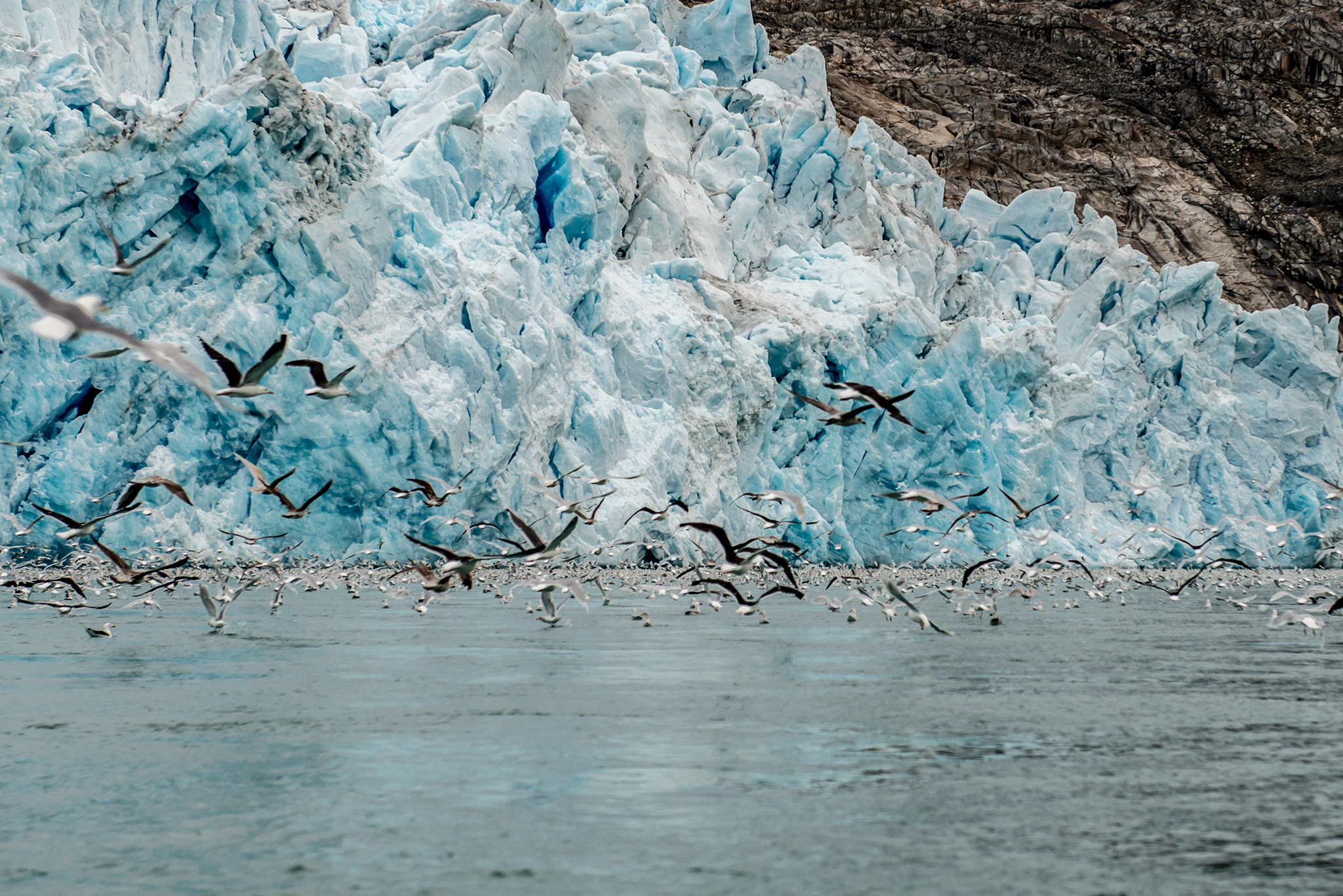
La lengua de la derecha ha retrocedido y no es tan espectacular. Queda una tercera lengua, será allí donde desembarquemos. Todavía recordando el momento vivido desembarcamos
y dejamos las parkas bajo una lona. El tiempo apunta ya un cambio y las nubes empiezan a cubrirlo todo. Nos volvemos a cruzar con el Consorcio. Algo va mal. Nos cuentan que han pasado mucho frío
y que pidamos otro saco de dormir…Alguien no leyó bien dónde se aventuraba, supongo, pero voy confirmando poco a poco la primera impresión que tuve de ellos en Keflavik. Y no, no es una cuestión
de diferencias generacionales (excepto con uno, que me calló bastante simpático). Una breve caminata nos lleva al punto de reunión con Francesco, que ejercerá de guía de la marcha con crampones
sobre el hielo. Algo le preocupa, se le nota nervioso. Nos da indicaciones para colocarnos el arnés por encima de toda la ropa, y de la forma de ponernos los crampones. Son más duros, y bastante
más fuertes que los míos. Uno de los dientes traseros se me sale y Nora me ayuda a calzármelo de nuevo. Casco puesto. Estamos en los pies del glaciar. Un desnivel de unos 200 m nos separa del gran
blanco. Todo preparado. Últimas instrucciones de Francesco y Nora. Grandes grietas se abren a nuestro paso, algunas de 20 y 30 metros. Francesco nos ayuda a sacar fotos en situaciones delicadas.
Por detrás, Nora y Nicola ayudan a Fran con Jürgen. El tiempo, tanto meteorológico como de hora, impiden que subamos hasta el punto más alto. Desgraciadamente no podremos ver el Inlandis.
El cielo sigue cubriéndose aún más. Fotos de rigor y caminata de vuelta a la base del glaciar. Guardamos los crampones, no sin antes darles un buen lavado para evitar la oxidación, los arneses
y los cascos. Pienso para mí que es otra buena razón para volver y ver con mis propios ojos el inmenso desierto blanco. Mientras el resto termina de quitarse los útiles para el hielo,
Francesco me mira y me dice ¿Tú cantabas? Y nos bajamos los dos cantando, y mientras cantamos se va relajando y me cuenta las causas de sus nervios.

De vuelta con JJ al campamento, otro grupito
de españoles, estos bastante más majos, me cuentan que hoy no pudieron llegar hasta la lengua glaciar por la mañana porque estaba todo congelado para el desembarco y que ni siquiera han conseguido
hacer kayak porque les cogió el día de los vientos huracanados con todos los icebergs en la bahía de Tasiusaq. Otro chaval me cuenta que él sí ha podido porque cogió un paquete
que mezclaba mountain bike y kayak. Los chicos son vascos y me caen de puta madre. Como siempre después de una experiencia así cenamos entre risas y el rugido de la cascada que está justo detrás
del campamento. Y de algo más. Los más que impresionantes estruendos de la rotura del glaciar que parecen truenos a punto de abrir la tierra delante nuestra. Lluvia ligera, enemiga mortal del hielo.
El nuevo foahn que se ha levantado y la lluvia pondrán a prueba la resistencia de nuestras tiendas domos. Son cómodas. Por primera vez aprendo la lección y le pido a Jonathan que coja la litera
de arriba. Él será por esta vez mi esponja. Antes de dormir carreras furtivas a la luz de los frontales al baño. Sobre el fondo el baile de sombras de las velas de las cocinas. A la cascada y
al glaciar le ha salido un duro competidor. Los pulmones de Pera son poderosos y acunan nuestra tienda hasta que nos quedamos dormidos. Mi navegante vasco es ahora un templario dormitando en la litera
superior. Tratamos de secar la ropa húmeda pero Sila ya tenía preparado para nosotros el resto del viaje.
Jueves, 14 de Septiembre de 2017
Un inmenso estruendo despierta la tienda. El rugido de la cascada y el deshielo del glaciar parecen aumentar su volumen. Llueve incesantemente desde anoche y el día amanece sin tanto aire. Fuera
el cielo está gris y la bruma no nos deja divisar el glaciar y a duras penas vemos los perfiles de pequeños icebergs nuevos que han ido a varar a nuestro lado de la orilla del fiordo. No queda
ni rastro de los de ayer. La expedición remolonea en las tiendas y la llegada al domo de la cocina ya no es tan alegre como otros días. Hoy nuestra misión es salir a la búsqueda de caribús. Las
caras de los exploradores están como el día. Hoy tendremos bajas. La lluvia parece que no solo rompe los glaciares. Nora, con el tono de voz del que sabe que solo puede recibir una respuesta
negativa, propone que pese a la lluvia será interesante subir hasta el lago Tasersuatsiaq, donde suelen pacer los caribús. Las miradas están centradas en el hule de la mesa
de desayuno (el hule de Nanortalik tiene espléndidos motivos navideños y de éste en concreto no tengo ningún recuerdo). Hay que levantar esta situación. “¿A qué hora se salimos?”
La mirada de Nora cambia: ya tiene cómplices bajo la lluvia. Ocho expedicionarios iremos a la búsqueda de caribús, llueva, truene o se acabe el mundo. Cargamos con comida ligera y los termos.
Cerca de las 10:30 AM es sencillo cruzar la cascada que sigue rugiendo y aumentando su volumen de agua. Remontamos uno de los ríos y llegamos a un inmenso valle desde el que se divisan montañas
verdes en su vertiente izquierda. Allí deberíamos poder cruzarnos con caribús. Los ríos bajan fuertes en el fondo del valle, pero aún no encontramos un pasaje complicado para el avance.
Ha sido empezar la marcha y las caras vuelven a ser las mismas que estamos acostumbrados a vernos a diario. Ataviados con nuestras mejores galas para la lluvia las bromas retornan de nuevo
para acompañarnos en el valle. Estamos contentos y la lluvia continua implacable. A la derecha ascendemos las laderas desiertas propias de un paisaje lunar para alcanzar la meseta que otrora
ocupara el lago…y los caribús. En España, los óvidos, cérvidos y ganado en general acostumbran a tumbarse cuando llueve. Si aquí los rumiantes tienen la misma costumbre será complicado verlos.
La meseta en la que nos encontramos es inmensa. El tiempo comienza a recrudecerse en este punto. En el fondo del valle las paredes nos cobijan bastante del aire. En la meseta los ríos bajan al
lago más caudalosos y tienen fuertes corrientes. Nos detenemos. La anchura y la profundidad es tal que podemos calarnos y que el viento nos arrebate el calor corporal a mitad de camino.
Tras varios rodeos, avances, retrocesos y caminos alternativos para vadear el río y llegar al lago solo quedan dos opciones: retroceder o...Con una mirada cómplice y sin hablar alguien coge
una piedra gigantesca y la tira cerca de nuestra orilla. Carcajadas. Tenemos un nuevo juego: construye tu propio puente y además, nos hará entrar en calor (a la vez que se demuestra que ni la
lluvia ni los elementos pueden con la voluntad absurda de avanzar hacia lo desconocido). En no menos de tres ocasiones armamos nuestros improvisados puentes y tratamos de no convertirlo en un
juego de petanca extrema. Pedro suele cruzar el primero y armar el puente desde la otra orilla. Otras veces será Jonathan. Así, entre río y río, llegamos al lago. Ni hay rastro de caribús,
únicamente encontraremos pelaje a la vuelta. El agua ha borrado cualquier rastro de huellas. El lago es fantástico y tanto la niebla como la bruma le dan un aire místico. El agua no está
excesivamente fría. Tras la foto de equipo regresamos. Hasta el momento hemos disfrutado calándonos. La vuelta ya no es tan cuidadosa. Pera se propone comprobar la teoría de la tensión superficial
del agua cruzando corriendo una de las corrientes y por el resultado parece que funciona. Los ríos han crecido y la fuerza de la corriente arranca grandes trozos de las orillas ensanchando
por momentos el caudal a nuestros ojos. Casi al final del recorrido Pedro carga con Lolo a su espalda para cruzar uno de los últimos escollos. Tras toda la travesía parece que casi todos estamos
en igualdad de opinión respecto a querer conservar un acuario en cada bota. Queda un último paso: la cascada que en esos momentos ruge aún con más rabia. El volumen de agua debe haberse triplicado
y cruzamos despacio hasta el otro lado. A unos metros queda el campamento. Toca cambiarse y convertir la tienda en un tendedero improvisado. Encendemos la calefacción que será nuestro tótem
particular al que daremos de comer botas, calcetines, plantillas…es insaciable, cada vez pide más. Por precaución y con vistas a la caminata con crampones he traído un segundo par de botas
remirígidas, las Bestard de Paramontaña. El primer par se los presté a Pedro para el día del glaciar dado que las suyas ya habían hecho
su trabajo y andaban atadas con bridas. Después de comer pasamos la tarde revisando con Nora el viaje con un mapa delante y adorando al Totem Shoes. La evaporación del agua provoca
efectos relajantes. Pedro y Pera reparten vino español para elevar el espíritu. La lluvia parece cesar poco a poco. Nuestra cocina es ahora un inmenso tendedero. Cenamos sin caribús y aún así
estamos contentos y satisfechos. Nora verbalizó en el lago lo que todos pensábamos y dentro de la tienda, en la cena, un primer pensamiento nubla mi mente: mañana zarparemos rumbo a
Qassiarsuq. Hoy será nuestra última noche en el campamento glaciar. En la oscuridad de la noche tres luces rojas palpitantes languidecen en la oscuridad ¿Qué ocultaban las nubes
estas dos últimas noches para que ninguno pudiéramos contemplarlo? Sila tiene un humor muy particular. La expedición regresa a las tiendas para descansar.
.
Wednesday, 13 September 2017
We had breakfast in the dark house. Do not ask me the reason I'm feeling bad between its walls. To be honest, Qaqortoq house's bunk is the most comfortable of the trip.
Again a cab carries our bags to the pier and we take a walk there. Qaqortoq has much more life than the places we have visited before and taxis pass untiringly ahead of us,
both day and night. In the port we start the change2change to load the boat while I'm playing with a girl in hiding. Place of destination: Qalerallit Camp: the ice camp.
The journey NW course is one of the most beautiful of the expedition. We leave behind completely transparent icebergs with emerald shades.
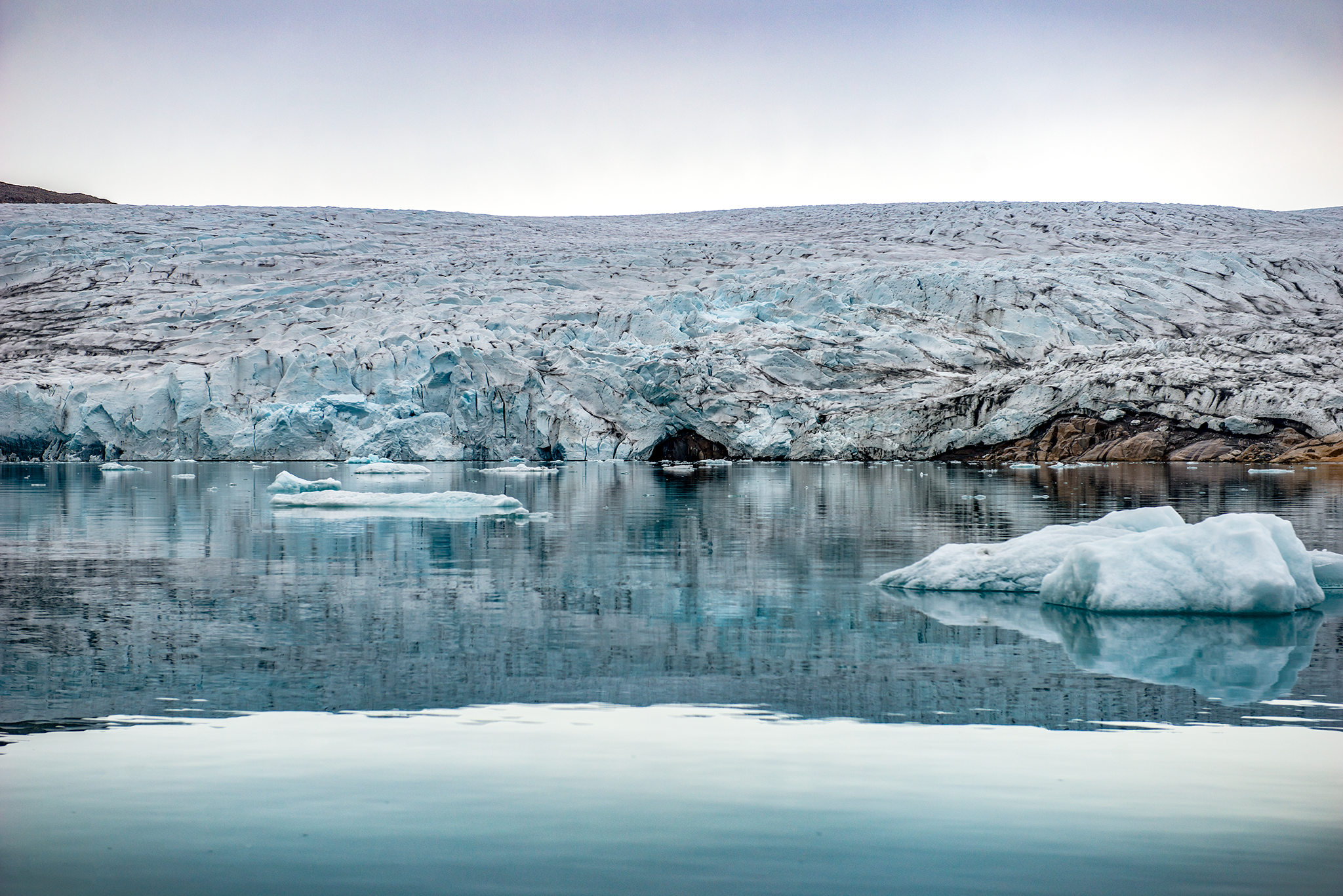
The trip is short. At our arrival the group of Spaniards
of the Consortium keeps silence while JJ maneuvers the boat. Something has happened here. We load our supplies to the tents, which are magnificent metal constructions forming geometric
figures and protected by a waterproof canvas. The doors, despite not closing well, are effective in keeping heat inside. We are protected from the ground and inside there is enough space
for 4 bunk beds and a small table with a plastic chair. Ours will be the Basque-Catalan-Spanish dome tent. The multicultural and trilingual opera. Last night at this place had to be a dreamy
evening. Before us a panorama never dreamed before. Three glacial fronts die on the fjord and on them the immense and white Inlandis. After receiving instructions from Francesco about #2 and the
logistics of the camp, we settled in the store and unloaded the utensils in the kitchen. After that I hiked to the beach where the small icebergs have been stranded. Hundreds of seagulls wait
for the time to fly. Inside the dry and portable bathrooms, an immense clean toilet, several rolls of toilet paper, an air freshener, a disinfectant hand soap and 3 m drop to the absolute
darkness. Losing your foot here is not a good idea. From the beach I watch as the captains try to refloat one of the boats. The maneuver consists of dragging it and trying to reduce water
from the boat. It seems to sink without remedy. Never leave a Basque navigator an ice axe to collect ice without protecting your eyes!! We eat in the tent that serves as a kitchen and we head to
the meeting point with Nora to cross the Qalerallit fjord to approach the walls of the glacier.
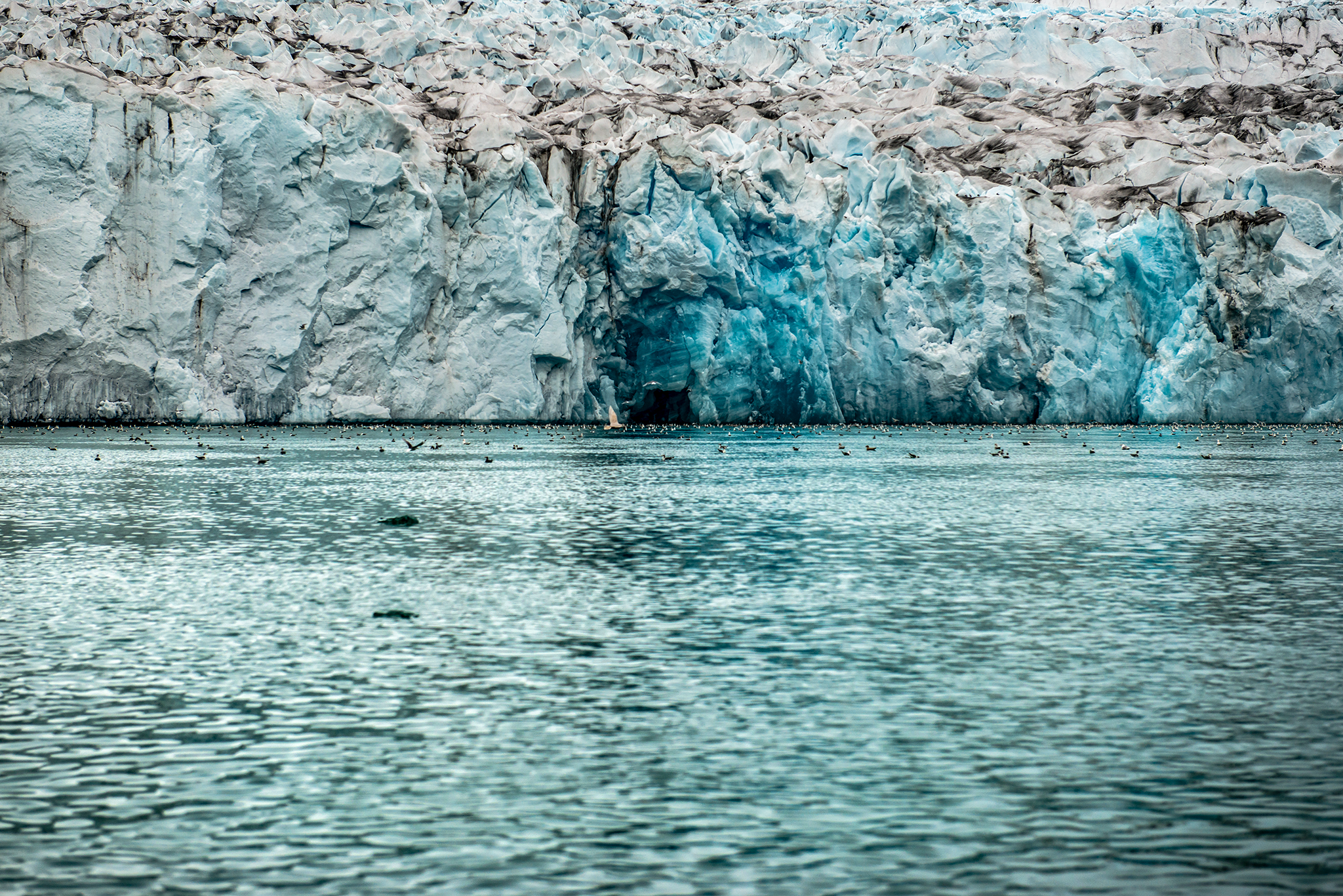
At that moment, while we’re waiting for the rest of the expedition, a black cloud
rises from the back of the hill that separates the fjord of the camp. We warn Nora and she commands us to remain still there. Logically, we ignore the instructions and accompany her in case
they need help. Along the way, we only think about what will produce black smoke in the middle of nowhere: rubber from the boat mixed with fuel. It is not the Leif Ericsson nor the Avannaq.
We were lucky, but probably Francesco and another group of expeditionaries did not. We load the boat with the backpacks and JJ approaches the first wall of the glacier. We have a surprise
ready for us. From the ship the immense wall of blue ice is getting bigger and bigger and under the wall hundreds of seagulls rest quietly. In an instant, JJ maneuvers the boat so we can photos.
Why do not we go further? We are still far from security distance. In a moment JJ accelerating to the maximum power and provoking a stampede of the birds that fit like a masterpiece with the
glacier in a perfect composition. The show is unrepeatable and impressive. We can almost touch it. JJ laughs contentedly. At the end of the maneuver and with all the crew excited by the moment,
I said to JJ, "You love doing this, don’t you?" JJ laughs. He hasn't celebrated his 31 birthday and here he is welcome. The ice wall on the right has retracted and is not so spectacular.
The crew will disembark on the third wall, located to the NW point. Still remembering the moment lived, we disembarked and left the parkas under a tarp. The weather is already beginning to change
and the clouds cover everything. We meet again with the Consortium. Something is wrong. They tell us that it's been very cold and that we should ask for another sleeping bag ... Someone did not
read travel plan good enough, I suppose, but it confirms little by little the first impression I had of them in Keflavik. And no, it is not a question of generational differences (except with
a person with whom I get along quite well). A short walk takes us to the meeting point with Francesco, who will guide the tour with crampons on the ice. Something worries him, he feels nervous.
It gives us indications to put the harness on the clothes, and the way to put the crampons to us. They are safer, and much stronger than mine. One of the back teeth protrudes from my boot sole
and Nora helps me fit it again. I put my helmet on, Major Tom. We are at the foot of the glacier. 200 m gap separates us from the white desert. All ready. Last instructions from Francesco
and Nora. Large cracks open to our passage, some 20 and 30 meters deep. Francesco helps us take pictures in delicate situations. From behind, Nora and Nicola help Fran with Jürgen.
Weather prevents us from climbing to the highest point. We will not be able to see the Inlandis plateau today. After taking photos we start the return to the base of the glacier.
The sky continues to cover itself as we descend. We keep the crampons, not without giving them a good wash to avoid the oxidation, the harnesses and the helmets. I think it's another good reason
to go back and see with my own eyes the immense white desert. While the crew taking off the ice equipment, Francesco looks at me and tells me he saw me singing before the hike. We start the march
and down the road two of us singing, and as we sing he relaxes and explains the causes of his nerves.
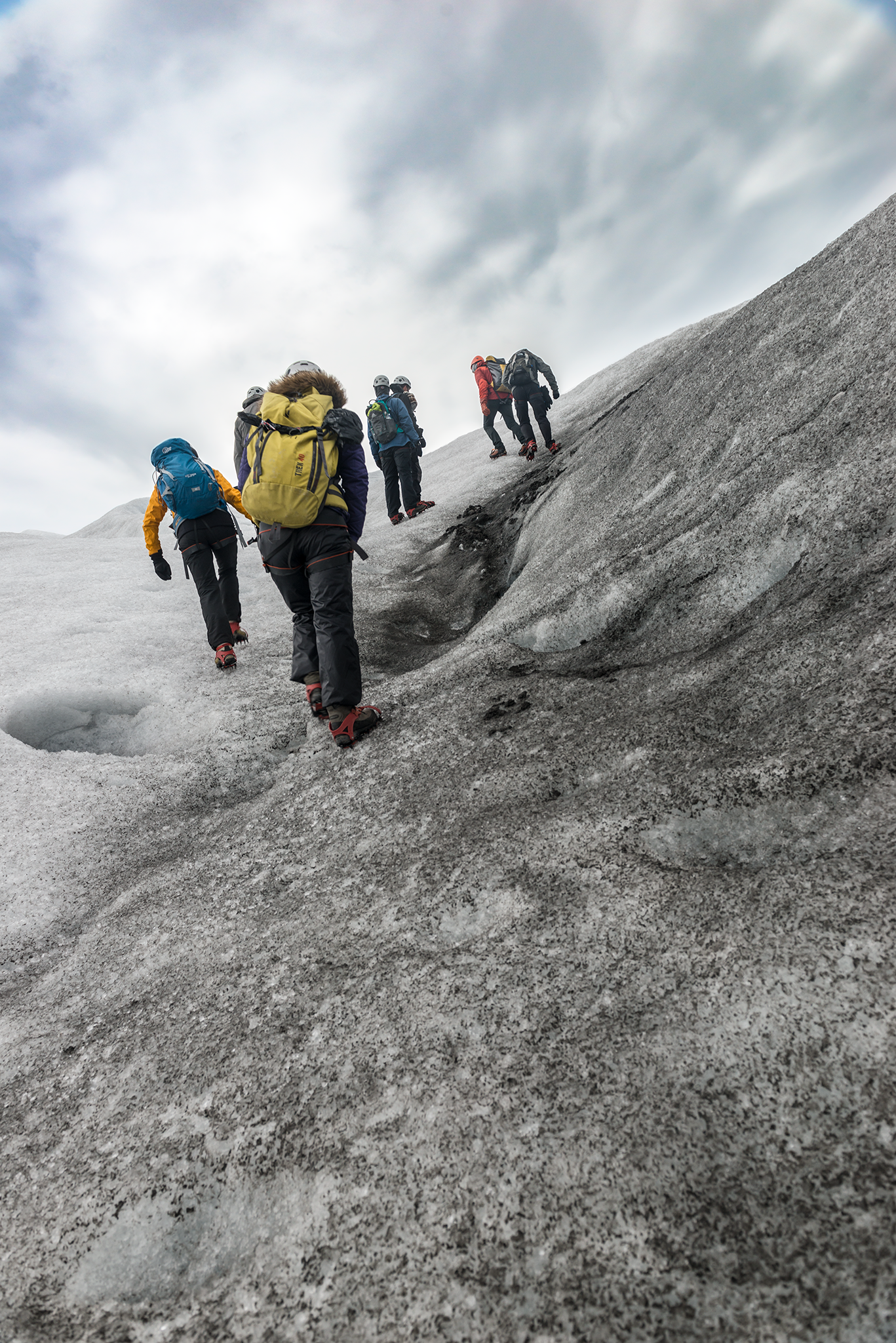
JJ takes us back to the camp where another group of Spaniards, these many more pleasant
and kind, explain that today they could not reach the glacier in the morning because it was all frozen and they could not even kayaking cause that was the day of the hurricane winds with all
the icebergs in the bay of Tasiusaq. Another young man explains that he could, because he booked a package that mixed bike and kayak. They’re are Basque. As always after
an experience the group dines with laughter accompanied by the roar of the waterfall that is just behind the camp ... and something else. The impressive thunders sounds of the glacier breaking
that seem to want to open the earth in front of us. Light rain, deadly ice enemy. The new foahn that has risen and the rain will test the resistance of our domes. They are comfortable.
For the first time I learned the lesson and asked Jonathan to sleep on the bunk above. The Basque navigator will be my sponge for the first time. Before sleeping furtive lights runned cross
the camp to the bathroom. In the background the dance of the shadows of the candles of the kitchens. The waterfall and the glacier have a hard contestant. Pera's lungs are powerful and shake
our tent until we fall asleep. My Basque navigator is now a Templar lying down on the upper bunk.
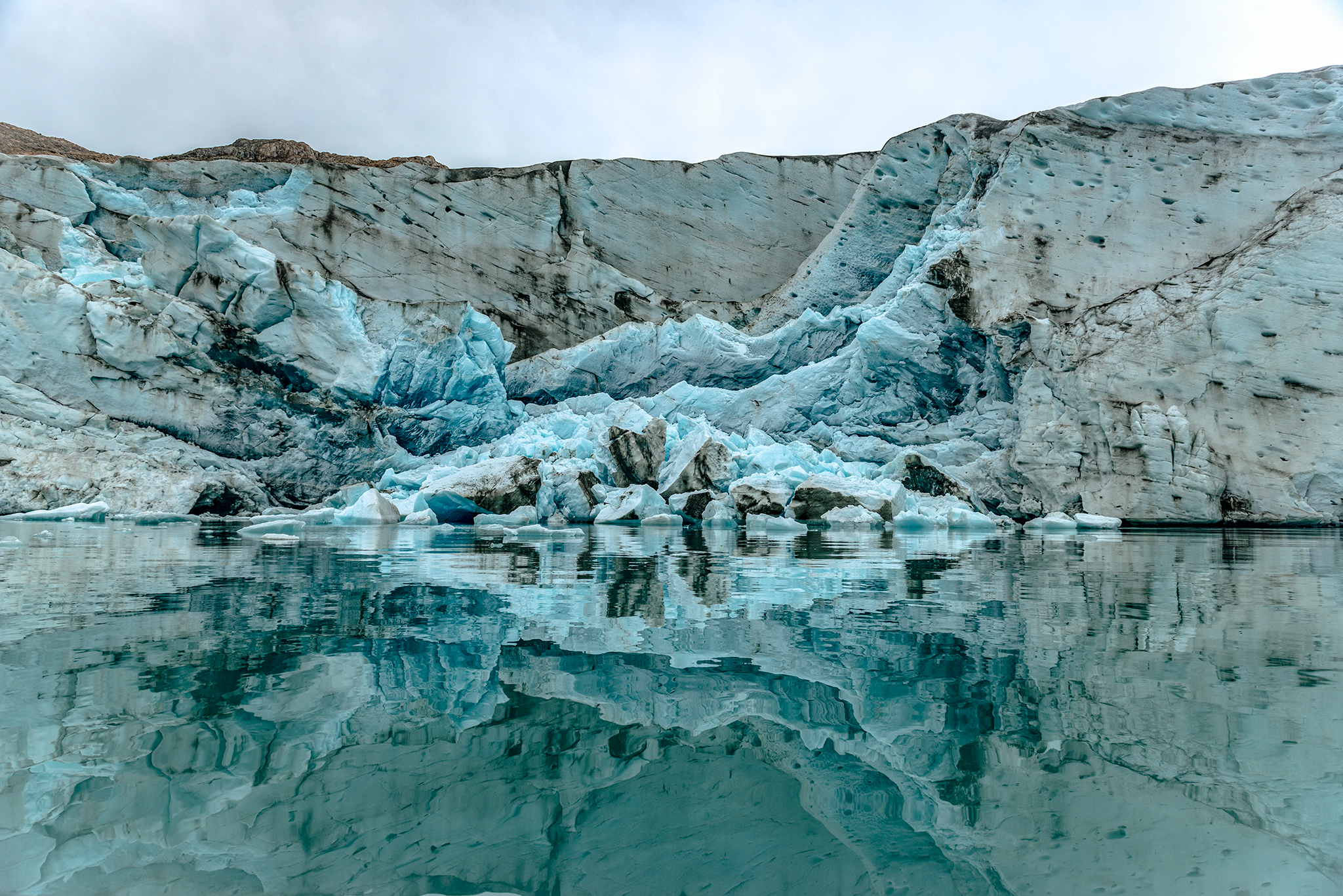
Thursday, 14 September 2017
A huge roar awakens the tent. The roar of the waterfall and the melting of the glacier seem to increase its volume. It has rained incessantly since last night and the day dawns without strong
winds. The gray sky and the fog do not let us see the glacier and we hardly see the profiles of small new icebergs that have gone to beach next to the edge of the fjord. There is no trace
left of them were floating yesterday. The expedition drowse in the tents and the arrival at the dome of the kitchen is delayed more than other days. Today our mission is to go on a quest
for caribou. The faces of the scouts are like the day. Today we will have smiling raindrops in the kitchen. The rain seems not only to break the glaciers. Nora, in the tone of voice who knows
that she only can obtain a negative response, proposes that despite the rain would be interesting to go to Lake Tasersuatsiaq, where the caribou tend to graze. The eyes are
centered on the tablecloth of the breakfast table ( Nanortalik's tablecloth has splendid Christmas drawings and I can't remember this one). We have to lift this situation. -“What time are we
leaving?” Nora's gaze changes: she already has accomplices in the rain. Eight expeditionaries will go to search for caribou, under the rain, thundering or to the end the world. We loaded with
light food and the hot water bins. Around 10:30 AM is easy to cross the waterfall that continues roaring and increasing its volume of water. We cross one of the rivers and we arrive at an
immense valley that divides green mountains in its left hillside and a moon landscape to our right. The rivers come down hard at the bottom of the valley, but we have not yet found a complicated
step for advancement. Starting the walk has made the faces change and they are the same again that we are accustomed to seeing each other every day. Dressing our waterproof clothes,
the jokes come back to accompany us in the valley. We are happy and the incessant rain continues. To the right we climb the hillside of the moon landscape to reach the plateau that once
occupied the lake ... and the caribou. Livestock and cervids in general tend to lie on the ground when it rains. If ruminants have the same habit, it will be difficult to see them.
The plateau we are in now is enormous. The weather starts to get worse at this point. In the bottom of the valley the walls protected us enough from the wind. In the plateau the rivers go
down to the lake flowing strong. We stop. The width and depth are such that we can soak and the wind would snatch the body heat right in the middle of the hike. After several diversions,
advances, setbacks and alternative ways of fording the river for reaching the lake, there are only two options: comeback to the ice camp or ... With a look and without speaking any word
someone takes a giant stone and throws it on the middle of the river. The group breaks down laughing. We have a new game: build your own bridge and, in addition, it will make us warm
(at the same time we show that neither rain nor elements can overcome the absurd idea of advancing to the unknown). On no less than three occasions we set up our makeshift bridges and moved on.
Pedro crosses the river the first and builds the bridge from the other shore. Jonathan will do the same too. Thus, between river and river, we arrive at the lake. There is also no trace
of caribou, and we will only find fur on the way back. The rain has erased any trace of footprints. The lake is fantastic and the fog give it a mystical air. The water is not too cold.
After the team photo we return. Pera proposes to verify the theory of water surface tension and runs through one of the currents and by the result seems to work. The rivers have grown
and the force of the current causes large pieces of the shores to break off at times and causes the flow of the river to grow in front of our eyes. Near the end of the route Pedro loads
Lolo on his back to cross one of the last traps. At the end of the journey it seems that almost all of us are, on an equal conditions, with regard to wanting to keep an aquarium in each boot.
There remains one last obstacle: the waterfall that at this moment roars with more anger. We crossed slowly to the other side. On the other shore, the camp waits for us. We changed clothes
and turned the kitchen tent into the drying community clothes line. We turn on the heating that will be our particular totem to which we give to eat boots, socks ... it is insatiable and
every time requests more. As a precaution, thinking about the ice crampons, I carry a second pair of boots with me. I loaned the first couple to Pedro on the day of the glacier since
theirs had already done their work and had them secured with bridles. After lunch we spent the afternoon checking the trip with Nora, a map to the front and adoring Totem Shoes.
The evaporation of water causes relaxing effects. Pedro and Pera offer Spanish wine to raise the spirit. The rain seems to cease for a while. Our kitchen is now a huge clothesline.
We dined without caribou and the expedition is happy and satisfied. Nora verbalized in the lake what we all thought and inside the tent, at dinner, a first thought clouds my mind:
tomorrow we will sail to Qassiarsuk. Today will be our last night in the ice camp. In the darkness of the night three throbbing red lights languish in the dark.
What did the clouds hide these last two nights so that no one could contemplate it? Yes, it's a very special mood. The expedition returns to the tents to rest.
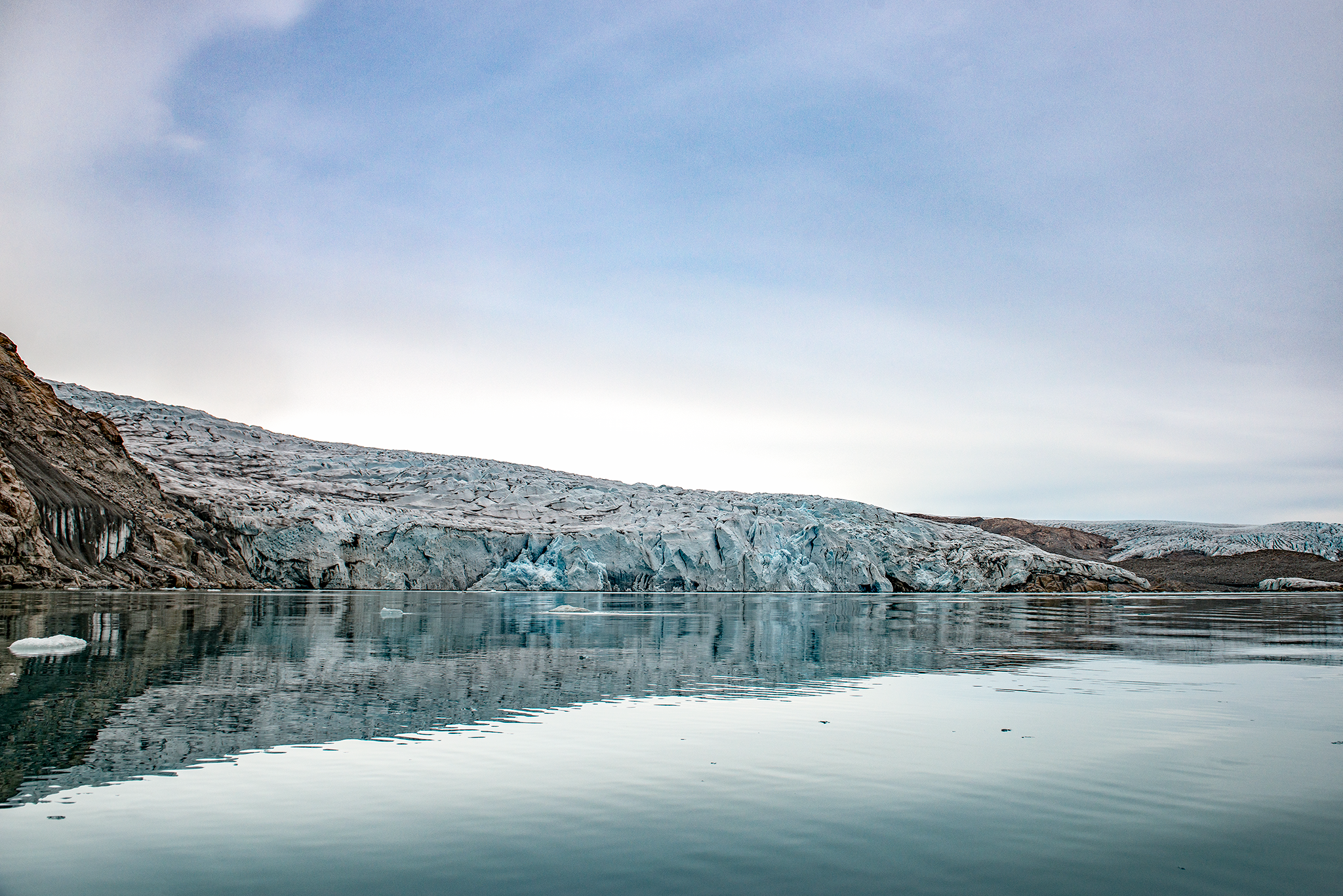
Viernes, 15 de Septiembre de 2017
Siguiendo la filosofía de los pájaros soltamos lastre antes de echar a volar. Último desayuno en Qalerallit y vuelta a preparar equipajes. Despedimos el wifi point decorado con
cornamentas de caribú y bajamos a la zodiac todos los pertrechos hasta el punto de embarque. Destino: Igaliku (antigua Gardar) y las ruinas de la casa del obispo
de Gardar, obra de la archidiócesis noruega de Nidaros (Trondheim, donde está la estatua del Santa Claus cabreado con una saco lleno de cabezas cortadas en la Catedral de Nidaros).
En la lancha todas las miradas se centran en popa: inmensos témpanos de hielo de un color verde esmeralda y con la transparencia de un diamante pasan ante nosotros por última vez. La singladura
también es corta: atracamos en Itilleq, una granja con una pequeña cabaña para dejar las parkas. Fondeamos en una bahía donde flotan plácidamente icebergs arrastrados por la
corriente desde el glaciar de Qooqqup, en el brazo de fiordo de Qooqqut y que desemboca en el fiordo de Tunulliarfik (El Ericksfjord).
El camino a Igaliku no tiene pérdida. A la izquierda están repoblando un bosque y el pimpollar avanza. Mientras caminamos encontramos vecinos en 4x4 y multitud de piedras que
sirvieron para la construcción de parte de las edificaciones que en su día formaban Gardar. Tras una breve marcha llegamos al pueblo y al hostel donde comeremos. Otro perrete
para incumplir la regla antirrábica y dejamos las mochilas en el porche para pasear por las ruinas del obispado. Se compone de una catedral en forma de cruz del siglo XII con 27 metros de largo
y restos de grandes graneros. La iglesia actual es blanca y azul. Un candelabro de 7 brazos que ya hemos visto en otras cabañas representan los 7 capitanes vikingos que se repartieron los fiordos.
En cada iglesia un barco con el cual llegaron cada uno de los expedicionarios. Tienen problemas de humedad y un fuerte olor dentro. Los libros de salmos están en groenlandés. Son luteranos
protestantes por lo que las imágenes se reducen a los propios párrocos y a iconos evocadores locales. Una caseta contigua a la iglesia hace las veces de tanatorio. Tras la comida viendo ovejas
y corderos pacer a su aire por el pueblo, reanudamos el camino.
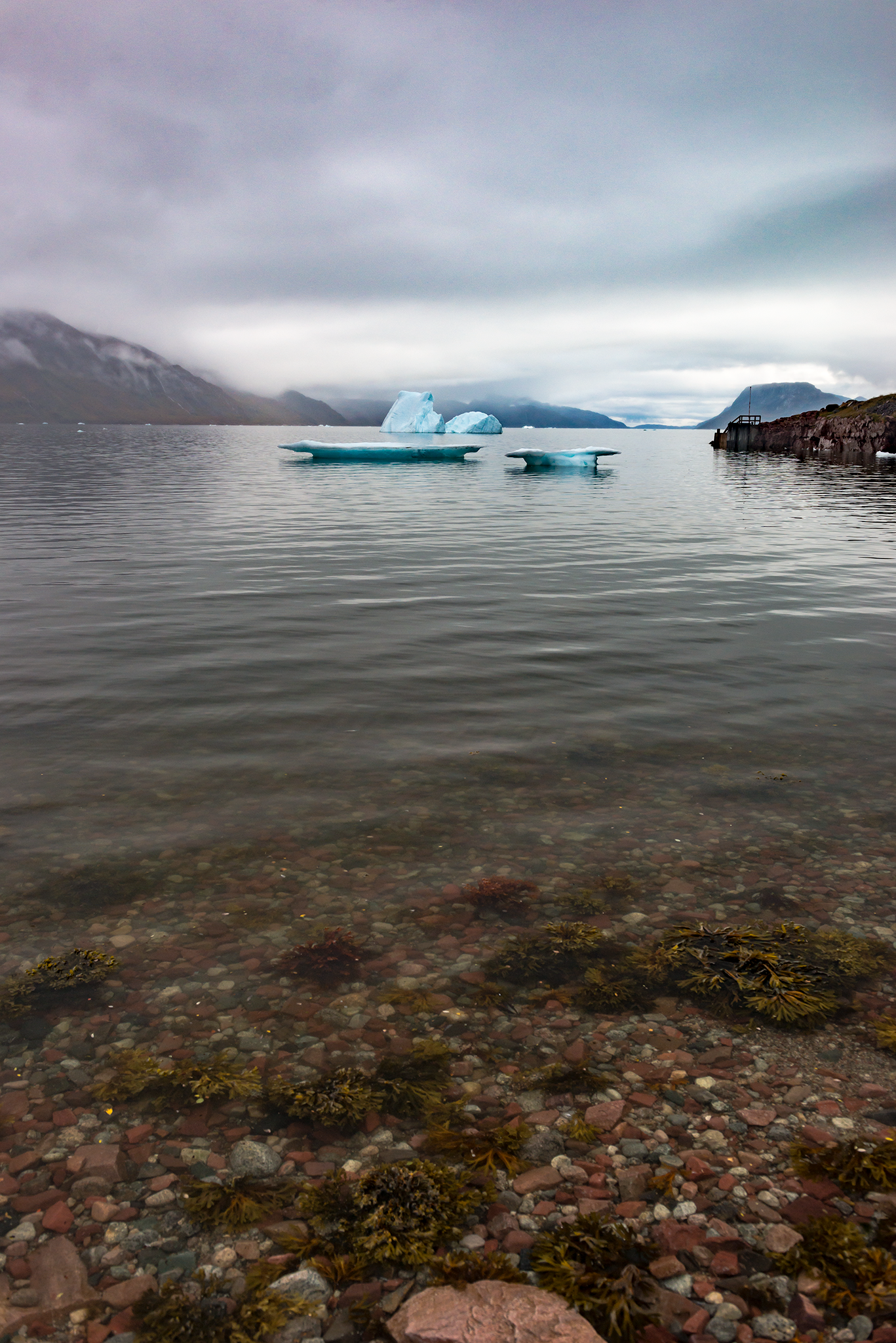
Al llegar a la bahía les pido a Nora y a Jonathan que posen juntos delante de los icebergs. Y Nora me devuelve el detalle.
Allí nos espera esta vez el Capitán Niels Sttender para llevarnos a Qassiarsuq. Al desembarcar, Niels clava los ojos en mi nikon y me dice entusiasmado que tiene mi modelo y
que usa una funda para sacar fotos subacuáticas mientras bucea. Un gran tipo este Niels. La noche la pasaremos en casa de Ramón. Volvemos a cargar nuevamente con los petates de vuelta al hogar
y allí nos reencontramos con nuestras maletas. Tras las duchas de cortesía, nos espera una cena de gala que si no me equivoco nos ha preparado Rafa, el cocinero del Leif Erickson.
La casa de Ramón es una vieja conocida y me siento feliz de no haber hecho noche en el hostel. Aquí estamos más a nuestras anchas y disfrutamos de la privacidad y el espacio que da un lugar
conocido. Conservo la impresión que me dio el primer día que puse un pie allí y al finalizar el viaje le agradecí a Ramón haber puesto su casa a nuestra disposición. Esta última noche el cielo
también está nublado. Mientras Pedro corre se trae de polizón a un cachorrillo que se queda dormido en el porche. Llega Nora con nuestra cena de Gala. Ensalada, Foca Seca, Pez Lobo,
Matalk, Ballena, Caribe, Foca, postre y.…whisky japonés cortesía de Marie. La foca seca se come con una sal amarilla especial. No está mal y repito dada la baja aceptación por
parte de los comensales. El segundo trozo está bastante más jugoso. Entre Jürgen y yo damos buena cuenta. El pez lobo sí causa sensación, tiene muy buen sabor. Ante la negativa a comer ballena
por razones de objeción de conciencia me hincho a grasa de ballena, que se come de igual manera que la piel de foca, acompañada por la sal. El sabor es suave y se presenta en el plato cortada
muy fina. La foca guisada tiene un fuerte olor y sabor a hígado y no agrada a todo el mundo. El caribú está preparado con salsa y el gusto es muy bueno y delicado. No es una carne especialmente
dura. Recuerdo el color y la textura de las piezas que estaba limpiando el cazador en Nanortalik y entiendo porque se lanzan a comerla seca y ahumada. Chocolates y bizcochos a los postres.
Agradecemos a Marie el whisky y la calentura extra de cuerpo que nos proporciona el brebaje. Nicola tiene un regalo de parte de todos para Nora. Repartimos besos y abrazos. Regreso al
laundry-bedroom tras hacer el change2change del petate verde a la maleta. Lolo se queda un rato con el cachorro y “en un descuido” el pequeño entra en la habitación comunal y se queda tumbado
en la alfombra. Fotos de cortesía y de vuelta a la calle. En el laundry-bedroom un nuevo Totem Shoes que, por temas de agnosticismo, pido a los dueños tengan a bien dejar en los
radiadores de los pasillos (ambiente húmedo, calor, fantástico caldo de cultivo de hongos…). Retorno a la litera con las mejores vistas del viaje. Y una vez más me quedo dormido con el arrullo
del generador que enciende la caldera con explosiones que se han vuelto con el tiempo un recuerdo imperecedero, como la camiseta verde con vida propia de Lolo.
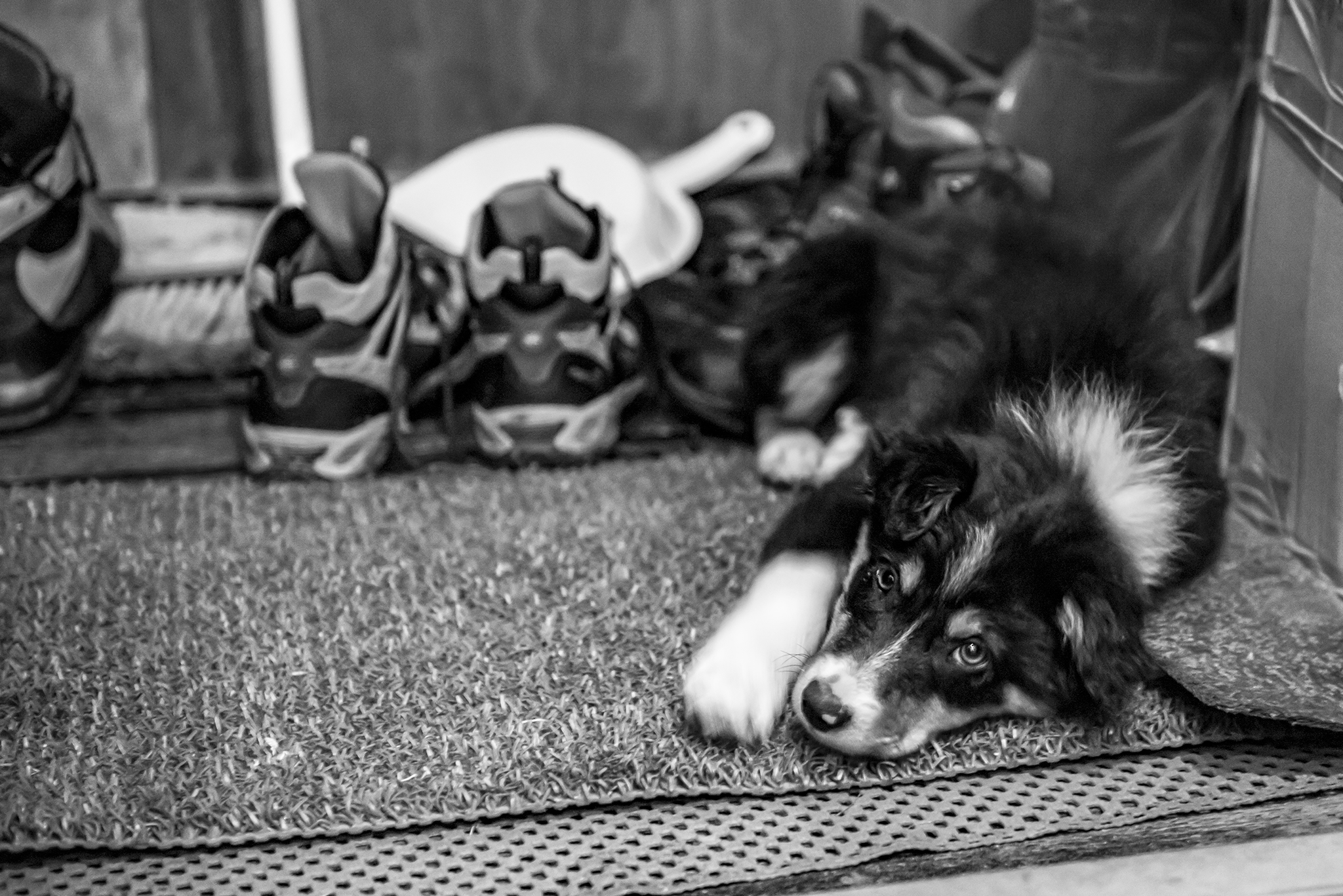
Sábado, 16 de Septiembre de 2017
Último desayuno en Qassiarsuq, en Ramón House…en Groenlandia. Mucho silencio. Recorremos el sendero hasta el hostel y junto con el grupo de españoles subimos a rendir honores a
Leif (nuestro nuevo amigo también le rinde honores a su manera). Hoy visitaremos las réplicas de Brattahlíð, el asentamiento vikingo de Erik el Rojo. En nórdico antiguo significa
“Ladera empinada de una roca”, la granja particular de Erik, fundada en el 985. Allí se construyó la primera iglesia del nuevo mundo, Djödhildarkirkja, en honor a su esposa
creyente Djödhilder y que fue la encargada de impulsar el cristianismo y convirtió a su propio marido, un reticente pagano, en su lecho de muerte. Al lado una granja de 53 metros de largo con un
suelo de losas planas y bancos de piedra. Para su construcción se usó incluso un omóplato de ballena, y allí sigue. Brattahlíð tiene la mejor tierra arable de toda Groenlandia y
tiene además un albergue juvenil. Un retablo representa la llegada de Erik, sus costumbres, drakkar y cuervos incluidos (los usaban para saber qué cerca estaban de tierra y aquí han evolucionado
haciéndose gigantescos). La réplica de la casa de Erik sirve como pasarela improvisada Prêt-à-porter Inuit. Pieles de caribú y pantalones de oso polar. El tiempo está embravecido
por momentos y a la salida de la casa comienza a llover ligeramente. Está claro que a Erik y Djödhilder no les hace gracia que nos vayamos.
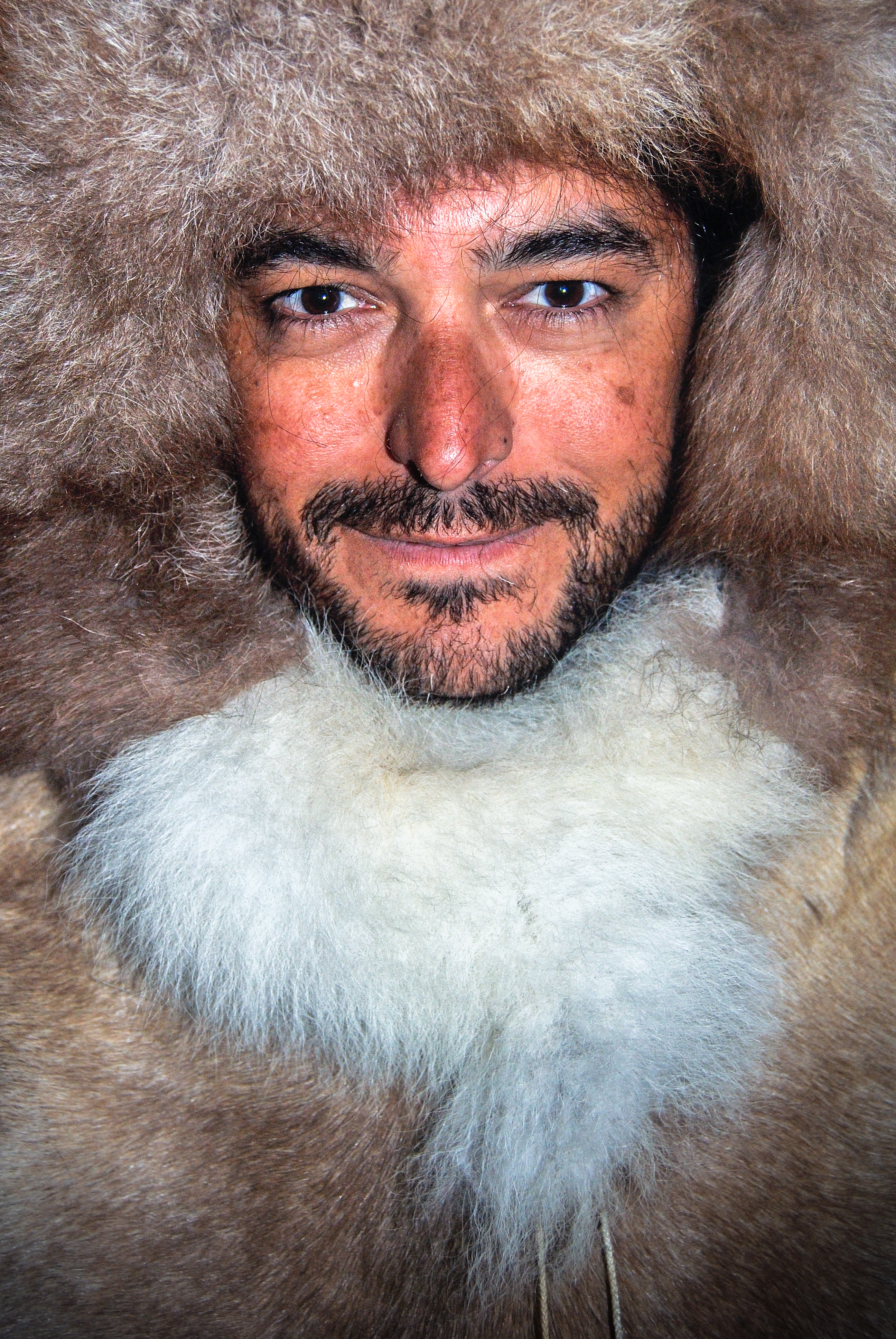
Un caballo nos observa desde una finca pegada al
sendero. Es hora de regresar a Ramon House y dejar preparados nuestros equipajes listos para el traslado al aeropuerto de Narsarsuaq ¿Es que nadie va a parar esta agonía?
¿En serio tenemos que irnos hoy? ¿Así? Hay un silencio mezclado por las prisas de no dejarnos nada en la casa. Antes de ir al aeropuerto Nora y Ajo nos tienen reservada una última sorpresa…
¿o será la penúltima? Durante la noche, mientras hacíamos la maleta, un español del grupo de expedición Pelayo entró en la casa de Ramón para buscar su maleta y no pudo encontrarla.
Mientras esperamos en el hostel nuestra sorpresa comemos la pasta que nos prepara Rafa y allí vuelvo a encontrarme con el expedicionario. Ya ha aparecido su maleta. Me cuenta que en el aeropuerto
todos los vuelos están cancelados. Nadie saldrá de Groenlandia hoy ¿Puede ser verdad? Aún no tenemos confirmación pero el murmullo del otro grupo no deja lugar a dudas. Cruzaremos hasta el pueblo
de Narsarsuaq y pasaremos la noche allí. Una pregunta corta la tensión ¿Hay bares cerca del aeropuerto?????? El silencio ha cambiado. Muchos del grupo perderán sus comunicaciones
con el aeropuerto de Keflavik, pero eso se resolverá a su tiempo. A la zodiac! Ajo nos recibe con una sonrisa. La travesía será para ver el fiordo Qooquut entre icebergs y
acercarnos lo máximo posible al frente glaciar de Qooqqup. Hace frío, una suave lluvia nos moja la cara pero a nadie le preocupa. Todos estamos centrados en llevarnos una última
foto inmortal de los enormes icebergs que campan a sus anchas en las frías aguas. El cambio de actitud sobre la lancha desde el primer día es notable. Ya no me preocupa el incesante traqueteo
del fondo de la zodiac con pequeños icebergs apenas visibles. Disfrutamos ese último paseo como niños. La suerte hace que esté sentado a la derecha de Ajo cuando acerca la zodiac a un iceberg.
Nora realiza una maniobra que nos deja a todos perplejos. Se dedica a cortar trozos de hielo con el piolet y los recoge en un cubo ¿Recogida de muestras para análisis científico mediante
espectrómetro de masas? ¿Experimentos para el estudio de la composición de la atmósfera hace miles de años? Miro a Ajo y sonreímos…BLUE MARTINI TIME!!!!! Nora se acerca con el cubo y me dice: “Carlos,
vas a ser mi ayudante”. Me da unos vasos de metal y poco a poco picamos el hielo del cubo para llenar los vasitos. Repartimos a toda la barca excepto Ajo, que saca una botella parecida a Sprite,
para brindar con nosotros. Carcajadas, fotos divertidas, momento inolvidable en la mejor compañía ártica.
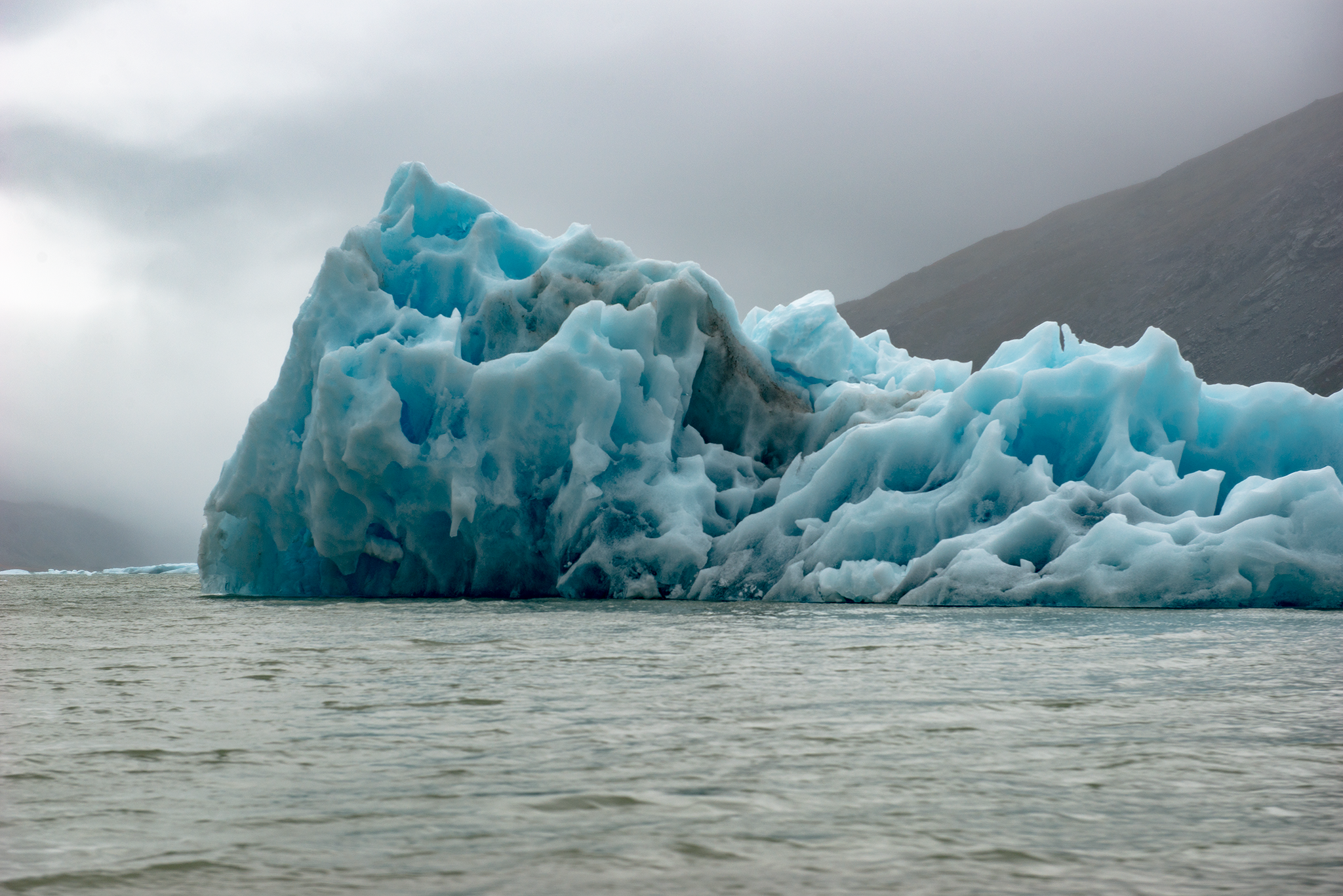
En el Leif se confirma la noticia. No habrá vuelos a Islandia ¡Gracias Sila,
te debo una! Una noche más para todos en Groenlandia y digo todos porque en el hotel de Narsarsuaq coincidiremos todo el personal visible de la isla. Esperamos en la caseta
la llegada de nuestro transporte. Una vez Ajo atraca en el embarcadero, descargamos las maletas. Mientras aseguro mi life vest no me doy cuenta de que mi maleta no está. Se lo comento a Rafa
y me dice que estará en la lancha, que no me preocupe, que la furgoneta está vacía. Será en el puerto de Narsarsuaq donde al hacer el último change2change agua-tierra,
confirmaré que mi maleta se quedó en Ramon House. Se lo comento a Andrea y a Ajo mientras Nora está ocupada con el toyota y el remolque. Ajo me sonríe y me dice “¿Tienes el pasaporte ahí?
Entonces…¿qué problema hay?”. El tío es socarrón hasta en el último momento. Andrea toma nota y al llegar al hotel se lo comento a Nora, que está atacada con las reservas, los cambios de vuelo
de los diferentes transfer…No pasará una hora cuando Ajo regresará con ella y la dejarán en el hall del hotel. Nora me avisa. Sonreímos y le doy las gracias. Ahora toca las reservas. En un primer
instante parece que están hasta arriba, pero nuestra dupla PP consigue presionar para que al menos diez de los expedicionarios no tengamos que irnos a un hostel un poco más lejos. Serán Nicola
y Marie los afortunados. Nos acomodamos y vamos directamente al comedor para cenar. Allí está también media isla. Capitán Niels con Jørgen y Ajo. El grupo de canadienses frecuentabares y varios
grupos de españoles. Tras la cena, que devoramos como si fuera la última de un condenado a muerte, y las múltiples cortesías de mi compañero el navegante vasco, esperamos en el hall charlando
animadamente de la hora de apertura del bar del hotel …y la que nos interesa del verdad…la del bar de Narsarsuaq! En una mesa Ajo charla animadamente con un hombre de aspecto
europeo. Cuando me ve, pregunta si he visto mi maleta y tonto de mi caigo en la cuenta que se ha tenido que volver solo por equipaje. Le digo que espere y le arreo una cerveza de agradecimiento
que él acepta con varias gracias. Luego le echo la bronca por no llevar la camiseta del Real Madrid y llevar la del United. Agradezco nuevamente el gesto y me despido de ellos. El compañero es su
primo. Es el puto amo del fútbolin. Ajo en cambio hace trampas. Mientras las guías se preocupan de arreglar las conexiones de los vuelos pasamos el rato en el bar. Hora de partir hacia nuestra
última fiesta. El último bar. A menos de 10 minutos andando rodeando en la oscuridad de la noche una fachada pintada con la última cena inuit llegamos al garito. Aún es pronto y está medio vacío.
No tienen internet esa noche por lo que el pago con tarjeta está condenado. El obligatorio escenario con instrumentos, una pista de baile infantil, un futbolín y una sala de billar con dardos.
Recordamos viejos tiempos como portero de futbolín con el mismo resultado y aún peor como jugador de billar….terrible. Las bolas son más pequeñas y los agujeros también ¿O son las cervezas?
A las 07:00 AM tenemos que facturar y a las 00:45 h sigo de charla con dos nuevos colegas fumando en la entrada del bar. Son de mi quinta y a uno le preocupa terriblemente porque se le han caído
los dientes, como a la mayoría de sus amigos, antes de cumplir los treinta. No puedo darle una respuesta concisa pero el colega animado me pregunta qué es lo que más me gusta de Groenlandia.
Sin dudarlo contesto que tienen paisajes maravillosos, noches espectaculares pero si en algo pueden presumir es en la naturalidad y la amabilidad de la gente. Tienen duende. Vine a Groenlandia
por todo lo anterior pero si algo se queda para siempre es encontrarme a mí mismo en cada una de las caras de los groenlandeses que tuvieron a bien ponerse a charlar con un español con unas pintas
muy raras. Hay quien les considera el pueblo más feliz del mundo, tal cual. El tío pone cara de orgullo y agradece veinte veces el cumplido. Al día siguiente estará al pie del avión trabajando
y nos despediremos por segunda vez. Su colega lleva una camiseta del Barcelona y bromeamos con Neymar. ¿Neymar, who the hell is Neymar? Puedes imaginarte por quien la lleva…Laudrup sigue siendo
Laudrup 20 años después. Durante las noches de bares, en cada uno de los garitos me encontré con un danés dicharachero con el que compartía un minuto al día fumando. Allí estaba también.
Y al día siguiente echaríamos unas risas en el fumadero del aeropuerto de Keflavik. Hora de regresar al hotel y dejar preparada la maleta. El hotel es obra de los americanos. Compartiré una última
vez habitación con el navegante vasco. El sueño ártico termina. Fuera lluvia fina y vientos suaves ¿Y si mañana fuera el primer día de mi sueño ártico?
Domingo, 17 de septiembre de 2017
Suena el despertador. Son las 06:30 AM. Últimos arreglos a la maleta y salimos hacia el aeropuerto. Pedro y Pera salieron pronto para facturar y volver a desayunar sin prisas. Un paseo de 2 minutos
y estamos en la cola. Mientras esperamos rellenamos la encuesta a Nora. De vuelta al hotel y desayunamos. La vuelta al aeropuerto es lenta, una última caminata disfrutando de los colores del otoño
que pueblan ahora las laderas de Narsarsuaq. Comienza la despedida delante del puesto de control. Nora dedica a cada uno unas breves palabras. Parece que hemos pasado juntos un
año y el adiós se hace triste y alegre a la vez. “Adiós Heidi, te voy a echar de menos”. Por tres veces no la dejo escapar y le suelto tres abrazos. Me ha aguantado dos semanas y no la he visto
quejarse ni un minuto… y para eso hay que estar hecho de otra pasta. En nuestro avión aterrizan nuevos expedicionarios para ocho días con Nora. Los ojitos le brillan. Hoy harán el valle de las mil
flores…hoy comienza todo de nuevo. Hora de pasar el control y embarcar destino Islandia. A mi lado Fran y Jürgen. Elijo So long, Marianne de Leonard Cohen para despegar de
Groenlandia con el beneplácito de Fran, hasta que Sila me mande otra señal de reencontrarme con su paraíso de hielo. Hasta que Sedna me llame porque ha llegado
el momento de que le peine de nuevo.

Anotaciones finales.
El sueño se desvanece y ya no será el mismo sueño. A la llegada a Keflavik, Marie y Nicola serán los primeros en partir. Luego Fran, Konrad y Jürgen. Más tarde Pedro y Pera tras ayudar a Jonathan
con los vuelos. Chris estará un par de días más en el aeropuerto. Lolo, Stephane y Jonathan volarán juntos a Paris. A última hora Airberlin decide cancelar mi vuelo y tras hacer la cola de
facturación ordinaria y convertirme en damnificado de checkin preferente, me largan con un vuelo una hora antes del de Berlín a Dusseldorf, con conexión directa a Madrid. Pasado el control un
último brindis. Son las 00:10 h. Adiós Lolo, adiós Jonathan.
Durante las dos primeras semanas al regreso a Madrid me despierto durante las noches totalmente desubicado y preguntándome ¿Dónde está el resto de la gente?
Friday, 15 September 2017
Following birds' philosophy we release ballast before flying. Last breakfast in Qaleralliq and return to prepare the luggage. We said goodbye to the only plug of the camp and
the wifi decorated with caribou antlers and loaded all the supplies to the point where JJ awaits us with the boat. Destination: Igaliku (previously known as Gardar
) and the ruins of the Bishopric of Garðar, work of the archdiocese of Nidaros (Trondheim, where the statue of a Santa Claus is angry with a sack
full of cut heads). On the crossing all eyes are centered aft: the immense icebergs of emerald green ice and with the transparency of a diamond are behind us for the last time. We travel
in a short time, heading SE. We arrived at Itilleq, a farm with a small hut to leave the parkas. We are in a bay where the icebergs float placidly drawn by the stream of the
Qooqqup glacier, in the arm of the Qooqqut fjord and ending in the Tunulliarfik fjord (The Ericksfjord). Pleasent 4 km road to
Igaliku named Kongvegen, King’s Way in Danish.

To the left they are reforesting and saplings grow up. While we walk we find neighbors in 4x4 and a
multitude of stones that served for the construction of part of the buildings that in its day formed Gardar. After a short walk, we reach the village and the hostel where we will eat.
There we found another dog to break the rabies rule and leave the backpacks on the porch to walk through the ruins of the bishopric. It is composed of the Cathedral of Saint Nicholas in the
form of a cross of the XII century with 27 meters in length and remains of large barns. The current church is white and blue. A seven-branched chandelier I've seen in other houses represents
the 7 Vikings captains who arrived in the Greenlandic fjords. In each church there is a ship representing the vessel in which the vikings arrived. It has moisture problems and a strong smell
inside. The books of salms are written in Greenlandic language. They are Lutherans, so the images represent the priests themselves and the traditional evocative icons of the place.
A cabin adjacent to the church is used as a funeral parlor. After lunch we see lambs and sheep grazing in the village and we resume the road. Upon reaching the bay, I ask Nora and Jonathan
to pose together in front of the icebergs. Captain Niels Stretch will take us to Qassiarsuk. When we landed at our destination, Niels stares at my Nikon and tells me that
he also has my camera model. He tells me that he uses a waterproof case to take underwater photos while diving. We will spend the night at Ramon's house again. We carry the green bags back to
the house and there we find our cases.
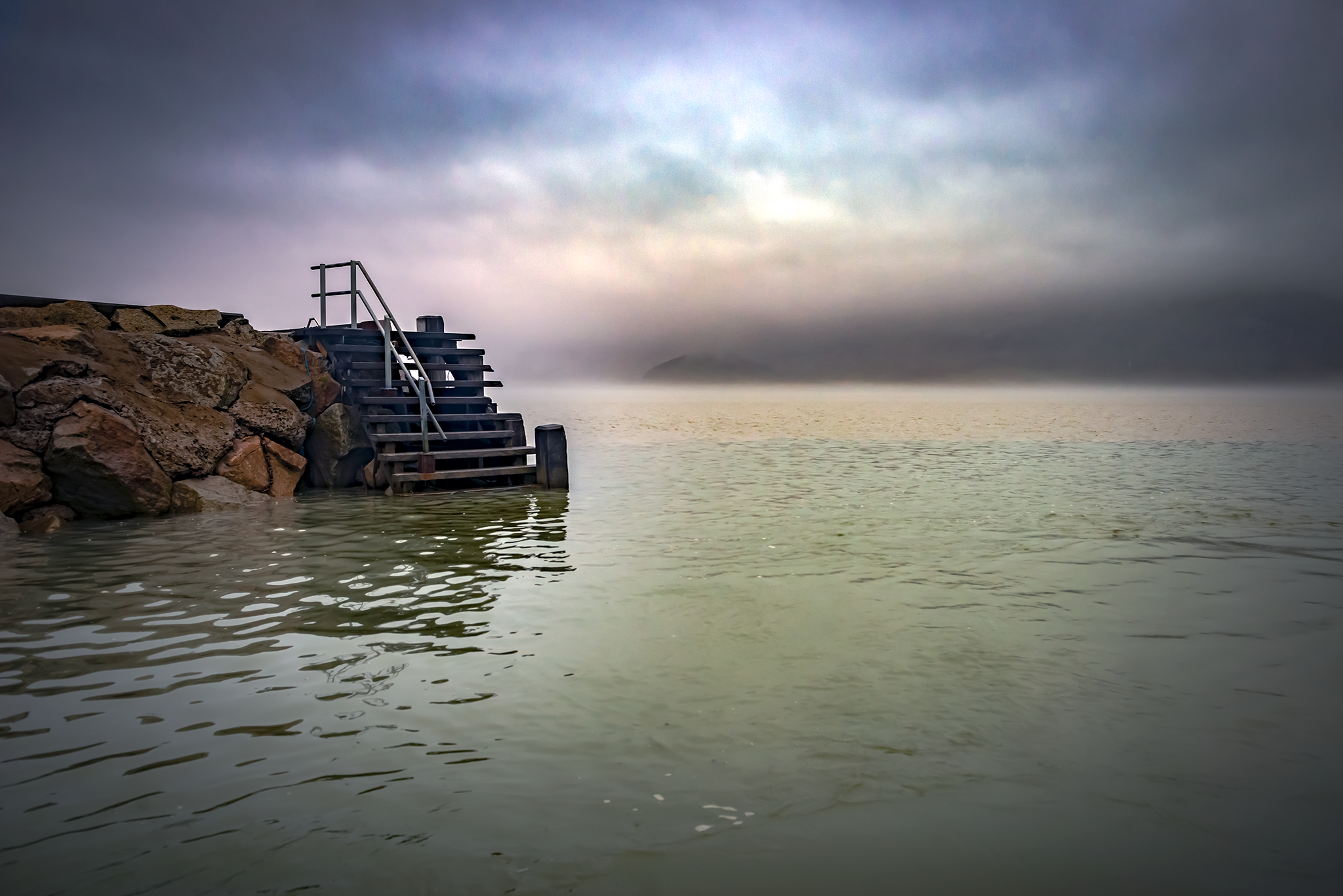
After the courtesy showers, a gala dinner awaited us, which, if I am not mistaken, it will be cooked by Rafa, chef in Leif Ericson. Ramon's house is an
old acquaintance and I'm glad I did not spend the night in the hostel. Here we are in our air and we can enjoy of the privacy and the space that gives a known place. I have the impression
that he gave me the first day he set foot there, and when the trip was over, I thanked Ramon to put his house at our disposal. This last night the sky is also cloudy. While Pedro runs
he brings a stowaway: a puppy that stays asleep on the gateway. Nora arrives with our Gala dinner. Salad, Dry Seal Skin, Wolf-fish, Maktak, Whale, Caribou, Seal, Desserts and
... Japanese Whiskey courtesy of Marie. Dry seal skin is eaten with a special yellow salt. Not bad and I repeat it given the low acceptance by the diners. The second piece is much more grateful.
Jürgen and me take good care to finish it. The wolf-fish does cause a sensation, it tastes very good. Faced with the refusal to eat whale for reasons of conscientious objection I devour whale
fat, which we eat in the same way as seal skin, accompanied by salt. The taste is smooth and is presented in very thin pieces. The cooked seal has a strong smell and liver taste and does not
appeal to everyone. The caribou is prepared with sauce and the taste is very good and delicate. I remember the color and texture of the caribou pieces cut by the hunter in Nanortalik
and I understood why they went to eat it dry and smoked. Chocolates and biscuits for desserts. We appreciate Marie's whisky and the extra warmth that the brew provides us. With the collaboration
of the whole group, Nicola gives a gift to Nora. Hugs and kisses. I return to the laundry-room after making the change of green bag to suitcase. Lolo stays with the puppy for a while and
"in an oversight" the little one goes to the common room and remains lying on the carpet. Courtesy photos and back to the street. In the laundry-room they have set up a new
Totem Shoes and I ask the owners to pick it up and use the radiators in the hallway (humid environment, heat, fantastic fungi broth, agnosticism ...).
Come back to the bunk with one of the best panoramic views of the trip. And, once again, I fall asleep with the calm that gives me the generator ignites the boiler with explosions and that
over time they have become an imperishable memory along with the green shirt with own life of Lolo.
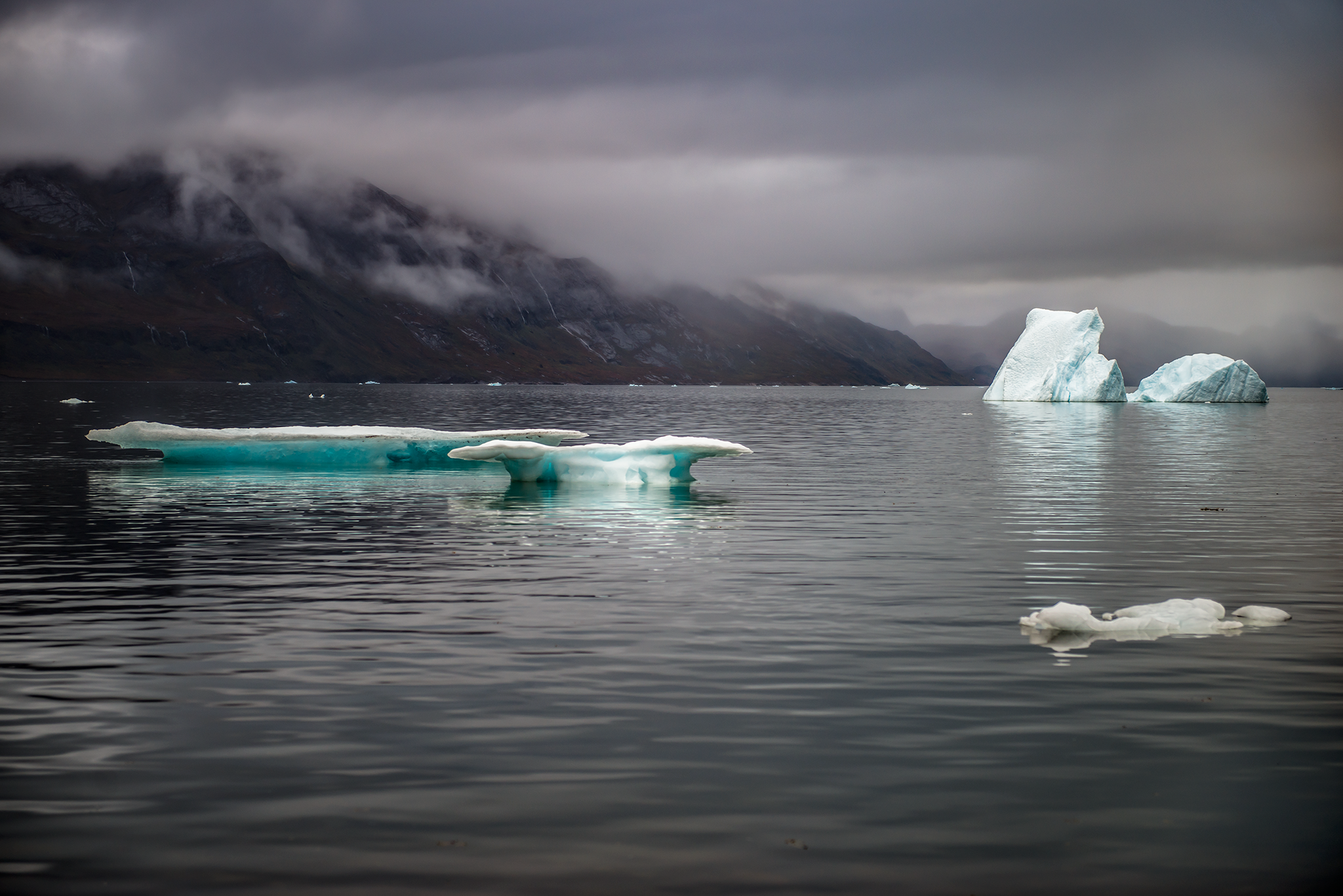
Saturday, 16 September 2017
Last breakfast in Qassiarsuk, at Ramon House ... in Greenland. Very quiet. We walk the path to the hostel and together with the group of Spaniards we honor Leif
(our new partner also honors his way). Today we will visit the Brattahlið replicas, the original settlement of Erik the Red, in old nordic means "steep slope of a hill",
Erik's private farm, founded in 985. There he built the first church of the new world named Þjóðhildarkirkja, in honor to his believing wife Þjóðhildur and
who was in charge of promoting christianity and turned his own husband, a reluctant pagan, on his deathbed. To one side, a farm of 53 meters long with a floor of flat slabs and stone benches.
For its construction was used even a scapula of whale, and you can find still there if the visitor looks with patience. Brattahlið has the best farmland in all of Greenland
and also has a youth hostel. An altarpiece represents the arrival of Erik, his habits, drakkar and even crows (he used them to know how they were close to the earth and here they have evolved
to become gigantic). The replica of Erik's house serves as a makeshift Inuit Prêt-à-porter catwalk. Caribou skin jackets and polar bear pants. At the exit of the house begins to rain slightly.
It is clear that Erik and Þjóðhildur do not like the expedition to leave today.
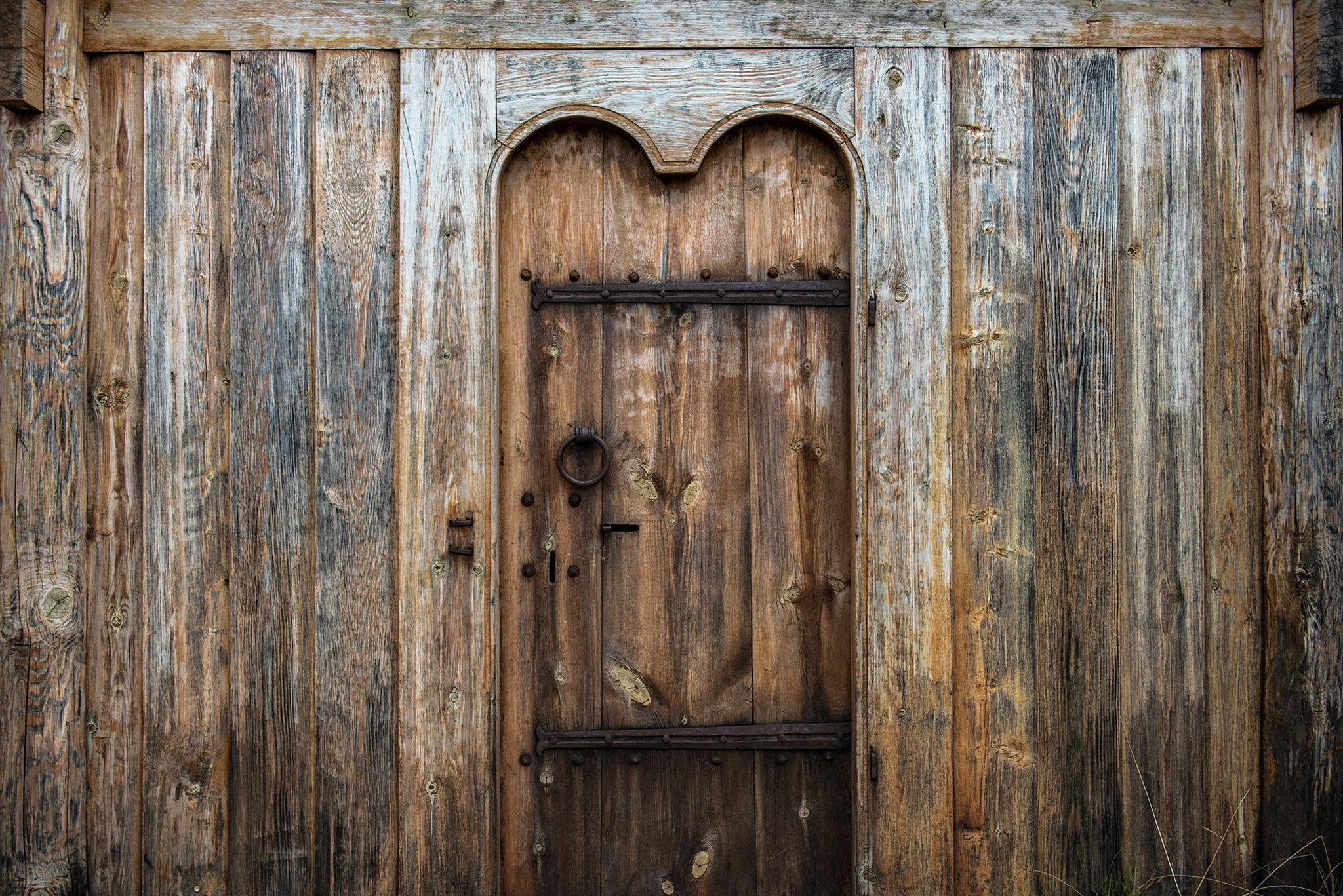
A black horse looks at us from the farm near the road. It is time to return to Ramon House and leave our luggage
ready for the transfer to Narsarsuaq Airport. Is no one going to stop this agony? Seriously, do we have to leave today? There is a silence mixed with the nerves of not leaving
us any luggage in the house. Before going to the airport, Nora has prepared us one last surprise ... or will it be the penultimate one? During the night, while packing, a Spaniard journalist
from the Pelayo expedition group entered the Ramon’ House to find his luggage and could not find it. While we wait at the hostel, I meet the journalist again. His suitcase has already appeared.
He explains me that all flights are canceled today. No one will leave Greenland, at least this night. It may be true? We still do not have confirmation, but the murmurs of the other group leaves
no doubts. We will cross the fjord to Narsarsuaq and spend the night there. A small question to break the tension Are there bars near the airport ?????? There is concern among
people. Many of the groups will lose their communications with Keflavik airport, but this will be resolved in due course. To the boat! Captain Ajo greets us with a smile. The crossing will be
to see the Qooquut fjord between icebergs and get as close as possible. It's cold, the gentle rain makes our faces wet, but nobody cares. Last immortal photo of the enormous
icebergs that roll their wide in the cold waters. The change of attitude in the boat from the first day is remarkable. I no longer care about the incessant rattling of the bottom of the ship
with little invisible icebergs. We enjoyed this last travel as children. I was sitting to the right of Ajo when he approached the boat to an iceberg. Nora does a maneuver that leaves us all
baffled. She cuts pieces of ice with the ice ax and collects them in a bucket. Collection of samples for scientific analysis by mass spectrometry? Experiments to study the composition of the
atmosphere thousands of years ago? I look at Ajo and smile ... Time for the Blue Ice Martini !!!!!
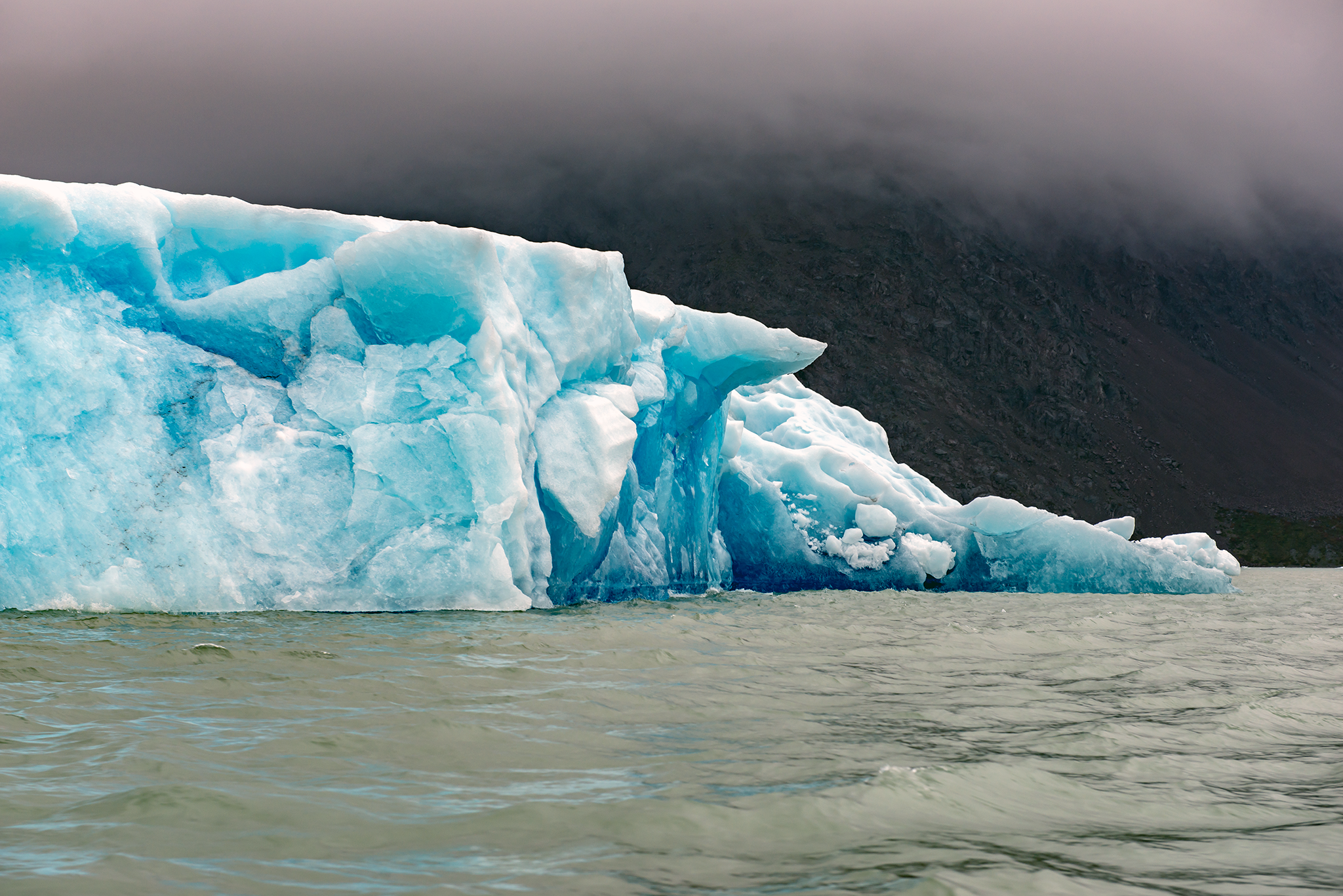
Nora comes up with the bucket and says, "Carlos, you're going to be my assistant." She gives
me some metal cups and slowly pokes ice from the bucket to fill the cups. We deliver to the whole crew, except Ajo, who pulls out a Sprite-like bottle to toast. Laughter, funny photos,
unforgettable moment in the best Arctic company. In Leif again the news are confirmed. There will be no flights to Iceland today. Thanks Sila! One more night for everyone
in Greenland and I say "everyone" cause we will meet all the visible staff of the island in Narsarsuaq Hotel. We wait at the house for the arrival of our transport.
Once again Ajo arrives at the pier and we load our bags. While I secure my life jacket I do not see my suitcase pass and I tell it to Rafa: he says me that they are all inside the boat and
I say goodbye to him. It will be in the port of Narsarsuaq where, when making the last change2change, I will confirm that my suitcase stayed in the Ramon’ House. I told it to
Andrea and Ajo while Nora is busy with the toyota and the trailer. The captain smiles at me and says "Do you have a passport here? So ... what's the problem?" The guy is sardonic even at
the last moment. Andrea takes note and when she arrives at the hotel she tells Nora ... it will not be an hour before Nora returns with her and leaves her in the hotel corridor.
I smiled and thanked him. Time for booking. At first glance they seem to be complete, but our PP party manages that at least ten of the scouts do not have to go to the hostel near the airport.
Nicola and Marie will be the lucky ones. Dinner in Narsarsuaq Hotel. There will also diner there half the population of the island. Captain Niels with Jørgen and Ajo.
The group of Canadians we met at the bars and various groups of Spaniards. After dinner, which we devoured as the last death row, and the multiple courtesies of my companion the Basque
navigator, we waited in the room for the opening hours of the hotel bar ... and what interests us the real one .. the opening of Narsarsuaq bar! At a table, Ajo speaks
animatedly with a man of European appearance. When he asks me if I have seen my luggage, I fall into the account and tell him to wait there sitting. On the way back I give him a beer of
thanks which he accepts with several graces. Then I scold him for wearing the Manchester United shirt. The partner is his cousin and is a fucking master playing the table football. Ajo,
on the other hand, cheats. While the guides are dedicated to arrange the flights connections. Time to celebrate our last party. Less than 10 minutes walking in the dark of night, we arrived
at a bar with the facade painted with the last Inuit dinner. 10:00 PM it is half empty. They do not have internet and we can’t pay with credit card. In the background a stage with musical
instruments, a children's dance floor, the table football and a billiard room with darts. I remember my past times as a goalkeeper with the same result and even worse 8-pool player ... Terrible.
The balls are smaller and also the holes. Or are the beers? 7:00 AM we must check in and it will be 12:45 AM when I am still talking to two new colleagues, all three smoking at the entrance to
the bar. They are my age, and one of them is terribly worried that most of his friends will lose their teeth before they turn thirty. I can’t answer him, but the lively asks me what opinion
I have about Greenland. Without hesitation I answer that they have wonderful landscapes, spectacular night lights, but in something they can boast of truth and it is the kindness of the people.
I traveled to Greenland for all the above, but I found myself in each of the faces of the Greenlanders who wanted to talk to a Spaniard dressed in very rare clothes. Some people consider them
the happiest people in the world. The guy looks proud and thanks me twenty times. The next day he will be working at the airport and he will say goodbye us a second time. His colleague wears
a F.C. Barcelona T-shirt and we joke with Neymar. Neymar, who the hell is Neymar? You can imagine the unique footballer he is interested for ... .Laudrup. Laudrup is still remembered 20 years
later. During bar nights, in each of the village halls, I came upon a very amusing Danish with whom I used to smoke in the street. It was also there and the next day we laughed in the smoking
area of Keflavik airport. Time to go back to the hotel and pack our luggages. The hotel was made for the US Army. This last bedroom I will share with the Basque navigator. The arctic dream ends.
Outside rains and gentle winds. What if tomorrow was the first day of my Arctic dream?
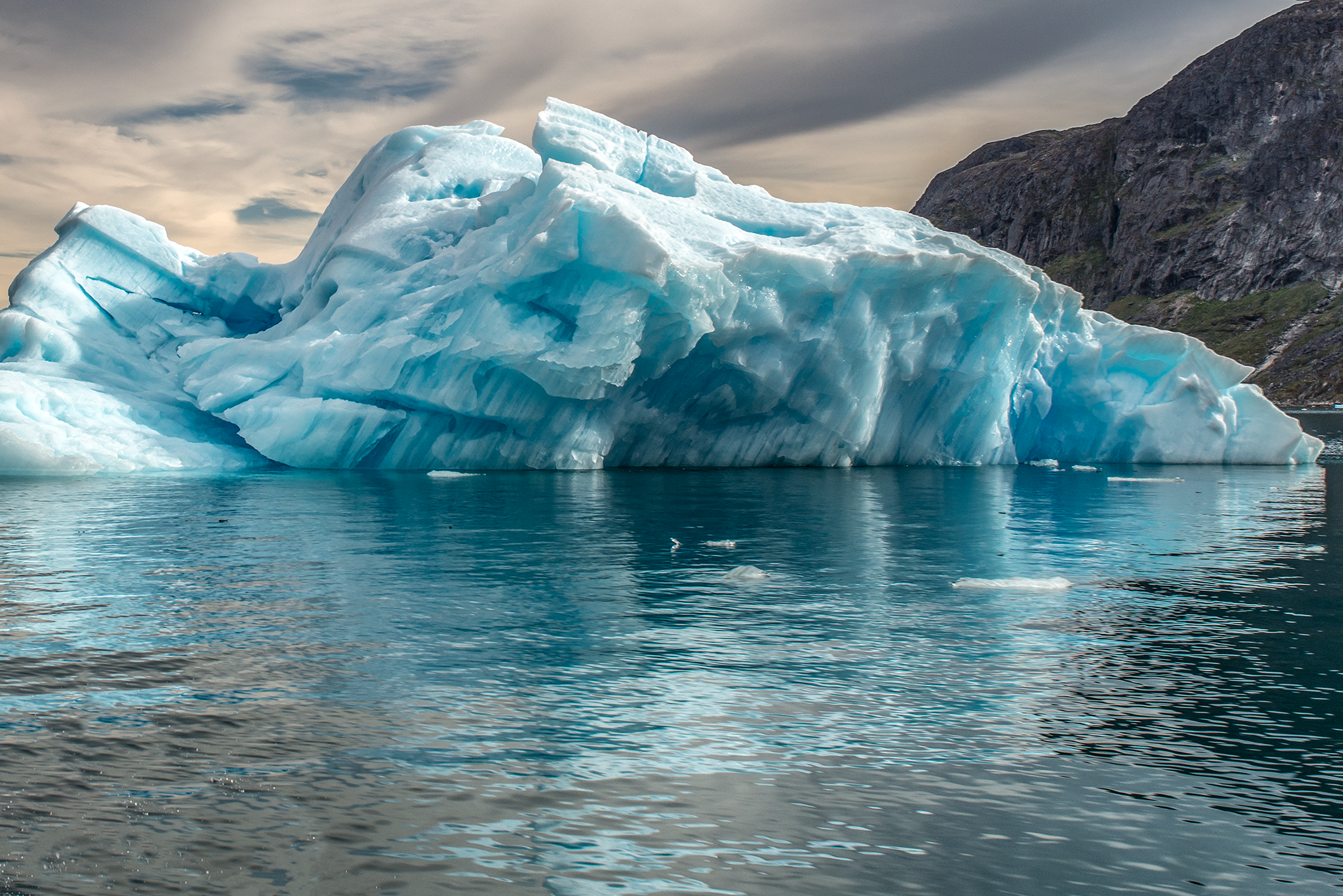
Sunday, 17 September 2017
It's 06:30 AM. Last arrangements in suitcases and we walked out to the airport. Pedro and Pera get up early to check in and have breakfast time enough. Two minutes walk and we are in the queue.
While we waited there we completed the survey of the trip to Nora. Back to the hotel for breakfast. The return airport is slow, to the last step enjoying the autumn colors that now dress the
slopes of Narsarsuaq. Start the farewell in front of the checkpoint. Nora gives us each one a few words. We seem to have spent a year together and goodbye becomes sad and
cheerful at the same time. "Bye, Heidi, I'll miss you." Three times I do not let her escape and I give her three hugs. It's been two weeks and I have not seen our guide complain a minute.
On our plane fresh meat land to start a new eight-day trip with Nora. Nora's eyes shine. Today they will go to the valley of a thousand flowers ... today everything begins again. Time to cross
the control and boarding the flight to Iceland. Beside me Fran and Jürgen. I choose Leonard Cohen So Long, Marianne to take off from Greenland with the blessing of Fran.
And so I left the white giant, until the time comes for Sedna to tell me that she wants me to comb her hair again.
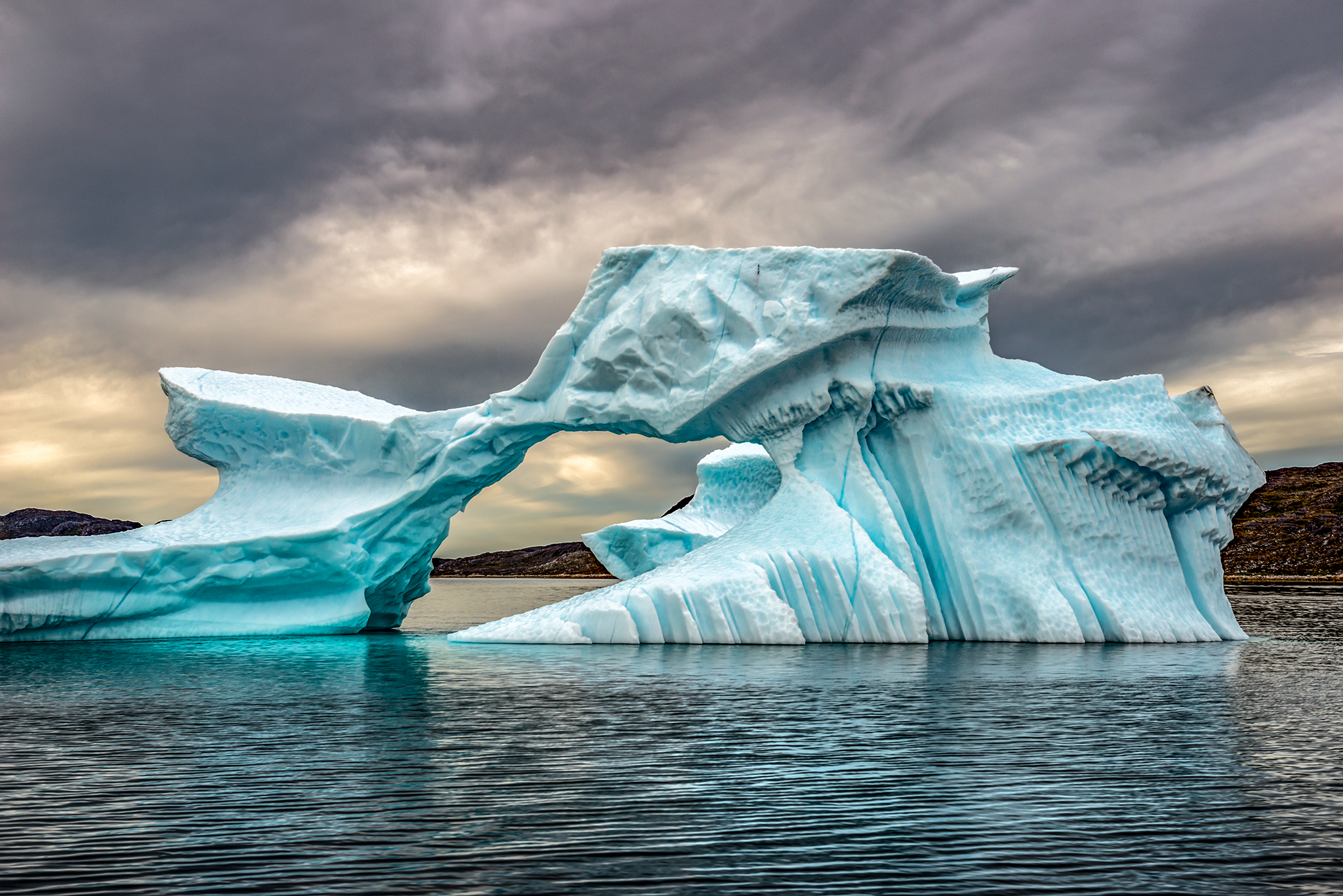
Final annotations.
The dream dissipates and it will no longer be the same dream. In Keflavik, Marie and Nicola will be the first to leave us. Fran, Konrad and Jürgen after them. Later Pedro and Pera after
helping Jonathan with the flights. Chris will be a couple more days at the airport. Lolo, Stephane and Jonathan will travel together to Paris. At the last minute, Airberlin decides to cancel
my flight and after making the queue of the preferential check-in, I'm going to Dusseldorf an hour earlier, with direct connection to Madrid. After passing the control together we make
a last toast. It's 12:10 AM. Bye, Lolo, bye, Jonathan.
During the first two weeks, once arrived to Madrid, I woke up during the nights completely out of place and wondering, where the hell is the crew?
